- English (EN)
- Español (ES)
- Português (BR)

Is Sao Paulo Safe? Crime Rates & Safety Report
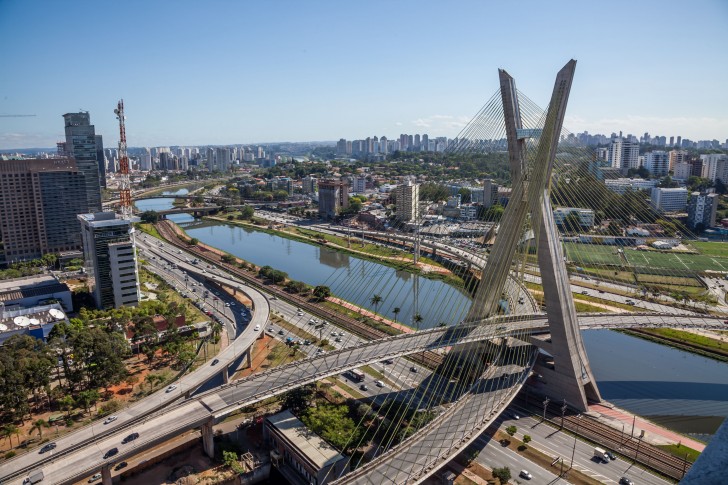
Brazil : Safety by City
- Belo Horizonte
- Florianopolis
- Porto Alegre
- Rio de Janeiro
São Paulo, the largest city in Brazil has a city population of 11 million and even more than 20 million in the metropolitan region.
Many immigrants used to be attracted to this incredible city, so it is one of the most diverse cities in the world.
Sao Paulo is the capital of rich people, nightlife and culture.
Although tourists who visit Brazil often prefer the beaches of Salvador de Bahia or Rio de Janeiro, Sao Paulo is surely a great tourist destination with its museums, restaurants or jovial nightlife.
Some of the must-see sights of Sao Paulo are the Neo-Byzantine Catedral de Sé, the Municipal Market and São Paulo Museum of Art.
- Warnings & Dangers in Sao Paulo
OVERALL RISK: MEDIUM
If you take into consideration all the possible dangers in Sao Paulo, it is an averagely safe city. As in any other city, some unsafe parts should be avoided, particularly at night.
TRANSPORT & TAXIS RISK: MEDIUM
Public transport in Sao Paulo can be considered unsafe. While the metro and buses are believed to be generally safe, buses and bus stops are risky, mainly at night.
PICKPOCKETS RISK: MEDIUM
Areas around Praca de Sé, the metro and bus, and train stations, as well as crowded zones, are the main locations of the pickpockets. Thieves also operate in markets and hotels. Caution is compulsory when traveling at night through rural areas since a few precautions will minimize the chance of being pickpocketed.
NATURAL DISASTERS RISK: MEDIUM
Some natural disasters, like the flooding caused by the heavy rainfall, which affects the mud to rush down the mountains and destroy the towns by knocking down houses are possible in Sao Paulo.
MUGGING RISK: HIGH
Mugging and kidnapping are very common in Sao Paulo particularly in urban areas where tourists are forced to take their money from ATMs and give it to the kidnappers to be released. The best solution to avoid the risk of being kidnapped during the night is to travel in a private car.
TERRORISM RISK: LOW
When the terrorism risk is concerned, Sao Paulo is believed to be a very safe city and it is marked as a low-threat location for terrorist activity.
SCAMS RISK: MEDIUM
Tourist places are locations where lawbreakers will try to scam you. In Sao Paulo, tourists should be extremely cautious around ATMs and avoid being surrounded by groups of teenagers with strange behavior or people who want to help them.
WOMEN TRAVELERS RISK: LOW
Women are generally safe in Sao Paulo and can walk alone through the city, but still, nights are extremely dangerous, so it is not always advisable for a female to find herself alone on empty and dark streets.
- So... How Safe Is Sao Paulo Really?
Brazil is the country that has some unsolved issues with crime and that continues to be the principal danger to its visitors.
Fortunately, the crime rates are decreasing especially in Sao Paulo being a great tourist destination.
The Westside of Sao Paulo is a center of business, nightlife, and education, and it is safer than other parts, being the city’s richest area.
The police presence around Praça de Sé in the old city center makes this area safe, unlike the Crackland area near the Parque de la Luz that needs to be completely avoided by tourists due to the appearance of the drug addicts, prostitutes, and criminals.
Some areas are very dangerous for travelers as well as the citizens of Sao Paulo since robbery, assault, burglary, and theft happens at all times of the day.
Violent crimes like murder, rape, and kidnappings are attributed to street gangs and organized groups and they are not very frequent.
Regardless of all these dangers, Sao Paulo should not be taken as a city to be avoided.
Quite contrary, it is a great city to explore, with its world-class restaurants and major cultural and historical attractions, as long as you remain vigilant while touring the city.
- How Does Sao Paulo Compare?
- Useful Information
Tourists from the US who want to visit Brazil have to pay a 160$ fee to get the visa. However, some other countries do not need visas if it is less than 90 days visit. Travelers can check the official Brazil tourism website to get information about visas.
Brazil’s official currency is the Brazilian Real (R$). Even though Brazil is one of the most expensive countries in South America, it is considered a relatively cheap tourist destination.
Sao Paulo is the city that can be visited throughout the whole year because winter temperatures range between 8 and 21 °C. The record high temperature was 37.8 °C and the lowest −2 ° C. Because of its elevation, Sao Paulo has a temperate climate.
There are two main airports in Sao Paulo, São Paulo–Guarulhos International Airport and Congonhas-São Paulo Airport for domestic flights. The number of air passenger movements makes Sao Paulo one of the top 15 busiest airports in the world. Other alternative airports are Viracopos-Campinas International Airport, São José dos Campos Airport and Jundiaí Airport which can be used to avoid the crowds.
Travel Insurance
When traveling anywhere in the world, accidents and illnesses cannot be predicted. So when traveling to Sao Paulo, it is suggested to have international travel health insurance as well as the insurance in case of theft and loss of personal items.
Sao Paulo Weather Averages (Temperatures)
- Average High/Low Temperature
Brazil - Safety by City
- Where to Next?

35 Reviews on Sao Paulo
I am from middle east. will they think i am a tourist when im there? cus my skin color is likely the same as brazilian people
You will love Brasil
Once you speak, they will know you are a tourist. I have been to Sao Paulo and trust me, the people are great. They are friendly and very helpful. They look upon it as an honour you are visiting their country and they are proud of their country. There was no racism or anti colour feeling there that I saw. You will love the place.
People are not helpful if your skin is brown or darker, just don’t go. This review is simply not true.
São Paulo is a great city
I spent a year in São Paulo in the Jardin neighborhood. Walked all hours of the night and never had an issue. In other areas of the city, of course, there are problems.
Stay at the Renaissance off Paulista it’s a great safe neighborhood as much as a big city can be safe.
Many places such as rio de janeiro and sao paulo are majority white so no
Brazilians minimize everything
They are not. Brazilians love to say that but it’s simply not true. I’d say in SP people are around 30-35% fully white. Then you get around 40% who are mixed and brazilians call them(selves) white but they wouldn’t be classified as white in North America (or even in Australia). Finally, the rest are simply not white and not mixed.
Yes, we will, plus you’re not welcome.
Nice brudda. How interesting. thanks for sharing bro. Thanks for letting me know. Thanks for sharing info. I got knifed in the back of the head bro. Rip bro.
Some guy shot at but I dodged the bullet so you’ll probs die
My opinion about São Paulo
As a Brazilian I would say that São Paulo is a melting pot (I myself am descendant of Japanese) and you may be mistaken at first for a local. However, racism is present and if you come to São Paulo you’ll notice that if you go to nice and rich neighborhoods the majority of people you will find there will be white. Sadly, it’s true that if your skin color is brighter you will be treated better than someone with darker skin. It’s not always, but it happens a lot. Last but not least, just to align expectations, let me tell you that São Paulo is just a very large city, good for business, qirh nice restaurants, but not full of nature as some foreigners would expect of any Brazilian city.
It really depends
It’s alright, São Paulo is safe is certain areas but if you’re in a sketchy looking place, then trust your gut.
It's a great city
I was born in São Paulo and still live here. I am 30 years old and have never been mugged, stolen or suffered any kind of violence. I’m not saying that it doesn’t happen here, but it changes a lot from one place to another. If you are going to tourist places, just be aware of your surroundings and don’t be too naive. Streetwise is a differential.
Beware brazilians opinions
Stop lying mate, you know your city is only safe compared to Rio which is one of the most violent places in the western hemisphere.
Kidnapped, tortured, made homeless and robbed
He is lying: when I was in Sao Paulo I was kidnapped in a fake hotel by people that either were or were linked to terrorists, tortured by the police who used pharmocological torture. I had my computer stolen, bought another had this one stolen, had my phone stolen: when kidnapped. I also had my passport stolen at knife point in GRU airport, and had to go effectively homeless because I could not discern how to make sure any hotel was real and not for kidnapping. When I got back to the airport the people that I had my flights with would not let me use their phone to call my embassy. Instead they said they would call but would not because obviously as a white British westerner I somehow am at fault that their country is not a first world country. I ended up in the airport for almost a month. Its an extremely dangerous country which In say people should avoid at all cost.
Well, if it's true it wasn't your day!
I’m Brazilian although the country isn’t safe at all your story sounds phony. Sorry, it’s too “fantastic”, almost a psychological thriller by David Lynch.
Golden rule
The golden rule is to exercise caution when walking on streets or other public places. Even during the day. Do not stop to talk with strangers who come with some persuasive talk or some ordinary question. By night, avoid nearly any street walking, with the exception of crowded restaurant and bar streets such as those from Vila Madalena neighborhood. Said that, everything else tend to be pretty safe.
The rule is be cautious. If you ever lose direction, don’t show it out, read ch out for map and get yours ass fixed. Teens are equally malicious in the city.
How is São Paulo mediumly safe? Muggers can smell turists in 10miles. There is a 0% chance that you will not be mugged if you come from outside south America and if you stay here long enough. Locals saying “I have never been mugged” OF COURSE! YOU ARE BRAZILIAN!! Brazilian come out of their houses with no wallet, no purse and dressed like they are entering a favela. Of course they don’t get mugged. If they are rich they simply never leave their safe places, they never take a walk, ESPECIALLY AT NIGHT. I dare you going out for drinks in ANY fancy neighborhood (NOT SKETCHY ONES, it would be too easy to get mugged there) and walking there without getting mugged. I also dare you to put your phone in your bag in ANY form of public transportation. Let’s see how many seconds it lasts. Especially if you are from Europe. Now I will go down the rabbit hole that this website is to find out which city has earned a worse classification of São Paulo, asking myself how is that even possible, unless you count Rio or those states in Brazil with saints names in it. (Also ref: I am from Southern Europe and I have been working and living in pinherios, São Paulo for 5 years)
Yeah good shout
10000000% accurate!! don’t trusth brazilians specially in this kind of websites!
I worked in Brookling Paulista and I agree with you, city is big and that’s why it has big companies but is simply… TRASH.
Ugliest largest city in South America
It’s extemely misleading about getting scam… in real life brazilians deal with scammers everyday, they call them ‘golpistas’. If you are a gringo your chances or getting scammed are VERY HIGH.
City is extremely unsafe near downtown, and very unsafe and dangerous around Avenida Paulista and somewhat in the rest of the neighborhoods. Don’t trust brazilians about it being ‘safer than Rio’. Río has war-like statistics, so maybe even Bagdad is safer than Rio!
They say São Paulo is richer state in Brazil but city is very poor… you will see some rich people living in bunker-like towers and using helicopters but 90% of the city is ugly and quite poor. Graffities and homeless everywhere, small streets of 40cm wide with no threes and ugly houses or buildings (usually you only will see a fence in decay). I suggest you to check on google street view how people live there before you dare to go.
Also, avoid it all cost if you african american. People are racist and hate crime is rampant trough whole city.
It wasn’t worth my time and they tried to scam me several times. At least Rio is ugly and dangerous but has Pao de Acucar; São Paulo it’s just ugly and dangerous.
Didn't enjoy it but i was in a cruiser
Agree with most of reviews here
Agree with the negative reviews, seems than most of the ones who gave positive comments are brazilians or in love with one…
Extremely dangerous for woman, been there and regret it.
I had one of my worst times down there.
Brazil not worth it
I visited Brazil once and that is the only South-American country I will never visit again for sure. People are not helpfull and not friendly. I did not experience any robberies or crime activities but damn, it just is not a nice place to be. I suggest going to Colombia or central-american countries like Panama and Costa Rica, much much better and people there are sincerely friendly unlike to Brazil. Sad because it could be a top destination, but that country is just fkd up due to corruption and crime
Not hot water
They don’t have hot water and sanitation is bad
got stabbed went to hospital got bad disease
Safe if you aren't easy target
Shame to see all the negative reviews. I spent 3 months in SP. I am a tall, white male that is clearly a foreigner.
I stayed in the nicer parts of the city (think Jardins/Itaim) and never had an issues except losing my phone at a nightclub (I ended up recovering it).
There were a few times where I walked alone at night, and while I was definitely on-guard, never had any problems. I carried myself with confidence. Never made myself an easy target.
I went out / partied a lot. There were plenty of times where I was sauced af, but still, no issues. Those 3 months in SP were amazing.
What made my experience safer and better was I had local brazilian friends who live there, and I also spoke conversational Portuguese.
I hope to return soon!
I know you were there because I can tell by your story which is the exact same story as mine except I was there for a year in the same location.
I would leave O’Malley’s all hours of the night and walk back to the Renaissance with no issues. Ali the owner of O’Malley‘s told me it was safe but be aware.
I felt safe
I personally been to both. São Paulo and Rio and at no point did I ever feel scared for my life or unsafe. I was however accompanied by a local Brazilian. Mostly traveled in a group of 3 but did walk alone a night a few times to grab food. I however am a black man . I did experience colorism though. If you’re dark skin they will automatically assume you don’t have any money which honestly is fine by me. They weren’t Harassing me on the beach to buy sunglasses like they did my white counterpart. Nice how far the dollar stretches down there. You can easily ball out for a few hundred dollars out there.
I loved brazil very nice place welcoming people hardworking and friendly
I have been to brazil and found it a very nice respectful safe place I’m a tourist there and just loved the culture people and the food and drink. Like any where just take precautions when out and about especially at night. It’s not safe to travel on your own at night especially as a woman and I do agree on what others have said. I was alone female travelling to brazil on my own and went throughout brazil caught buses trains went on cable cars etc never had a problem I made sure I had little money on me I made sure when I took taxis they was from booked from airport or hotel and I didnt walk alone in any streets I wasnt confident about. Its using your common sense and just having caution and taking responsibility. Respect the locals they are lovely very welcoming friendly hardworking people yes they are dangers about but you can minimised the risk by taking advice from locals and taking responsibility too using common sense dressing down not showing off valuables money and using licenced taxis
Share Your Experience Cancel reply
Your Review
Title of your review
Article Contents
- Sao Paulo : Safety by City
- Overall Risk
- Transport & Taxis Risk
- Pickpockets Risk
- Natural Disasters Risk
- Mugging Risk
- Terrorism Risk
- Women Travelers Risk
- Weather Averages (Temperatures)
- User Reviews
- Share Your Experience
Popular Destinations

Safety Index
Recent reviews & comments.
- Kate J on Kankakee
- Henry West on New Rochelle
- Dan Erick on New Rochelle
- James Reed on Sioux Falls
- Eduard Corpuz on Sioux Falls
Popular US States
- Pennsylvania
- Meet the Team
- Work with Us
- Czech Republic
- Netherlands
- Switzerland
- Scandinavia
- Philippines
- South Korea
- New Zealand
- South Africa
- Budget Travel
- Work & Travel
- The Broke Backpacker Manifesto
- Travel Resources
- How to Travel on $10/day
Home » South America » Brazil » Is São Paulo Safe for Travel? (Insider Tips)
Is São Paulo Safe for Travel? (Insider Tips)
Okay—so you’re gearing up for the trip of a lifetime to São Paulo! You’re making an excellent decision. São Paulo is the city in Brazil where things happen . Whether it’s business matters, rowdy nightlife, or just good old Brazilian fun, there is no shortage of activity in this dynamic city.
You’re excited and counting down the days (of course you are—who wouldn’t be?) but maybe you’re also a little hesitant. Brazil, and South America in general, often get a bad rap for being… sketchy. If you’re tossing and turning at night imagining yourself getting mugged in a São Paulo alleyway, we understand. That’s why this article exists!
Here’s the thing. You could travel in the safest country in the world and still come to harm if you act like an idiot. And in the opposite way, you could travel in some of the more dangerous countries and still stay safe if you’re smart about it.
São Paulo is an enormous city with tons of different neighborhoods and areas, so there’s a lot you need to know. In this article, we’re going to give you a full, comprehensive overview on how safe is Sao Paulo and everything safety-related.
By the time you’ve finished reading, you’ll be a certified São Paulo safety expert (and those nightmares of getting robbed will turn into sweet dreams of your upcoming adventures!)

Unlock Our GREATEST Travel Secrets!
Sign up for our newsletter and get the best travel tips delivered right to your inbox.
How Safe is São Paulo? (Our Take)
Is são paulo safe to visit (the facts), is it safe to visit são paulo right now, são paulo travel insurance, 15 top safety tips for traveling in são paulo, keeping your money safe in são paulo, is são paulo safe to travel to alone, is são paulo safe for solo female travelers, is são paulo safe to travel for families, is it safe to drive in são paulo, are taxis safe in são paulo, is public transportation in são paulo safe, is the food in são paulo safe, can you drink the water in são paulo, is são paulo safe to live, how is healthcare in são paulo.
When it comes to answering how safe is Sao Paulo? Many first-time international travelers experience a sort of fearful anticipation during transit, only to arrive at their destination city and think, “Oh—this is just a normal city.” They’ll find that (shockingly) they’re not instantly surrounded by homeless knife robbers and stray dogs don’t snarl and attack them on sight. There are pharmacies, convenience stores, malls—many of the comforts of home!
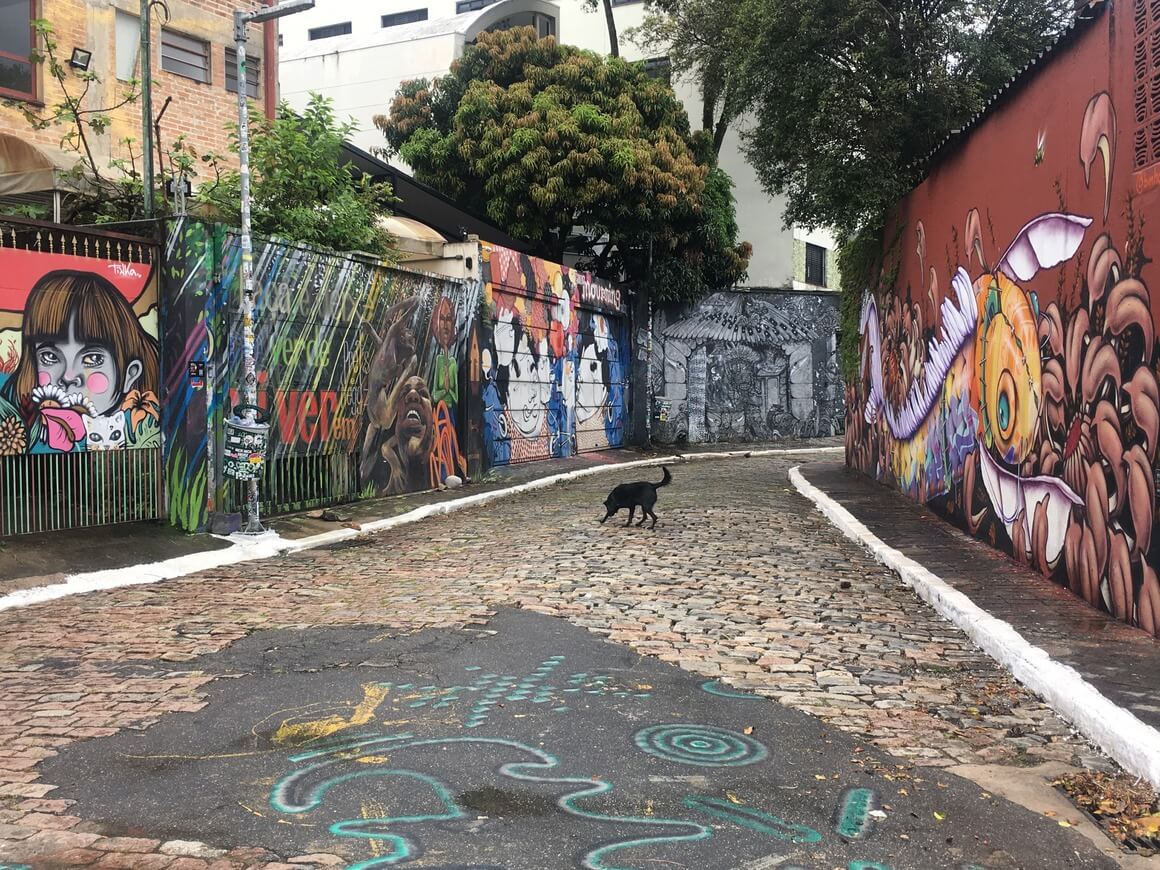
The Broke Backpacker is supported by you . Clicking through our links may earn us a small affiliate commission, and that's what allows us to keep producing free content 🙂 Learn more .
São Paulo is the same way, especially so during the day. For the most part, you’ll feel safe. Many of the locals are quite well-off (it is the business and financial hub of Brazil), and you’ll be surrounded by other travelers almost constantly.
The thing with São Paulo, though, is that it’s a gigantic city, and similar to New York, there are many different districts. The poorer ones tend to be moderate to severely unsafe, whereas the wealthier, more well-traveled areas are usually fine.
Of course, this article deals with how safe São Paul is as a whole. But here are the two most important general tips we can recommend after years of traveling around this city:
- Always be aware of which neighborhoods are the sketchy ones, and make sure you stay out of them.
- When in doubt, ask for advice from trusted locals (especially those working at your hostel or guesthouse). They can tell you more than any Google search.
Overall though, you needn’t be too concerned about visiting São Paulo .
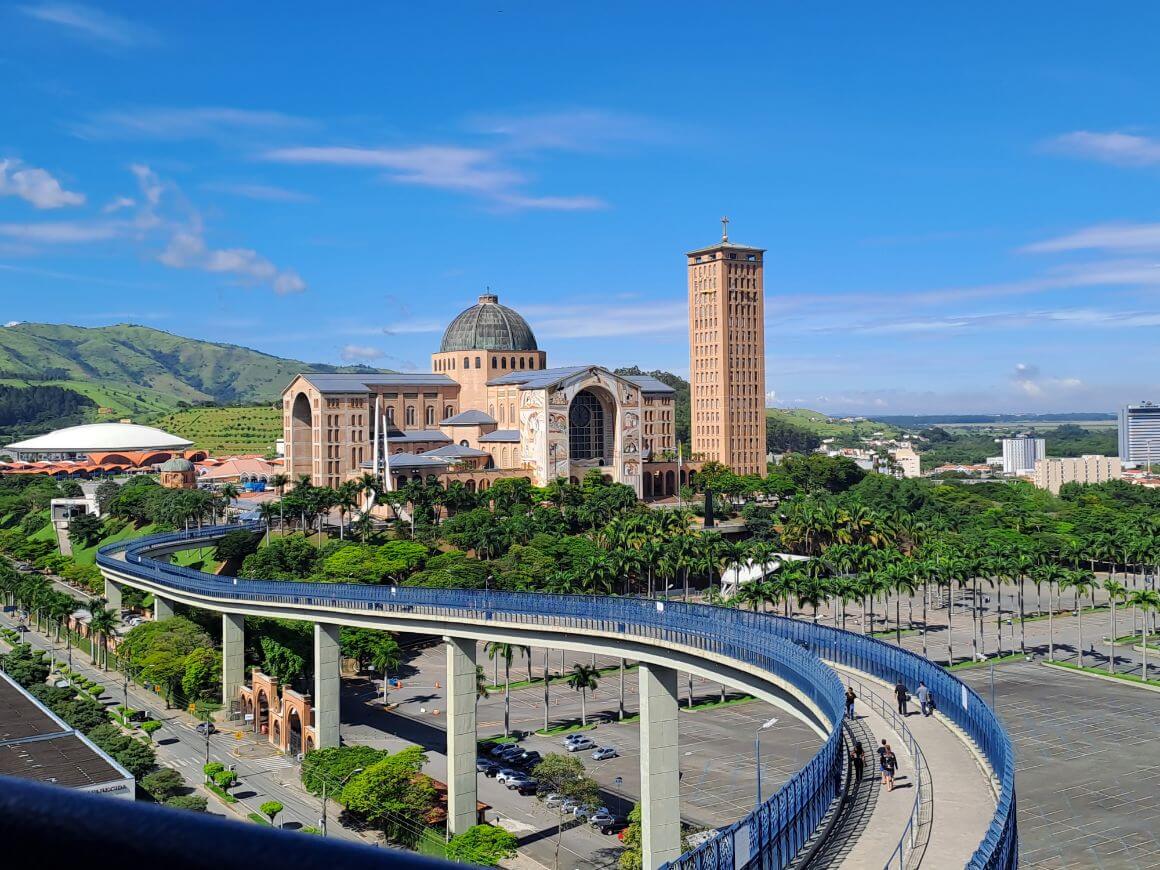
The first thing most people check when examining crime statistics is the homicide rate. What’s interesting (and encouraging!) about São Paulo is that, twenty years ago, the homicide rate was incredibly high, at around 33 per 100,000 .
Now, however, things have dramatically improved. The homicide rate has dropped to around 6 per 100,000 , which is about the same as in the United States. Additionally, Brazil as a whole is listed 130th in 2022’s Global Peace Index , just one place below the United States.
Again, however, location is everything when trying to determine whether São Paulo is safe to visit. In terms of violent crime, a good rule to remember is that one-third of the city’s districts are very safe, one-third are moderately safe, and one-third are significantly unsafe. We’ll get more into which specific neighborhoods to avoid in a later section, but always do your own research before you arrive.
The Brazilian Ministry of Tourism reports a steady yearly increase in international visitors. In 2022, the country welcomed 3.1 million tourists , a nearly 7% increase from the previous two years. If Brazil were so terribly unsafe, we probably wouldn’t be seeing so many visitors.
Yes, it is safe to visit São Paulo right now. It’s no more dangerous to visit São Paulo now than it was months or years ago. In fact, given the statistics listed above, it’s never been safer!
São Paulo’s safety is hard to judge from the safety of Brazil as a whole. This is a giant city: of course, it will still see some safety issues.
Recently, the former president of Brazil, Jair Bolsonaro, lost his re-election. An ideology known as “Bolsonarismo” has arisen since then, in support of their deposed leader. In early 2023, some of the protests turned into violent riots.
Of course, nobody wants to hear about these types of things before traveling, but if you’re staying in São Paulo you should be fine. The worst of the protests were centered around Brasília, Brazil’s capital, and even those have largely died out in the months since.
ALWAYS sort out your backpacker insurance before your trip. There’s plenty to choose from in that department, but a good place to start is Safety Wing .
They offer month-to-month payments, no lock-in contracts, and require absolutely no itineraries: that’s the exact kind of insurance long-term travellers and digital nomads need.

SafetyWing is cheap, easy, and admin-free: just sign up lickety-split so you can get back to it!
Click the button below to learn more about SafetyWing’s setup or read our insider review for the full tasty scoop.
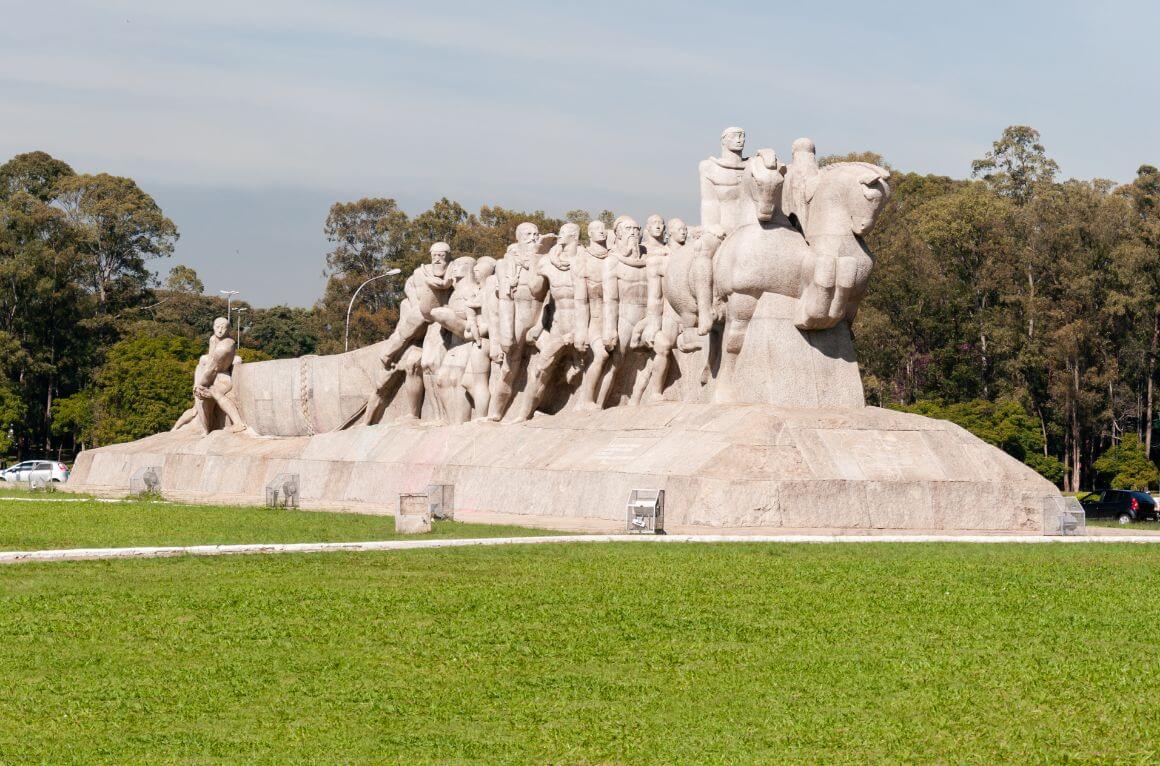
- Know the different neighborhoods – this is one of the most important tips. Avoid places like Capão Redondo, Lapa, Pari, and Campo Limpo. But do your own research before you arrive!
- Avoid the poor districts – the poorer the district, the more unsafe it is. Stay in well-traveled areas.
- Don’t walk alone at night – walking is sometimes the best way to see a city. But in São Paulo you’ll want to walk only during the day, or at least with a big group of people you can trust.
- Don’t accept free rides – if someone offers you a ride, it truly could be a kidnapping attempt. Also, never hitchhike.
- Keep your backpack in front of you – thieves have a much easier time stealing from your backpack when it’s on your back, out of your sight. You might feel like an idiot with your backpack on your stomach, but at least you’ll be a safe idiot.
- Keep your valuables out of sight – don’t carelessly let your phone or your wallet dangle out of your hands. Keep your important stuff out of sight.
- …But don’t keep them in your pockets – if you have deep front pockets, you should be fine. But if you wear shorts or put stuff in your back pockets, you’re inviting disaster.
- Only carry a small amount of cash – the best way to avoid large robberies is to carry very little worth robbing!
- Memorize the number 190 – this is the emergency police number. If something bad does happen, you’ll be relieved you can dial it quickly.
- Always lock up your backpack – it’s easy to get lazy when it’s been weeks and nothing bad has happened. Carry small padlocks for your backpack’s zippers, and when in hostels, always put your bag in a secure locker before you head out for the day.
- Be assertive when you need to be – scammers and thieves are drawn to uncertainty. If someone is exploiting the language barrier and trying to intimidate you into doing something you don’t want to do, stand up for yourself with authority.
- Brush up on your Portuguese – locals who might want to take advantage of tourists won’t consider you a tourist if you can address them in their own language.
- Don’t mess around with drugs – just don’t. Even marijuana is still penalized in Brazil, and you definitely don’t want to disappear into a São Paulo prison.
- Don’t get too drunk at night – this should be obvious, though we know it might curb some of your fun.
- Just don’t do anything stupid – The vast, vast majority of crimes in the world’s cities can be prevented by just having common sense and being aware of your surroundings.
Anywhere you go in the world, you’re going to have to worry about petty crimes like theft. And if you’re a confused-looking backpacker, discombobulated by your arrival into a brand new country, you are, as they say, “meat on the hoof.” To be honest, the problem isn’t too bad in São Paulo—at least, not any worse than what you’d expect in similar cities around the world.
As mentioned earlier though, in São Paulo it always helps to be conscious of where you are. In particular, the central Sé district is chock full of pickpockets. But no matter which district you’re in, just stay especially alert when you’re in large crowds or on public transportation, as these are the times when pickpockets usually have the most success.
ATMs are prevalent in São Paulo, so it’s worth mentioning that you shouldn’t do things like withdraw a bunch of money from a vacant street corner at 2 am—though that one should be obvious. You’ll be fine as long as you use common sense. If you’re really dedicated to keeping your money safe in São Paulo, consider buying a money belt.
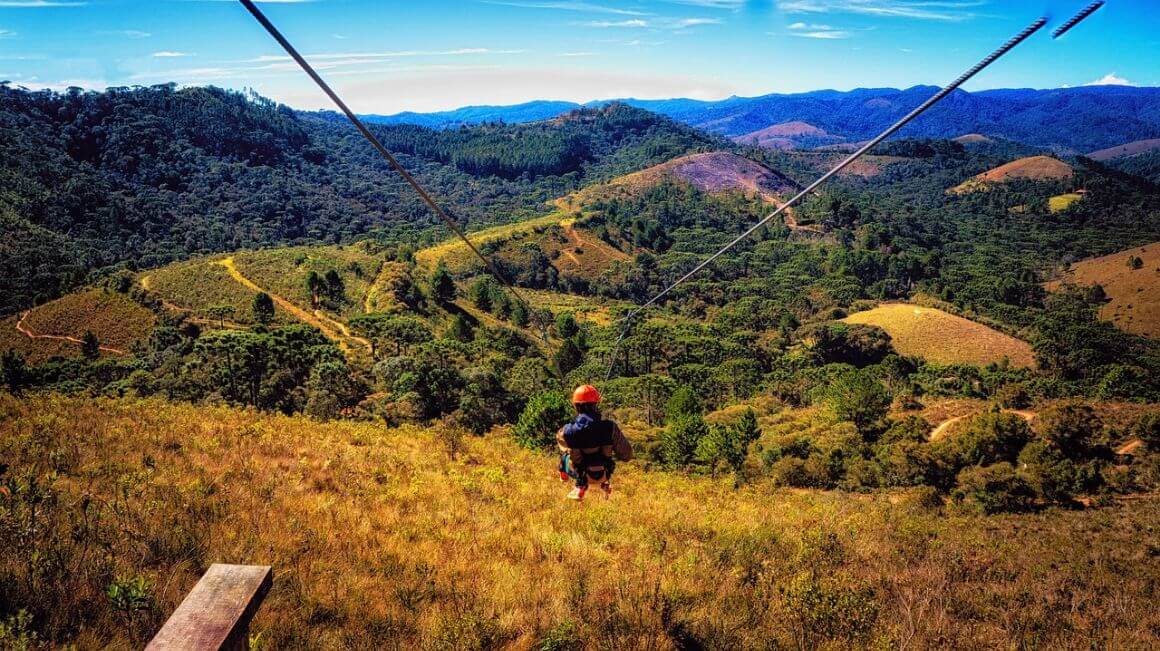
Here’s the thing about traveling alone: you’re never really alone.
Sorry, that sounds creepy. Here’s what we’re trying to say:
Unless you never leave your room and you spend your whole trip binge-watching movies, it’s impossible not to make friends on the road. Just stay at a Sao Paulo hostel or two for a few nights, and you’re bound to leave with lifelong friends from numerous continents. To be honest, it’s the best thing in the world, and one of the most fulfilling things about backpacking. So the question, “Is São Paulo safe to travel to alone?” is almost a trick question.
However, there will be times when you’re totally alone (heck, sometimes you’ll want to be!) and in these situations, it might be a good idea to tell your hostel or guesthouse where you’re going and when they should expect you to return—but that may not always be necessary. The bottom line is that being a solo traveler in São Paulo isn’t anything to worry too much about. BUT…
It’s just a fact that you’re always safer when you’re with friends . And so, in São Paulo, when you’re walking at night, drinking, or just exploring somewhere that’s a little more off the beaten path, it’s definitely a good idea to be part of a group. It’s just so much harder to take advantage of somebody if they’re surrounded by like-minded people who are looking out for their interests.
At the end of the day, you can get into sketchy situations anywhere. Just use the three pounds of neural tissue inside your cranium, and you’ll be dandy.

Stash your cash safely with this money belt. It will keep your valuables safely concealed, no matter where you go.
It looks exactly like a normal belt except for a SECRET interior pocket perfectly designed to hide a wad of cash, a passport photocopy or anything else you may wish to hide. Never get caught with your pants down again! (Unless you want to…)
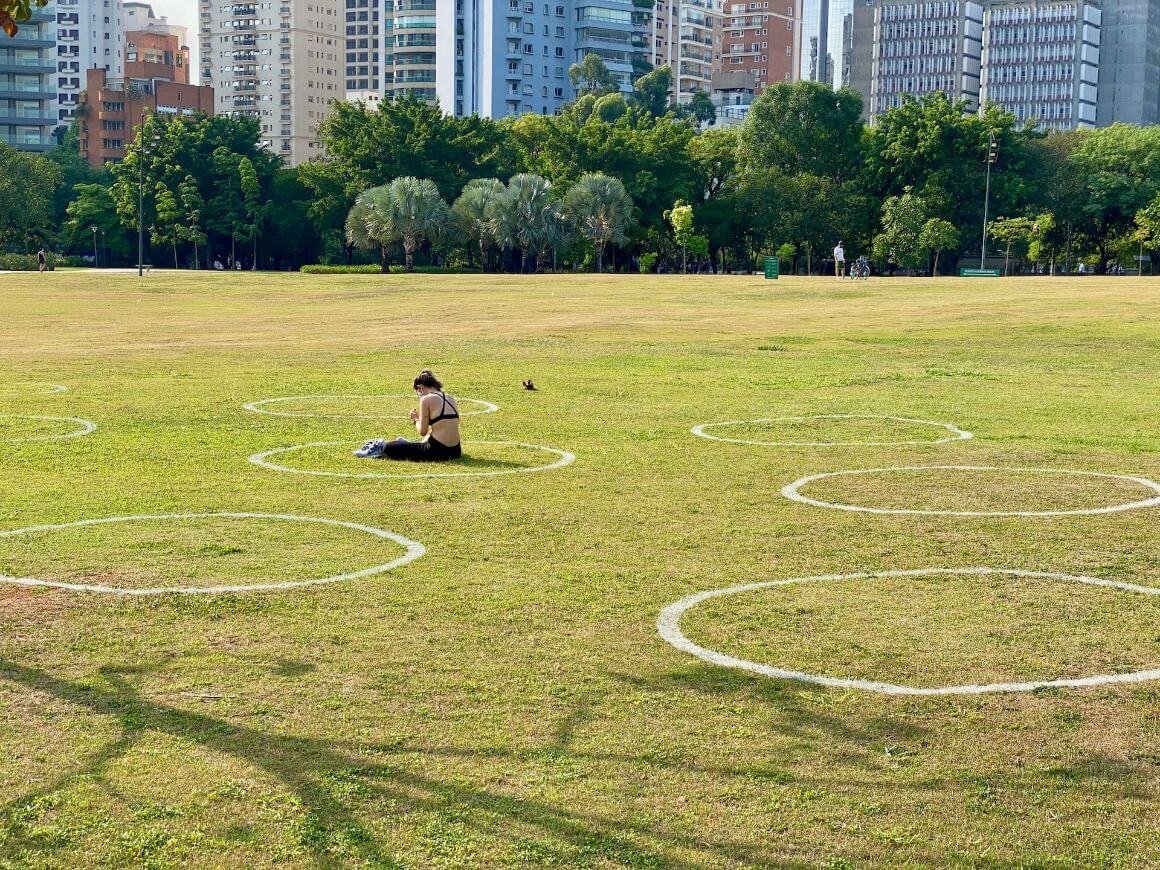
Many countries in the world have the unfortunate quality of being relatively safe and comfortable for men, but much more dangerous and threatening for women.
Thankfully, São Paulo is not one of them.
Socially speaking, Brazil is a modern country, and women possess the exact same rights as men. You won’t be thrown in prison for accidentally baring an ankle, and you won’t be constantly catcalled as you walk down the street. However, it’s always important to err on the side of caution. It’s indisputable that by and large, women are (unfortunately) more vulnerable to crimes like assault and robbery than men.
So if you’re a woman planning a solo visit São Paulo, follow the same guidelines listed in the previous section and you shouldn’t experience any real problems. You’ll need to stay alert, but you shouldn’t have to take any outlandish precautions simply because you’re a woman.
As we already said (and will say many more times throughout this article) just use common sense.

Things go wrong on the road ALL THE TIME. Be prepared for what life throws at you.
Buy an AMK Travel Medical Kit before you head out on your next adventure – don’t be daft!
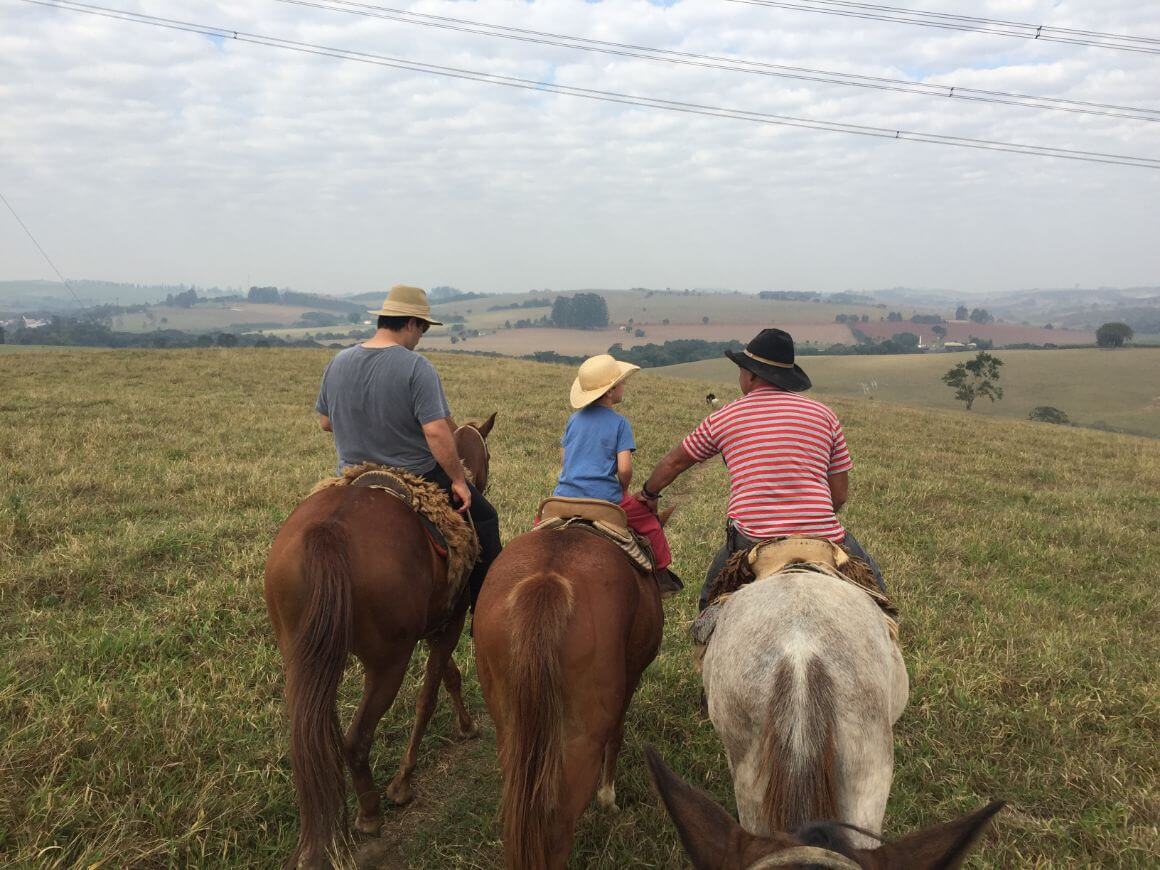
In the same way that São Paulo poses no special threats toward women, it poses no special threats toward families either.
One thing to keep in mind is that, in many aspects, tourist life in São Paulo is tailored toward backpackers. There’s a vibrant nightlife scene, plenty of bars and clubs, and so many travelers visit to experience this side of life. So if, for example, you’re worried about your kids wandering off and getting lost in rambunctious crowds, you might be hesitant. The good news is that, since São Paulo is such a huge city, there are some notable neighborhoods that are both safe and enjoyable for families.
In particular, Chácara Flora, Morumbi, and Alphaville are clean, secure, and a bit less chaotic than the city center. For both safety and personal convenience, we recommend spending time in these types of neighborhoods if you’re visiting São Paulo as a family.
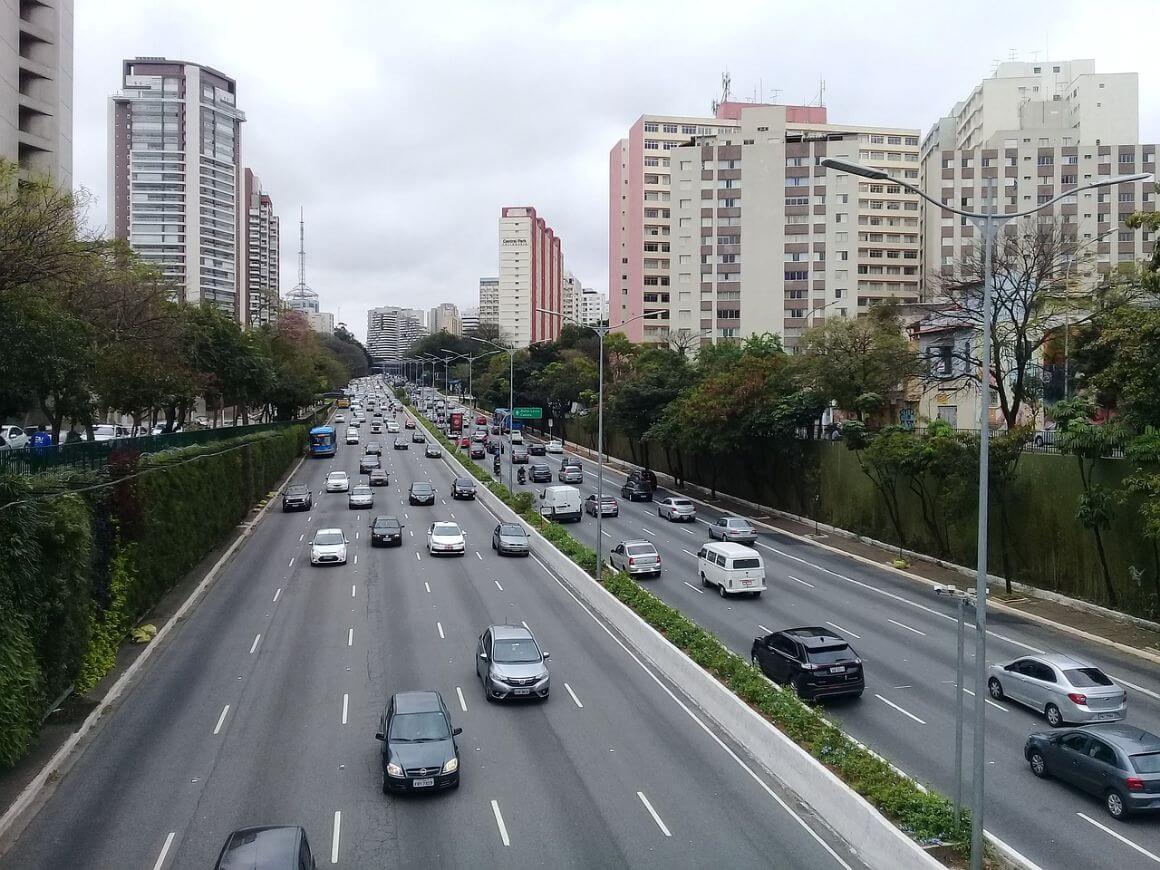
Not to be a buzzkill, but you’ll probably want to stay off the road in São Paulo. Here are the two reasons why:
- The roads are crazy. It depends on the time of day, but whether you’re in a car or on a motorbike, you can expect a cacophony of horns, reckless drivers, and some unfamiliar road rules. You’ll need an International Drivers Permit if you want to drive legally, and this is for good reason: the roads are wild. You’ll also be at risk for roadside robberies if you’re in standstill traffic cranking music with the windows down (and is there anything else to do during a traffic jam?)
- Secondly, it’s just not all that convenient. If you have the misfortune of getting caught in rush hour traffic, your “night out with the girls” plan might get pushed back by a solid three hours. In general, driving in São Paulo is stressful and inefficient.
At the end of the day, the choice is yours. The traffic fatality rate is around 10-20 per 100,000 people, which isn’t much worse than the rate in the United States. So if you’re a very experienced driver and you want to give it a shot, go for it.
Is it Safe to Cycle in São Paulo?
Riding a bicycle can be an excellent method of getting around in São Paulo. And if you do it the right way, it’s pretty safe too.
Here’s what not to do: don’t cycle on the main roads. Drivers in São Paulo can be crazy and reckless, and they’re not always likely to give you, a lowly cycler, the time of day. But São Paulo has around 250 miles of bicycle paths. Stay on these and you’ll be safe for the most part, as you’ll be most closely surrounded by other cyclists and pedestrians.
Here are some other bonuses: these bike paths can allow you to circumvent the worst of São Paulo’s traffic jams, and even some metros allow you to bring your bicycle on board if you need to get somewhere far away.
For recreational cyclists, some of São Paulo’s best routes are below:
- Maua Maluco
- Volta do Frango
- Estrada Velha Campinas
- Pelotão do Jóquei
…and many, many more. These routes are scenic, diverse, and most importantly—SAFE!
Is Uber Safe in São Paulo?
For the most part, São Paulo is a normal, modern city. As such, Uber can be a nice way to get around, as long as you’re aware of the inconveniences of rush hour traffic.
Uber in São Paulo is generally safe. As long as you hold to the normal precautions, like checking the license plate number and making sure your driver is verified and has completed past trips, you should have nothing to worry about.
Of course, there are a few bad apples everywhere. If at any point your driver makes you uncomfortable or nervous, don’t hesitate to tell them to pull over, and just exit the vehicle. It’s always better to be safe than sorry, even if it makes you feel like a paranoid loser.
And definitely don’t expect your driver to speak English—we recommend you brush up on either your Portuguese or your pantomime game.
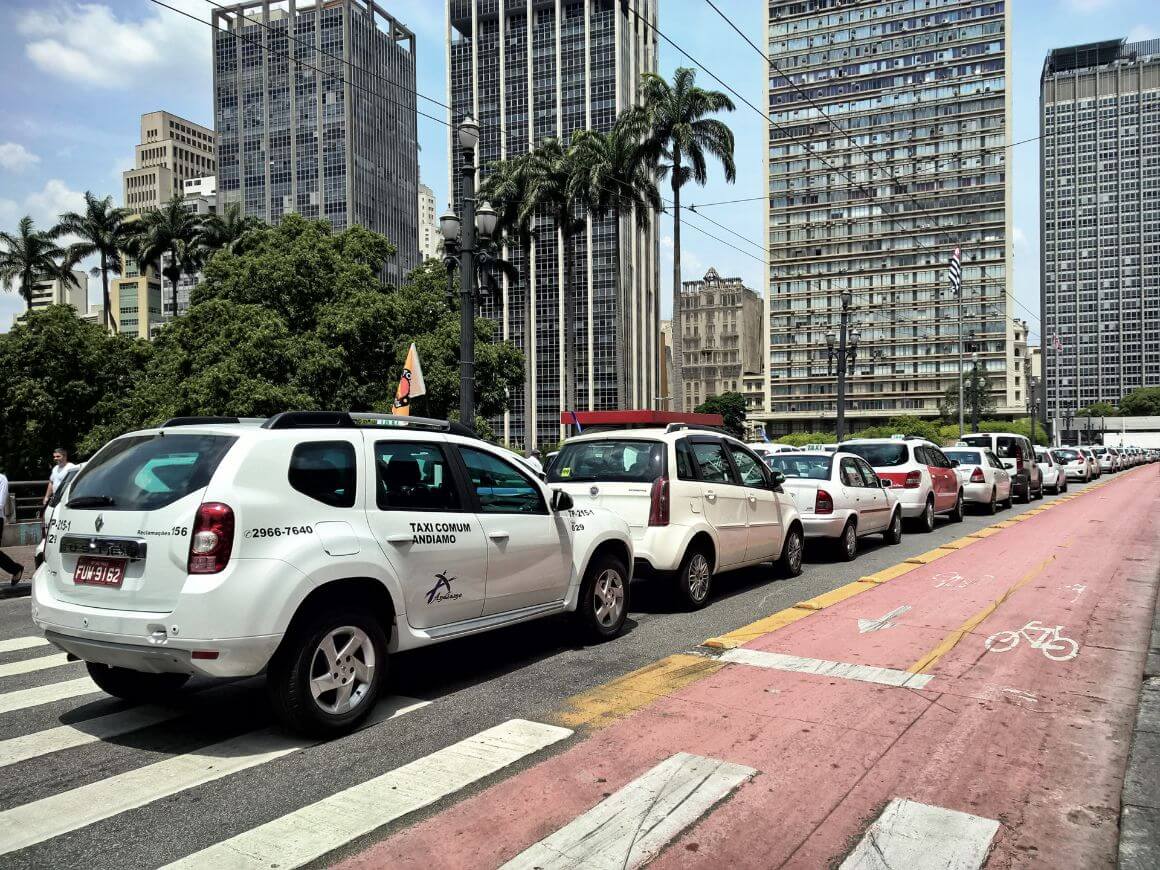
As it is with Ubers, so it is with taxis. They’re no more dangerous in São Paulo than they are anywhere else.
Here are some standard precautions you can take to avoid the occasional scammers:
- Insist they use the meter. If they refuse, take another cab.
- Make sure the meter is working properly; if your fee is increasing way too quickly, something might be afoot.
- When leaving the airport, go with the most official-looking taxi company.
And as always, if your driver makes you nervous for whatever reason, ask them to stop, and just get out. There’s no shortage of taxis in São Paulo, and if one driver charges too much or seems a little creepy, there are always countless other honest drivers at the ready who would be delighted to take you.
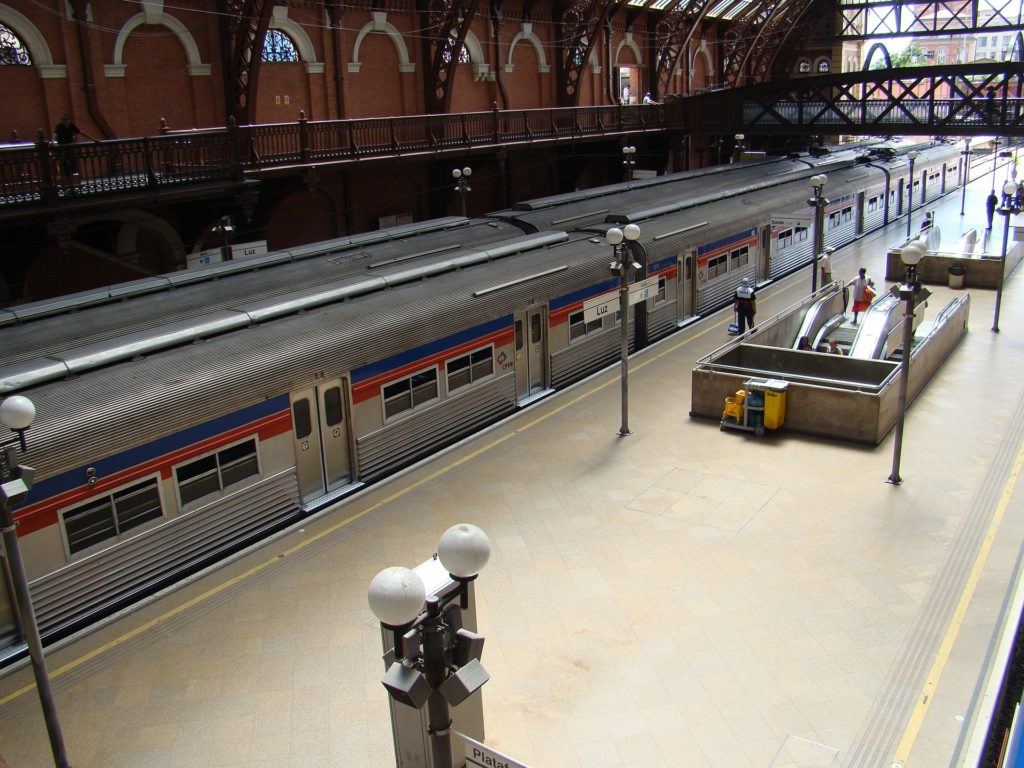
Both ex-pats and locals alike use public transportation as their preferred method of travel. The metro is by far the most efficient, as it’s not beholden to any road traffic. Both the metro and bus systems are relatively safe, but there are a few things you definitely need to keep in mind as you travel.
- In the above section, we talked about how pickpockets prefer crowds. Well, it just so happens that the metros and buses are often the most crowded places in the entire city. Pickpockets will bump into you “accidentally,” steal your wallet or phone, hop off the bus or metro, and you’ll be left rocketing off to your next stop totally oblivious.
- If you’re traveling late at night, stay extra alert at quiet bus stops and metro stations. Kidnappers and thieves alike know to hover around these places, as buses will often dump one or two passengers out into the night and drive away, unwittingly depositing a ripe target in a cloud of black exhaust fumes. Either don’t travel at night or always stay with a group.
- If you really want to feel safe, you’ll probably want to stick with Uber or taxis. Of course, those come with their own risks, but in general, there are fewer variables in terms of things that could go wrong.
Key takeaways: keep your personal belongings close and travel only during the day or with a big group, and you needn’t be too concerned about public transportation in São Paulo. A good rule is to watch the locals and see how they behave. Are they walking quickly? Are they looking around nervously? See what they do, and do likewise.
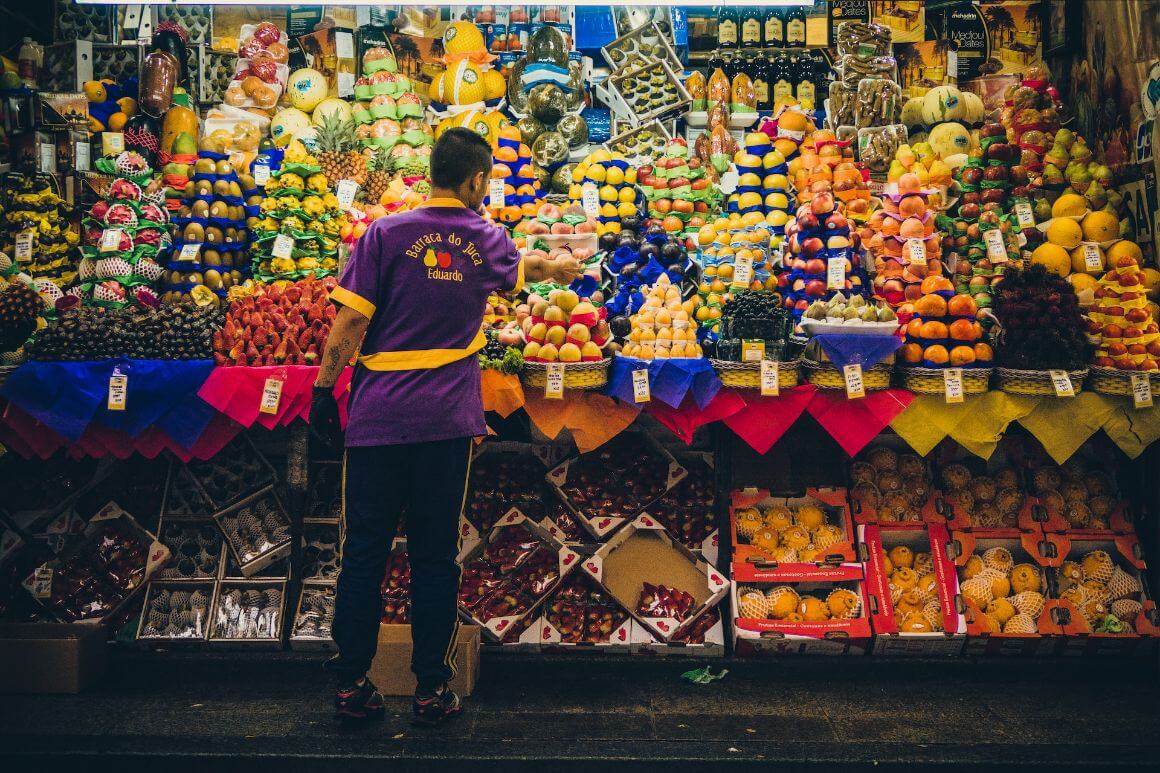
Asking, “Is the food in São Paulo safe?” is like asking, “Do the pyramids in Egypt smell good?” In other words, it’s to miss the point entirely. Not only is the food safe—it’s utterly delicious!
The cuisine is one of the most amazing things about visiting São Paulo. Besides the local Brazilian fare, it’s safe to say you’ll find the best Asian, European, and African food here as well. There’s a huge amount of fine dining restaurants, and no shortage of dirt-cheap street food stalls as well. Fried, grilled, seared, vegan—you name it, São Paulo has it.
Now, of course, there is a mandatory safety warning. And it’s kind of important. Two things you’ll want to consider are:
- No matter where you go, there is a risk of food poisoning. It’s not likely, but when possible, avoid meat that looks undercooked and spit-out food that tastes spoiled. If you do get food poisoning, there’s really no other option at first but to let it run its course. But if you continue to worsen, check yourself into a hospital.
- Health standards vary tremendously throughout the city, and the unfortunate truth is that healthy food is usually more expensive than unhealthy food. A diet of pure street food will undoubtedly take a toll on your body. Make a point to avoid constant deep-fried and sugary foods, and you’ll be in a good spot.
But yeah—in terms of your own enjoyment, you really can’t go wrong with the food here. Don’t be paranoid, just be smart, and your taste buds will thank you.
It depends on what kind of water you’re talking about.
Bottled water? Heck yeah! Tap water? Hell no.
In many cities around the world, locals are adjusted to the tap water after years of drinking it, and only foreigners have a problem with it. In São Paulo though, even many locals have filters installed in their taps to make the water more palatable. So yeah, if you were wondering about tap water, the answer is a resounding no.
What you should do is drink bottled water only, or get yourself one of these bad boys:

Drink water from ANYWHERE. The Grayl Geopress is the worlds leading filtered water bottle protecting you from all manner of waterborne nasties.
Single-use plastic bottles are a MASSIVE threat to marine life. Be a part of the solution and travel with a filter water bottle. Save money and the environment!
We’ve tested the Geopress rigorously from the icy heights of Pakistan to the tropical jungles of Bali, and can confirm: it’s the best water bottle you’ll ever buy!
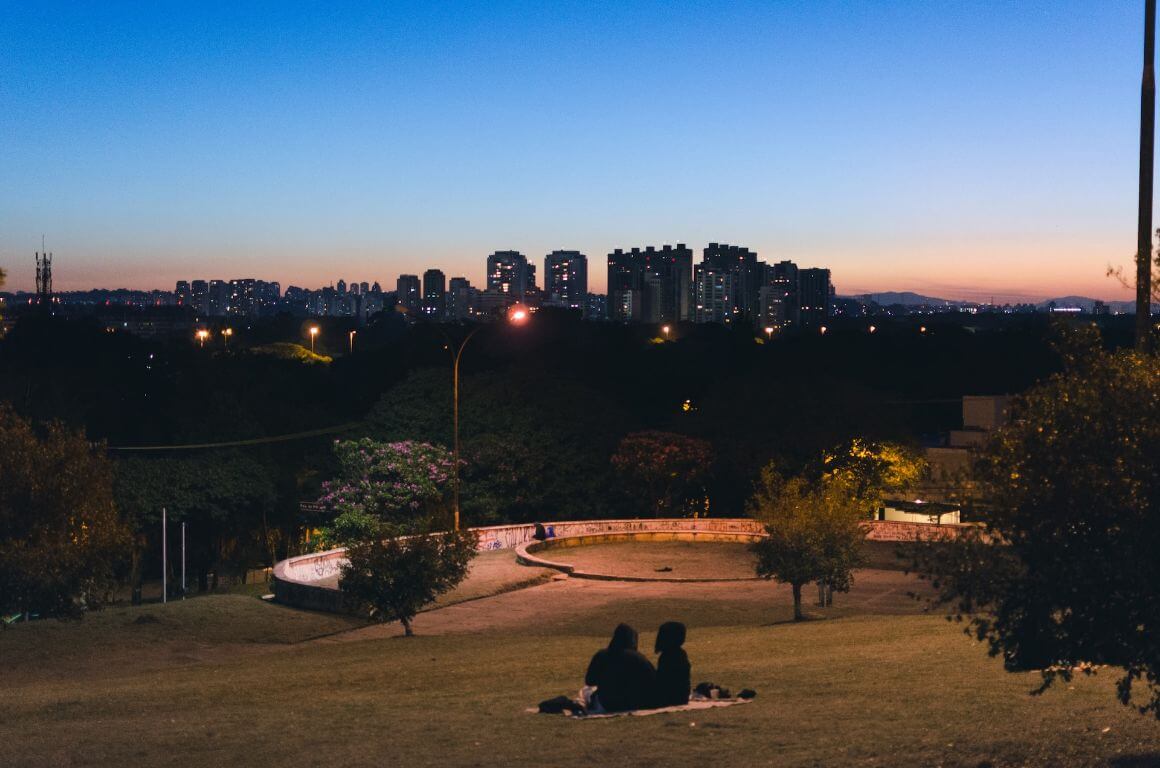
São Paulo is an excellent place to live, especially if you’re a digital nomad . Internet cafés abound, and since the city is the center of business in Brazil, you’ll be surrounded by like-minded people.
As long as you follow the tips laid out in this article, living in São Paulo isn’t any more sketchy than traveling through it. You’ll definitely want to find an apartment in a good neighborhood like Morumbi, Chácara Flora, Santa Cecília, or Brooklyn Novo. Avoid neighborhoods like Capão Redondo, Lapa, Pari, and Campo Limpo.
The visa process can be a little confusing, but once you’re settled, life in the right São Paulo neighborhood can be cheap and quite charming!

A new country, a new contract, a new piece of plastic – booooring. Instead, buy an eSIM!
An eSIM works just like an app: you buy it, you download it, and BOOM! You’re connected the minute you land. It’s that easy.
Is your phone eSIM ready? Read about how e-Sims work or click below to see one of the top eSIM providers on the market and ditch the plastic .
Healthcare in São Paulo is really bad. It’s also really good! How is that possible?
Brazil is one of the many countries that offer totally free healthcare for residents. But as you probably know, when something sounds too good to be true, it usually is. What’s the trade-off here?
The public healthcare system is a little… backward. The technology in the hospitals is usually outdated, there’s a severe language barrier, and the overall quality of care is lacking. Most ex-pats who live here decide to pay for health insurance and use private care.
That being said, if you need a few stitches or if you have a minor case of food poisoning, a public hospital should do the job just fine. Anything more major, however, and you’ll probably want to be a bit safer and pay the extra premiums at a high-quality private facility.
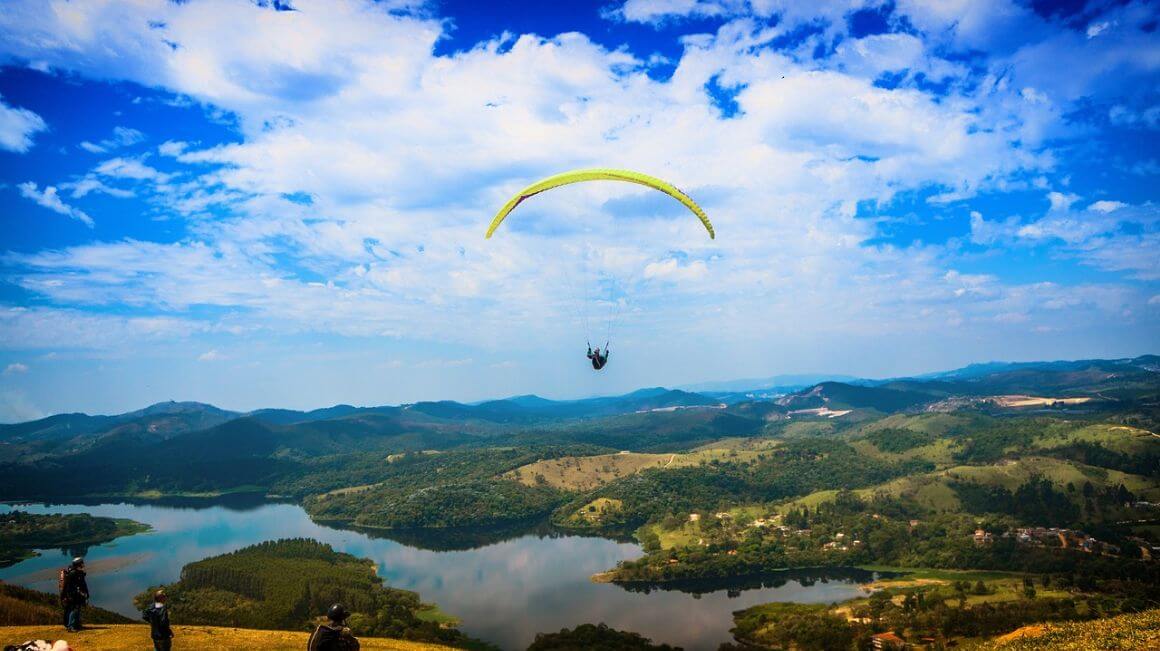
São Paulo is a charmingly chaotic city with so much going for it. Though it has earned itself a bad reputation for safety in the past, the statistics undeniably show significant improvements throughout the last few decades.
By and large, you have nothing crazy to worry about. As we mentioned in the beginning, the most important things you can do are be aware of which neighborhoods are safe (and which aren’t!) and when in doubt, ask trusted locals for advice.
With a little bit of common sense, you’ll have a heck of a trip.

Claire Sturzaker
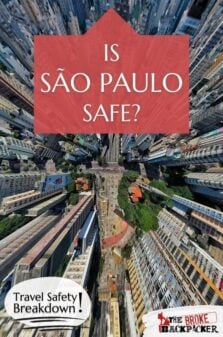
Share or save this post

Leave a Reply Cancel reply
Your email address will not be published. Required fields are marked *
Save my name, email, and website in this browser for the next time I comment.
Notify me of followup comments via e-mail.
Best Time to Visit
Weather & Climate
Guarulhos International Airport Guide
Public Transportation
Best Hotels
Top Things to Do
Coolest Attractions
Best Museums
Where to Shop
Sao Paulo's Architecture
Food to Try
Best Restaurants
Nightlife Guide
Your Trip to Sao Paulo: The Complete Guide
On the Brazilian landscape, one city stands above the rest in gastronomy, shopping, nightlife, street art, and museum offerings: Sao Paulo. Here foodies come to try all the flavors of the regions of Brazil, dishes of its diasporas, and experimental projects by Michelin-starred chefs. Over 50 shopping malls, the most famous high fashion street in South America, and 60 specialized shopping streets for everything from electronics to wedding dresses draw enthusiastic buyers to its stores every day. Paulistinos (the city’s residents) party literally until dawn in its baladas (dance bars) and along the Baixo Augusta. During the day, world-famous museums like the Museu de Arte de Sao Paulo opens its doors, while cultural centers like the SESC Pompéia offer free activities for residents and tourists alike. Stroll through the graffiti art of Beco do Batman or see Niemeyer’s massive Modernist building Edifício Copan. Everything can be found here, except a beach, but even those aren't too far away.
Planning Your Trip
- Best Time to Visit : Come to Sao Paulo in the spring (September to November). During this shoulder season, days are long, nights are cool, and the city hosts weeks-long events focused on food, art, and entertainment.
- Language: Portuguese
- Currency: Brazilian real
- Getting Around : The Metro, Sao Paulo’s public transit system, will be the easiest and one of the cheapest ways to travel throughout the city; download the Moovit app for simple navigation in English. Avoid renting a car as traffic can be horrendous—especially for those not familiar with the roads. Instead, take an Uber or taxi, both of which are plentiful.
- Travel Tip: Most businesses accept credit and debit cards. Except for buying tickets to ride the Metro and in certain markets, you won’t need cash unless you prefer using it over your card.
TripSavvy / Jamie Ditaranto
Things to Do
Sao Paulo has bangin’ nightlife, world-class shopping and museums, and live music throughout its streets. See art and learn the history of Brazil, soccer, and the Portuguese language in the city's museums, or cozy up with a good read in one of its many bookstores. Behold the structures of Modernist architects like the massive Edifício Copan and drum-factory-turned-cultural center SESC Pompéia, or walk down Paulista Avenue on a Sunday afternoon when it becomes a giant pedestrian thoroughfare. Sao Paulo has the largest city helicopter fleet in the world, so hire a chopper for an aerial view.
- Wander Mercado Municipal sampling mangosteen, persimmon, dragon fruit, and other exotic produce from its 300 stalls. (Samples are free with no obligation to buy.) Afterwards, climb the stairs to the restaurant portion of the market and order a mortadella sandwich.
- Spend the day at Ibirapuera Park museum hopping between the Afro Brasil Museum , Museum of Modern Art , and Museum of Contemporary Art . Walk along the park paths, rent a bike, or sunbathe with Paulistinos in its extensive green fields. See buildings designed by Oscar Niemeyer, like the Oca, and visit the spaceship-shaped planetarium.
- Visit the Museu de Arte de Sao Paulo (MASP) to see the genius of architect Lina Bo Bardi and art work spanning continents and centuries. Works by Picasso and Candido Portinari hang in glass frames in an open floor plan, removing any barriers from the viewers and the art. Check out what’s happening in the pavilion beneath the museum, which acts as a meeting point for impromptu concerts, fairs, and protests.
Explore more attractions with our full-length articles on the top things to do in Sao Paulo , important places to visit in Sao Paulo , and Sao Paulo's best museums .
Where to Eat and Drink
Sao Paulo has one of the most famous (and delicious) gastronomy scenes in the world, known for both its fine dining and street food. Regional dishes from all over Brazil, from the moqueca (seafood stew) of the north to the meaty farofa-topped barreado of the south, can be found here. Bite into a warm, crunchy coxinha full of shredded chicken; pop a cheesy, chewy pão de queijo; or try a flakey pastel. Order a mini-feast of feijoada from any neighborhood restaurant on a weekend, and after you’ve slept it off, refresh your pallet with an ice-cold açai bowl. In addition to offering food from all over the world due to its strong immigrant population, the city is also home to A Casa do Porco , an experimental pork restaurant with onsite butcher shop, and D.O.M ., which highlights regional ingredients from throughout Brazil using French, Italian, and Indigenous cooking methods.
Paulistinos love a cold, creamy chopp (draft beer), especially on weekend afternoons at botecas (neighborhood bars), which are plentiful in the Vila Madelena neighborhood. For something harder, the national liquor is cachaça, a sweet spirit made from sugarcane juice and the base ingredient in another famous Brazilian beverage: the caipirinha. Most bars will have these drinks, but to check out the microbrewery scene, head to a craft beer bar like Emporio Alto dos Pinheiros , one of the pioneers of the craft beer movement in Brazil.
According to Sao Paulo Turismo S/A, the official tourism and events company of the city of Sao Paulo, the tap water is drinkable . However, it’s recommended to have filtered water instead. You can easily find mineral water at supermarkets, restaurants, coffee shops, and bars.
Explore our articles on the best restaurants in Sao Paulo , the top foods to try in Sao Paulo , and nightlife in Sao Paulo .
Where to Stay
The art-filled Vila Madelena neighborhood offers well-priced Airbnbs and hostels, colorful streets of graffiti murals, third wave coffee shops, local bars, and friendly bohemian artists. Staying along Avenida Paulista in neighborhoods like Bela Vista will give you easy access to the MASP and the city’s best nightlife strip on Baixo Augusta. Centro might be a little rough, but bursts with personality and contains historic sites like Edifício Copan, Mercado Municipal, and Cathedral Sé. Stylish and LGBTQ-friendly Higienópolis is food heaven with swanky hotels and one of the city’s best malls, all only a mile or two from Avenida Paulista. Further out, Brooklin Novo offers luxury hotels and shopping, good for business travelers wanting to relax. Pinheiros has cultural centers with fascinating free activities, art galleries, funky boutiques, and a park great for midday lounging.
Check out our recommendations of the best hotels in Sao Paulo .
Getting There
Sao Paulo’s main airport is Guarulhos International Airport (GRU) , where most international flights will land. Two other airports service the city: Viracopos Airport (VCP) in Campinas for flights in Latin America and Congonhas Airport (CGH) for domestic flights. The Tietê Bus Terminal links Sao Paulo with all major cities in Brazil via clean, comfortable, and cheap long-distance buses.
Culture and Customs
Pickpocketing is a problem in Sao Paulo, especially in crowded, touristy areas. Be aware of your belongings, especially if going to large markets or festivals. While some areas are fine to walk at night, others are not. Check with your accommodation about the safety of where you are staying, and when in doubt, this issue is easily remedied by calling an Uber. Walking during the day throughout most of the city is safe.
This is not the laid-back beach side Brazil you would find in Rio or Florianopolis. Sao Paulo is the financial center of Brazil and one of the largest cities in the world. Expect a much faster pace of life, and people letting loose at night and on the weekends after long work days. When dining out, service will generally be fast, and the tip is already included.
Money Saving Tips
- If you want quick, cheap food with lots of variety, go to a comida por quilo restaurant. Fill your plate from the buffet, then take it to the cashier to weigh it before you eat. You pay by weight rather than a set price, and it usually ends up costing the equivalent of a few dollars.
- Go to the top of Edifício Copan for free by lining up outside gate F any day at 1:30 p.m. You’ll be let in at 2 p.m. to head to the roof where you can see panoramic views of Sao Paulo.
- Take the Metro or a bus to the airport instead of an Uber or taxi. Give yourself a time cushion in case the transfers take a while.
- The 99 Taxi app is usually a little cheaper than Uber and just as reliable.
- Many of the museums like MASP and Pinoteca have free admission days. Others, like MIS and the Museu Afro Brasil, are fee all the time.
- For free, quality entertainment, go to a centro culturai (cultural center). Sao Paulo contains about 40 cultural centers showcasing exhibitions, theater, art, concerts, debates, and more.
- Check out Mamba Negra free music parties in abandoned buildings throughout the city.
- Visit outside of high season (December to March) for cheaper accommodation.
São Paulo Turismo S/A. "FAQ: What is the language that the people of São Paulo (Paulistanos) speak?"
São Paulo Turismo S/A. "Practical Guide: Currency and Exchange."
São Paulo Turismo S/A. "FAQ: Is Tap Water Drinkable?"
Nightlife in Sao Paulo: The Best Bars, Clubs, & More
5 Best Art Museums in Brazil
A Complete Guide to the Architecture in Sao Paulo
15 Top Things to Do in São Paulo, Brazil
The Top 10 Museums in Sao Paulo
Cairo Guide: Planning Your Trip
Important Places to Visit in São Paulo, Brazil
New York City Guide: Planning Your Trip
Your Trip to the Netherlands: The Complete Guide
15 Top Things to Do in Lisbon, Portugal
48 Hours in Prague: The Ultimate Itinerary
The 9 Best Places to Shop in Sao Paulo
The 15 Best Restaurants in Sao Paulo
Your Trip to Edinburgh: The Complete Guide
Iguazu Falls Travel Guide: Planning Your Trip
Your Trip to Lima: The Complete Guide
São Paulo Travel Guide
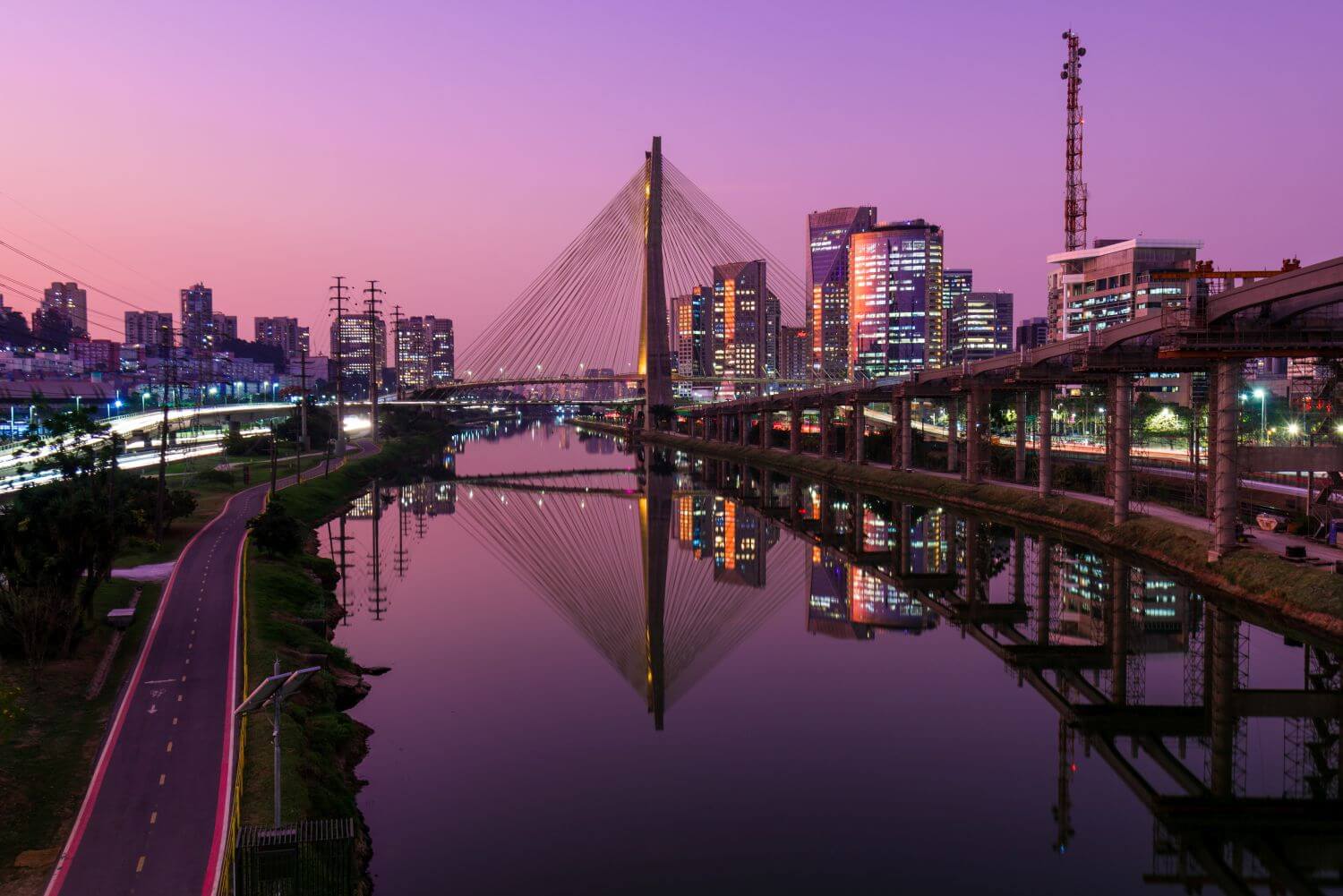
Is São Paulo safe for tourists?
São Paulo, the sprawling metropolis of Brazil, beckons travelers with its vibrant culture, delicious cuisine, and exciting urban atmosphere. However, like any major city, you might ask: Is São Paulo safe for tourists? As a born and raised Paulistano, I understand the importance of addressing these concerns.
Like any big city, São Paulo has its fair share of challenges, such as petty theft, pickpocketing, and occasional street crime. In recent years, violence rates in the city have increased, and some areas are quite dangerous for tourists and locals alike. Usually, the places most visited by tourists tend to be safer, but the increased crime in recent years means you must be careful in all city neighborhoods. With the right precautions and awareness, you can minimize risks and enjoy your trip to the fullest.
In this comprehensive guide, you’ll find everything you need to explore the city safely. Armed with the latest insights and expert tips, you can confidently venture into the heart of this captivating city, knowing how to navigate potential challenges and ensure a worry-free experience.
Safe Neighborhoods for Tourists
When choosing accommodation in São Paulo , selecting a safe neighborhood is crucial. Areas like Jardins, Itaim Bibi, and Vila Madalena are some of the best places to stay in São Paulo. They are popular choices among tourists due to their relative safety and proximity to major attractions. You should try to avoid staying in São Paulo’s Downtown and adjacencies, like República, Luz and Santa Cecília, as these are not the safest places to be right now.
Transport Safety
Navigating a megacity like São Paulo can be overwhelming, especially for first-time visitors. Understanding the public transport system, which includes buses, trains and the metro, is essential for safe and efficient travel. The main metro lines are relatively safe, and so are the train lines that serve the main tourist sites. While buses are also relatively safe in the more touristy areas, it is a bit more challenging to use this transportation to get around. In all cases, avoid using your cell phone or keeping valuable objects, such as cameras, in sight on public transport.
Registered taxis and ride-sharing apps like Uber are safe and can be used without major problems. In the case of cabs, prefer those indicated by your hotel or those found at official stations.
Language and Cultural Awareness
While English is often spoken in popular tourist spots and establishments, venturing beyond these areas may require some basic Portuguese knowledge. Even knowing simple phrases such as “hello” (olá), “thank you” (obrigado/obrigada), and “excuse me” (com licença) can make a significant difference in your interactions with locals.
The effort to communicate in their native tongue is always appreciated and can lead to more positive and authentic experiences. Paulistanos, are we’re called, are accustomed to interacting with visitors, and they often find creative ways to communicate, such as hand gestures and body language, to bridge the gap.
Avoiding Scams and Tourist Traps
Like any other tourist destination, São Paulo has its share of scams and tourist traps. As a bustling metropolis and one of Brazil’s top tourist destinations, the city can attract opportunistic individuals looking to take advantage of unsuspecting visitors. Knowledge is your first line of defense against scams and tourist traps. Before your trip, research common scams that travelers have encountered in São Paulo. Being aware of potential risks will allow you to recognize and avoid them more effectively.
Nighttime Safety
As the sun sets, the city comes alive with vibrant bars, restaurants, clubs, and cultural events, inviting visitors to immerse themselves in the exciting nocturnal scene. While embracing the city’s nightlife can be an unforgettable experience, being mindful of potential risks and taking necessary precautions is crucial to ensuring a safe and enjoyable evening in São Paulo. Always stay in well-traveled areas, opt for reliable transportation, such as Uber or registered taxis, drink responsibly and seek local advice to make the most of São Paulo’s nightlife while ensuring a worry-free experience.
Overall, São Paulo is a violent city, but you can have a safe vacation provided you take the necessary precautions and stay informed. While the city offers an unforgettable experience, being aware of potential risks and staying prepared is essential.
By arming yourself with the knowledge and insights from our São Paulo Safety Guide, you can embark on a memorable journey, indulging in the city’s rich culture, vibrant energy, and warm hospitality without compromising your safety.
Leave a Reply Cancel reply
Your email address will not be published. Required fields are marked *
Save my name, email, and website in this browser for the next time I comment.
Get Daily Travel Tips & Deals!
By proceeding, you agree to our Privacy Policy and Terms of Use .
Tips on Sao Paulo Warnings or Dangers – Stay Safe!
Virtual Tourist
Travel Smarter! Sign up for our free newsletter.
Sao Paulo Warnings and Dangers
Sao Paulo is home to over 12 million people, and is the financial heartbeat of Brazil. Tourists are welcome, but they must be prepared to navigate the dangers of city before they arrive.
As in any city with millions of residents, crime is inevitable. When looking for a hotel, consult a travel agent and ask if the area is safe. Most neighborhoods are fine, but a few are hotbeds of drugs, prostitution, and violence, and should be avoided. While in the city, lock your passport and valuable belongings in a hotel safe or your luggage. Always keep an eye on your purse and wallet, and never leave anything unattended in a public place. The local police are a constant presence and they’ll protect you while you’re downtown, especially on the main streets. Don’t venture off into unknown neighborhoods. While violence against tourists is rare, it’s still possible if you stray too far from the city center.
Sao Paulo is a lively city. Traffic is always busy, so bring your patience. If you’re brave enough to rent a car, drive with caution. The locals are aggressive and they won’t wait for you to become familiar with the city. Public transportation is fairly easy to navigate, or you can take a cab, if you can afford the fares.
Travelers to Sao Paulo are often drawn by the nearby caves. While beautiful and a fun excursion for those who want an adventure, they can also be treacherous. More than a few tourists have fallen to their deaths in the caves. The best way to explore them is with a guide. Even the most experienced, well-equipped spelunkers find the caves challenging, so don’t take any chances.
Editor’s Note: The information contained on this page was compiled using real traveler reviews about warnings and dangers in Sao Paulo.
We hand-pick everything we recommend and select items through testing and reviews. Some products are sent to us free of charge with no incentive to offer a favorable review. We offer our unbiased opinions and do not accept compensation to review products. All items are in stock and prices are accurate at the time of publication. If you buy something through our links, we may earn a commission.
Top Fares From

Don't see a fare you like? View all flight deals from your city.
Today's top travel deals.
Brought to you by ShermansTravel
Oslo to Bergen: 6-Night Norway Fjords...

Luxe, 7-Night Caribbean & Mexico Cruise...
Regent Seven Seas Cruises

Ohio: Daily Car Rentals from Cincinnati

Trending on SmarterTravel
Cookies on GOV.UK
We use some essential cookies to make this website work.
We’d like to set additional cookies to understand how you use GOV.UK, remember your settings and improve government services.
We also use cookies set by other sites to help us deliver content from their services.
You have accepted additional cookies. You can change your cookie settings at any time.
You have rejected additional cookies. You can change your cookie settings at any time.
Register to vote Register by 18 June to vote in the General Election on 4 July.
- Passports, travel and living abroad
- Travel abroad
- Foreign travel advice
Safety and security
This guide also has safety advice for regions of Brazil .
There is a high threat of terrorist attack globally affecting UK interests and British nationals, including from groups and individuals who view the UK and British nationals as targets. You should remain vigilant at all times.
UK Counter Terrorism Policing has information and advice on staying safe abroad and what to do in the event of a terrorist attack. Find out how to reduce your risk from terrorism while abroad .
Terrorism in Brazil
Terrorist attacks in Brazil cannot be ruled out.
Protests and civil unrest
Protests, demonstrations and strikes take place regularly in cities across Brazil, with reports of arrests and clashes between police and protesters. They can disrupt transport. Even peaceful events can sometimes turn confrontational and escalate into violence. Police have used rubber bullets and tear gas extensively to disperse protesters. The effects of tear gas can be felt several hundred metres beyond the immediate site of demonstrations.
You should:
- avoid political rallies or other events where crowds have congregated to protest
- follow local news reports
- comply with the instructions of local authorities
If you encounter a political protest or feel uncomfortable in a large gathering, leave the area immediately.
Favelas (‘slum’ or ‘shanty town’) are urban neighbourhoods of high-density informal housing. They exist in all major Brazilian cities and can border areas used by tourists and visitors.
The security situation in many favelas is unpredictable. Visiting a favela can be dangerous. Avoid all favelas, including favela tours marketed to tourists and any accommodation, restaurants or bars advertised as being within a favela.
- make sure the suggested route does not take you into a favela if you’re using GPS navigation
- avoid entering unpaved, cobbled or narrow streets which may lead into a favela - tourists have been shot after accidentally entering favelas
If you’re unsure about a location, check with your hotel or the local authorities.
Carnival and other large-scale celebrations
If you are attending a large-scale celebration in Brazil, such as the Carnival in Rio de Janeiro or other major cities, be aware that criminals target people who appear to be wealthy or easy targets, for example, those who have drunk a lot of alcohol.
Be aware of your personal security and surroundings, and be cautious about proposals from strangers that take you away from public areas.
If you’re the victim of crime, contact the local police number 190 or the nearest British embassy or consulate.
Read our guidance if you’re the victim of a crime abroad .
Criminal Kidnaps
Short-term opportunistic kidnapping (called ‘express kidnapping’) can happen. Victims have been kidnapped for a short period of time and driven to an ATM to withdraw money before being abandoned. Express kidnappers may use violence.
To reduce your risk:
- avoid wearing expensive clothing or jewellery, particularly in public
- avoid casual taxis, use official or pre-booked taxis instead where the driver is registered
- be vigilant, especially at night
Pickpocketing is common. Do not go on to city beaches after dark.
If threatened, hand over your valuables without resistance. Attackers may be armed and under the influence of drugs. Do not resist attackers – this increases the risk of harm to you.
You can take steps to reduce the risk to yourself and your belongings, including:
- avoiding wearing expensive jewellery and watches
- avoiding carrying large sums of money – consider wearing a money belt
- avoiding using a mobile phone in the street
- keeping cameras out of sight when not in use
- leaving your passport and valuables in a safe place, but carry a copy of your passport and another form of photo ID, if you have one, at all times
Thefts are particularly common on public beaches and include ‘arrastões’ where large groups of thieves sometimes run through an area of the beach grabbing possessions. Keep your belongings close and avoid taking valuables to the beach.
Robberies on buses are common in many cities. Thieves target mobile phones, particularly between 4pm and 9pm.
Bank and credit card scams are common, including card cloning from ATMs and in shops. Keep sight of your card and do not use an ATM if you notice anything suspicious.
If you withdraw cash at an ATM and the cash has pink marks on it, speak to the bank (or police) straight away to get it changed. It may have been marked as damaged or counterfeit.
Sexual assault and drink spiking
Rape and other sexual offences against tourists are not common, but there have been attacks against both women and men. Some have involved date rape drugs. Buy your own drinks and keep them in sight.
If you begin to feel strange, sick or drunk after only a couple of drinks, tell a trusted friend or security staff. They should take you to a safe place, such as your hotel room or a hospital. You can phone the local police, a hospital or the nearest British embassy or consulate for advice.
Read our advice on what to do if you have been raped, sexually assaulted or drugged abroad .
Child sexual abuse
There are widespread cases of sexual abuse of children in Brazil. All sexual activity with children (persons under the age of 18) is illegal, regardless of the age of consent locally. If you commit sex offences against children abroad, you can be prosecuted in the UK.
Parental child abduction
Parental child abduction is not common but can happen in Brazil. Dial 190 to report a missing child or go to the nearest police station. Read the guidance on international parental child abduction if your child may be at risk of this.
Theft from cars is common. Keep valuables out of sight.
Carjacking can happen, particularly on major roads and in tunnels. To reduce your risk you should:
- approach your car with your keys in your hand so you can get into your car quickly
- keep doors locked and windows closed
- take particular care at traffic lights
- drive in the middle lane if possible
- avoid deserted or poorly lit areas, unless you have reliable local advice
- be cautious of people approaching to ask for information, especially at night
- If driving at night outside the city, avoid stopping at the roadside – if you must stop, try to stop in a petrol station or well-lit area
Laws and cultural differences
Illegal drugs and trafficking scams.
Drug trafficking is widespread in Brazil and the penalties are severe. The penalties for possessing drugs for personal use range from educational classes to community service.
British nationals have been targeted through email scams where fraudsters offer a financial reward for travelling to Brazil, where they are then asked to carry items out of Brazil, including to the UK. These items are often illegal drugs. Anyone caught will face detention for drug trafficking, regardless of the circumstances.
Electronic smoking devices
As of 2 May 2024, all electronic cigarettes and vaping devices are banned in Brazil. Refills, parts, and accessories are also banned.
The Brazilian Health Regulatory Agency (Anvisa) prohibits the import, transport, sale, storage and advertisement of these items. Customs officials have the authority to confiscate any vape products found in travellers’ luggage (both checked in and carry on) during inspections.
LGBT+ travellers
There is no legislation against homosexuality in Brazil. Same-sex marriage is legal and LGBT+ couples have equal rights in law.
São Paulo holds the world’s largest Pride celebration, which is usually very peaceful. Violence at the event is rare. Pride in Rio de Janeiro and other cities also attracts large numbers.
Brazil is generally tolerant. However, Brazilian society is quite conservative, particularly outside the larger towns and cities. Violence against LGBT+ people is a concern. Instances of discrimination, violence and harassment against the community have been reported. Factors contributing to these concerns include societal attitudes, cultural influences and the presence of conservative perspectives. Urban areas can be more accepting.
Read more advice for LGBT+ travellers .
Outdoor activities and adventure tourism
Swimming safety.
Strong currents can be a danger off some beaches. Get local advice before going in the water. Pay attention to warning flags and the location of lifeguards if present on the beach.
Shark attacks are a danger, particularly on the beaches around Recife in north-east Brazil. Pay attention to warning signs and consult lifeguards if unsure. Do not enter the water if there are warning signs. Sharks have been known to attack in waist-deep water and deaths have occurred.
See water safety on holiday from the Royal Life Saving Society.
Transport risks
Road travel.
You can use a UK photocard driving licence to drive in Brazil. If you still have a paper driving licence, you may need to update it to a photocard licence or get the 1968 version of the international driving permit ( IDP ) as well. An IDP is recommended. After 180 days, you need to apply for a Brazilian driving licence.
Driving standards
Brazil has a high road accident rate. Driving standards are poor. Take care on the roads and avoid riding bicycles. In many rural areas, roads are in poor condition away from the main highways. Bus and coach crashes are frequent.
Immediately report all accidents involving personal injury to the police: call 190 or file a report at a police station. Also call the police if the vehicles are obstructing traffic and you need help.
You can report an accident:
- at the nearest police station
- to the tourist police (DEAT)
Drink-driving
Drink-driving is a serious offence in Brazil and checkpoints are often set up. If you’re caught driving under the influence of alcohol, you will be prosecuted. Penalties range from fines and a suspension from driving for 12 months, to up to 3 years in prison.
Allow plenty of time to arrive at the airport for your flight. Traffic in the main cities, especially São Paulo and Rio de Janeiro, can be very heavy.
If you have been a victim of a passport theft and you need to fly to Brasilia, São Paulo or Rio de Janeiro for consular services, you can travel on domestic flights with a valid photo ID or a police report.
Check whether your tour operator has concerns about airlines in Brazil.
There have been armed and unarmed attacks on merchant vessels, including British flag vessels off the Brazilian coast and in some Brazilian ports.
Rail travel
There is a limited railway infrastructure in Brazil, and there have been safety incidents on the rail network.
Extreme weather and natural disasters
Heavy rainfall .
The rainy season runs from November until March in the south and south-east (including Rio de Janeiro – see Regional risks ) and from April until July in the north-east of Brazil. However heavy rainfall and flooding can also occur outside of the designated rainy seasons, in any region of the country.
Heavy rains often disrupt infrastructure, particularly in rural areas. Flash floods and landslides, especially in poorer urban areas, are common during heavy rains. Monitor local media and follow any instructions given by the local authorities.
Forest fires
Forest fires are common from May to September, especially during July and August due to the arrival of dry season. They are highly dangerous and unpredictable. Check the latest alerts and weather forecast (in Portuguese) and follow advice of local authorities if you’re considering travelling to affected areas.
Related content
Is this page useful.
- Yes this page is useful
- No this page is not useful
Help us improve GOV.UK
Don’t include personal or financial information like your National Insurance number or credit card details.
To help us improve GOV.UK, we’d like to know more about your visit today. Please fill in this survey (opens in a new tab) .
- Things To Do
- Entertainment
- Food Travel
- Travel Tips
- Travel News
Insider Tips: Is São Paulo Safe For Travel?
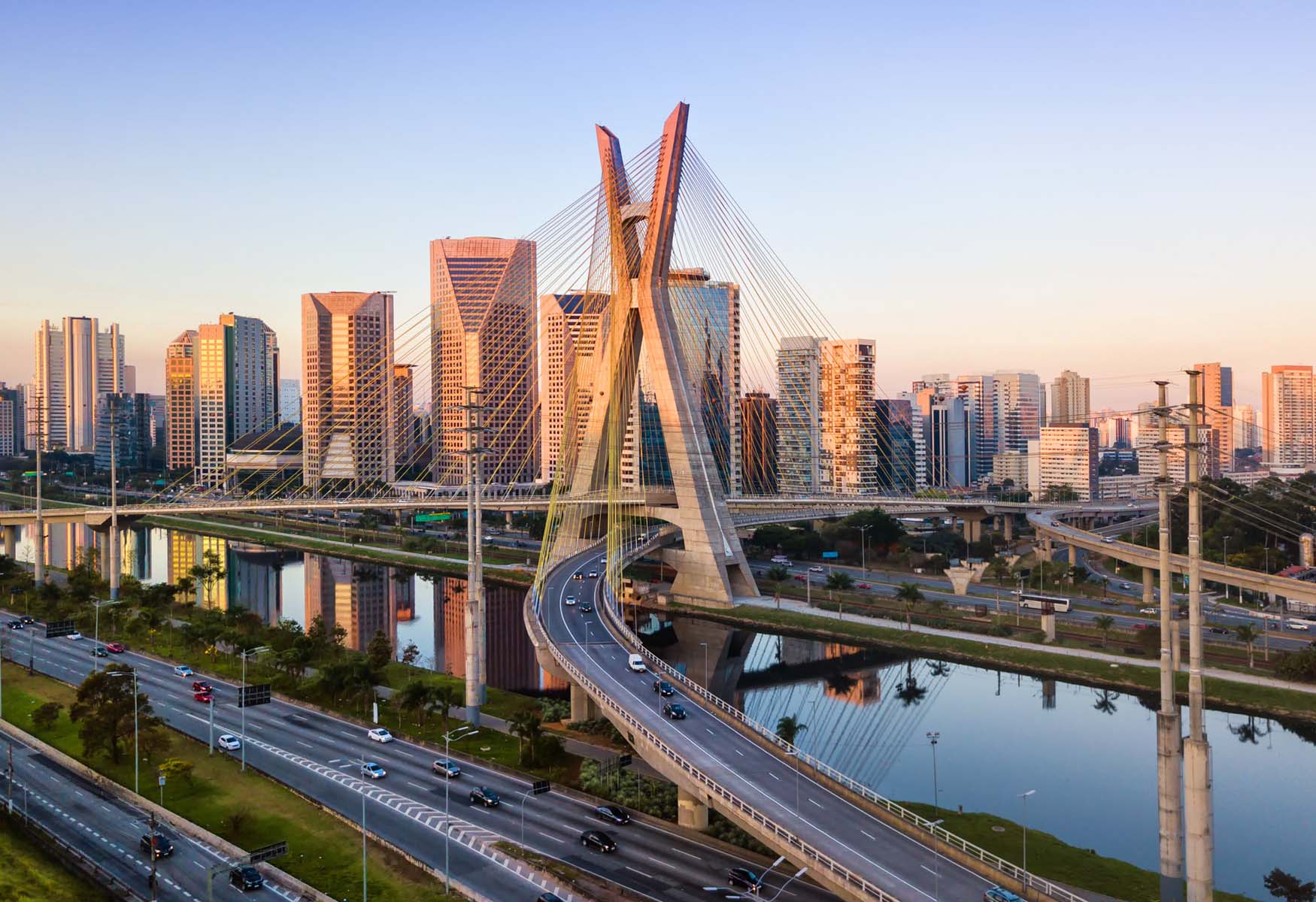
Introduction
Welcome to São Paulo, the bustling metropolis of Brazil known for its vibrant culture, delicious food, and rich history. As you plan your trip to this dynamic city, it’s essential to consider safety as a top priority. São Paulo, like any other major city, has its own set of safety concerns that travelers should be aware of. However, with the right knowledge and precautions, you can have an enjoyable and safe experience exploring all that São Paulo has to offer.
In this article, we will delve into the safety aspects of São Paulo, providing you with valuable insights and insider tips to navigate the city with confidence. From crime rates and neighborhoods to avoid, to safe areas and transportation options, we will cover it all. Additionally, we will discuss personal safety tips, health and medical precautions, and emergency contacts to ensure you are well-prepared for any situation that may arise during your visit.
Remember that while it’s important to be informed about safety, it’s equally important to approach São Paulo with an open mind and embrace the rich culture and experiences that await you. With the right mindset and preparedness, you can make the most of your time in this exciting city.
Safety Overview
When it comes to safety, São Paulo, like any other major city, has its share of concerns. It’s essential to be aware of the potential risks and take necessary precautions to ensure a safe and enjoyable visit. That being said, it’s important to note that millions of tourists visit São Paulo each year without encountering any major issues.
The city has made significant progress in recent years to improve safety measures and reduce crime rates. The local authorities have implemented various initiatives and increased police presence in popular tourist areas to enhance security. However, it’s always wise to stay vigilant and be mindful of your surroundings.
São Paulo is known for its economic disparities, which can contribute to certain safety challenges. The city’s stark contrast between affluent neighborhoods and impoverished areas means that tourists should exercise caution and avoid venturing into unfamiliar or high-crime neighborhoods.
Fortunately, with proper planning and knowledge, you can mitigate potential risks and enjoy a safe experience in São Paulo. This article will provide you with valuable information on crime rates, neighborhoods to avoid, safe areas, transportation safety, personal safety tips, health and medical precautions, and emergency contacts.
Crime Rates in São Paulo
When visiting any city, it’s crucial to have an understanding of the local crime rates to assess the safety situation. São Paulo, being a large urban center, does have a reputation for high crime rates, but it’s important to put things into perspective.
Over the years, the city has implemented various measures to combat crime, resulting in a decline in overall rates. While crimes such as theft, pickpocketing, and petty crimes can occur in tourist areas, they are generally opportunistic and can be avoided with basic precautions.
It’s also worth noting that violent crimes, such as armed robberies and assaults, are relatively rare for tourists. Most incidents of this nature happen within specific neighborhoods, often in areas with higher rates of poverty and social issues.
Like in any major city, it’s advisable to take certain precautions to minimize the risk of being a target for criminal activity. Keep valuable items such as passports, cash, and expensive electronics secured in a hotel safe and avoid displaying flashy jewelry or belongings that could attract unwanted attention.
Additionally, be cautious when withdrawing money from ATMs and try to use machines located in well-lit and crowded areas. It’s also wise to avoid walking alone late at night, especially in unfamiliar or dimly lit areas.
By staying alert, using common sense, and being aware of your surroundings, you can greatly reduce the likelihood of falling victim to petty crimes in São Paulo. It’s important to remember that the majority of visitors to the city have a safe and enjoyable experience, so with the right precautions, you can have peace of mind during your trip.
Neighborhoods to Avoid
While São Paulo has many safe and vibrant neighborhoods, there are a few areas that tourists should exercise caution and avoid. These neighborhoods have higher crime rates and are known for being more dangerous for visitors:
- Centro: The downtown area of São Paulo, known as Centro, can be crowded and chaotic, especially during rush hours. While it’s a bustling commercial district during the day, it’s advisable to be cautious in the evenings as certain parts can become less safe. Avoid dark and isolated areas, and keep a close eye on your belongings.
- Luz: Located in the central part of the city, Luz is home to the Luz Station and Luz Park. While the area has undergone revitalization in recent years, it still has a higher crime rate compared to other parts of the city. Exercise caution when visiting this neighborhood, especially after dark.
- Brás: Brás is a commercial district known for its textile industry, with many shops and markets selling clothing and fabrics. The area can be crowded, making it a potential target for pickpocketing and theft. Stay alert and be mindful of your belongings when visiting Brás.
- Pari: Pari is another neighborhood known for its textile industry and wholesale markets. While it attracts many shoppers, it’s important to remain vigilant in this area, especially during busy times. Avoid displaying valuables and keep your personal belongings secure.
- Glicério: Located near Centro, Glicério is a neighborhood with a higher crime rate. It’s advisable to avoid walking alone in this area, particularly at night. Taking a taxi or rideshare service is a safer option when navigating Glicério.
Remember, this list is not exhaustive, and it’s always a good idea to seek local advice and stay updated on safety recommendations during your visit. While it’s important to be cautious in these neighborhoods, there are many other areas in São Paulo that are safe and perfect for exploring.
Safe Neighborhoods in São Paulo
While there are neighborhoods to avoid in São Paulo, the city is also home to several safe and welcoming areas that provide a great experience for tourists. These neighborhoods are known for their lower crime rates and offer a range of attractions and amenities. Here are some of the safe neighborhoods you can consider during your visit:
- Jardins: One of the most upscale and affluent neighborhoods in São Paulo, Jardins is known for its tree-lined streets, luxury boutiques, trendy restaurants, and art galleries. It boasts a vibrant atmosphere and is considered safe for tourists. It’s a great place for shopping, dining, and experiencing São Paulo’s chic side.
- Vila Madalena: Located in the western part of the city, Vila Madalena is a trendy and bohemian neighborhood known for its vibrant street art, lively bars, and eclectic shops. It’s a popular spot for art enthusiasts, and its vibrant and welcoming atmosphere makes it safe for tourists to explore during the day and at night.
- Itaim Bibi: Situated in the southern region of São Paulo, Itaim Bibi is a thriving business and residential district. It offers upscale dining options, shopping centers, and a lively nightlife scene. With its well-maintained streets and a lower crime rate, Itaim Bibi is considered safe for tourists.
- Brooklin: As one of the wealthiest neighborhoods in São Paulo, Brooklin is known for its modern buildings, wide streets, and high-quality infrastructure. It is home to many corporate offices and luxurious condominiums. The neighborhood has a lower crime rate and offers a safe environment for visitors.
- Morumbi: Located in the southern part of the city, Morumbi is a residential neighborhood known for its upscale houses and condominiums. It is also home to the Morumbi Stadium, where you can catch a football match. With its serene atmosphere and lower crime rates, Morumbi is a safe and peaceful neighborhood for tourists.
These are just a few examples of the safe neighborhoods you can explore while in São Paulo. It’s always a good idea to research specific areas you plan to visit, talk to locals or hotel staff for recommendations, and remain aware of your surroundings to ensure a safe and enjoyable stay in the city.
Transportation Safety
When it comes to getting around São Paulo, it’s important to consider transportation safety. The city offers various options for moving around, each with its own considerations:
Public Transportation: São Paulo has an extensive public transportation system, including buses and a metro network. The metro is generally considered safe and reliable, especially during peak hours. However, it’s advisable to be cautious and keep an eye on your belongings when using public transportation, as crowded buses and stations can be attractive to pickpockets.
Taxis and Rideshares: Taxis and rideshare services like Uber and 99 are popular transportation options in São Paulo. They are generally safe and convenient, especially for traveling late at night or to unfamiliar areas. Always ensure you are using a licensed taxi or a reputable rideshare service, and confirm the driver’s identification and credentials.
Walking: While walking can be a great way to explore certain neighborhoods, it’s important to exercise caution, especially in busy and crowded areas. Stick to well-lit streets, avoid isolated alleyways, and be aware of your surroundings. It’s advisable to use pedestrian crossings when crossing the road and to stay alert for traffic.
Keep Important Contact Information: It’s a good idea to have important contact numbers saved on your phone, such as the local police (190), tourist police (147), and the contact information for your hotel or accommodation. In case of any emergencies or concerns, having these numbers readily available can be helpful.
By being aware of transportation safety measures, utilizing reliable and licensed services, and remaining vigilant during your travels, you can navigate São Paulo’s transportation system with confidence and enjoy hassle-free journeys throughout the city.
Personal Safety Tips
While São Paulo is generally a safe city for tourists, it’s always important to take personal safety precautions. Here are some tips to help ensure your safety during your visit:
- Stay Alert and Be Aware: Pay attention to your surroundings, especially in crowded areas or tourist attractions. Stay alert for any suspicious activity or individuals and trust your instincts. If something doesn’t feel right, it’s better to err on the side of caution.
- Avoid Flashing Valuables: Avoid displaying expensive jewelry, cameras, or electronic devices that could attract unnecessary attention. Keep your valuables stored securely, either in a hotel safe or hidden discreetly on your person.
- Use Reliable Transportation: Stick to licensed taxis, reputable rideshare services, or public transportation options for getting around the city. Avoid using unauthorized or unmarked taxis. If you need to call a taxi, ask your hotel or a trusted establishment to arrange it for you.
- Avoid Walking Alone at Night: It’s generally best to avoid walking alone late at night, particularly in dimly lit or unfamiliar areas. If you need to go somewhere after dark, consider taking a taxi or using rideshare services for your safety and peace of mind.
- Blend In: While exploring the city, try to blend in with the locals to avoid standing out as a tourist. Dress in casual attire and avoid displaying flashy items that could draw unnecessary attention.
- Be Cautious with Your Belongings: Keep a close eye on your belongings at all times, especially in crowded places, public transportation, or tourist attractions. Use a cross-body bag or backpack that is difficult for thieves to grab or cut open.
- Know Emergency Numbers: Save important contact numbers, such as the local police (190), tourist police (147), and the contact information of your embassy or consulate, in case of any emergencies.
By following these personal safety tips and exercising caution, you can minimize the risks and have a safe and enjoyable experience exploring São Paulo.
Health and Medical Safety
Ensuring your health and well-being is essential when traveling to São Paulo. Here are some health and medical safety tips to keep in mind during your visit:
Medical Insurance: Before traveling to São Paulo, make sure you have comprehensive medical insurance coverage. This will give you peace of mind in case of any unforeseen medical emergencies or incidents.
Stay Hydrated: São Paulo can have hot and humid weather, so it’s important to stay hydrated throughout the day. Carry a water bottle with you and drink plenty of fluids to avoid dehydration.
Food and Water Safety: While São Paulo has a thriving culinary scene, it’s important to be cautious about the food and water you consume. Stick to reputable restaurants and establishments that follow proper hygiene standards. Avoid drinking tap water and opt for bottled water instead.
Protect Against Mosquitoes: São Paulo is located in a tropical region, and mosquitoes can be present, especially during certain seasons. Protect yourself by using mosquito repellent and wearing long sleeves and pants, particularly during the evening hours.
Sun Protection: If you plan on spending time outdoors, especially during the peak sun hours, remember to wear sunscreen, sunglasses, and a hat to protect yourself from harmful UV rays.
Prescription Medications: If you require prescription medications, make sure to bring an ample supply for the duration of your trip. It’s also a good idea to carry a copy of your prescription with you in case you need to refill your medication while in São Paulo.
Seek Medical Advice: If you have any specific health concerns or need medical advice, consult with your healthcare provider before traveling to São Paulo. They can provide guidance based on your individual needs.
In the event of a medical emergency, São Paulo has a well-developed healthcare system. You can go to a hospital emergency room or contact your hotel for assistance in finding a nearby medical facility.
By following these health and medical safety tips, you can prioritize your well-being and enjoy a healthy trip to São Paulo.
Emergency Contacts and Services
Knowing the appropriate emergency contacts and services in São Paulo can help you stay prepared and address any urgent situations that may arise during your visit. Here are some important contacts to keep in mind:
Emergency Services:
- Police: Dial 190 to reach the local police in case of emergencies or to report any criminal activities.
- Tourist Police: For assistance specifically aimed at tourists, you can contact the Tourist Police by dialing 147.
- Ambulance: In case of a medical emergency, dial 192 to request an ambulance for immediate assistance.
Embassies and Consulates:
If you are a foreign visitor and require assistance from your embassy or consulate, make a note of the contact information, including the address and phone number. Here are the contacts for a few popular embassies in São Paulo:
- United States Embassy: Phone: +55 11 3250-5000
- United Kingdom Embassy: Phone: +55 11 3094-2700
- Canadian Embassy: Phone: +55 11 5509-4343
- Australian Embassy: Phone: +55 21 3234-5700
- Embassy of New Zealand: Phone: +55 61 3248-9900
Travel Insurance Provider:
If you have travel insurance, keep the contact details of your insurance provider easily accessible. This will allow you to reach out to them in case of any medical emergencies, trip disruptions, or other insurance-related incidents.
It’s also a good idea to inform a trusted person, such as a family member or friend, about your travel plans and provide them with your contact information. This way, they can be contacted in case of any emergencies.
By being aware of these emergency contacts and services, you can have peace of mind knowing that help is just a phone call away if you ever find yourself in need of assistance during your time in São Paulo.
As you plan your journey to São Paulo, it’s important to be aware of safety guidelines and take necessary precautions to ensure a secure and enjoyable trip. São Paulo, like any bustling city, has its own safety considerations that visitors should keep in mind. However, with proper planning, common-sense precautions, and an awareness of your surroundings, you can navigate the city confidently and make the most of your experience.
By understanding the local crime rates, knowing which neighborhoods to avoid, and opting for safe areas to explore, you can minimize potential risks. Utilizing reliable means of transportation, such as licensed taxis or rideshare services, and adhering to personal safety tips can further enhance your safety. It’s essential to prioritize your health and well-being by following food and water safety measures, protecting against mosquitoes, and addressing any medical concerns you may have. Familiarize yourself with emergency contacts and services, enabling you to promptly seek assistance if needed.
São Paulo offers a wealth of cultural experiences, vibrant neighborhoods, and a rich tapestry of history. With the right precautions and a positive mindset, you can fully immerse yourself in the city’s diverse offerings and create lasting memories. Remember, while safety is paramount, embracing São Paulo’s unique charm and friendly atmosphere is equally important.
So, go ahead and embark on your São Paulo adventure with confidence, armed with the knowledge and tips provided in this article. Stay alert, be prepared, and enjoy all that this vibrant metropolis has to offer!
LEAVE A REPLY Cancel reply
Save my name, email, and website in this browser for the next time I comment.
- Privacy Policy
- Advertising
- Affiliate Disclosure
Wanderful - Blog

- South America
How to Travel (Safely + Solo) to Wonderful São Paulo
- Posted by by Milagros Rojas
- July 26, 2021
- 6 minute read
São Paulo is the largest city in South America and it is the perfect example of a cosmopolitan city that manages to be beautiful and modern without losing its authenticity. You can see nature everywhere and that warm spirit is also shared by its inhabitants, the “paulistas”.
I was lucky enough to visit São Paulo and Rio de Janeiro recently, traveling from my home city of Buenos Aires. Based on my experiences, here are my recommendations and insights for other solo women traveling to São Paulo.
São Paulo: A Green Cosmopolitan City
When I first got to São Paulo, one of the first things that struck me is how very green everything is. For a city with such a dense population (12.8 million), incredibly, green trees could be seen everywhere, from highways to breathtaking parks.
A great place to stay in São Paulo is Brooklin. It’s a bit further away from the city’s downtown, but you can still do many things when you are not visiting iconic places such as the Mercado Central. Brooklin — yes, with an “i” — is a more expensive area, but you can find fabulous Airbnbs for great prices!
Brooklin felt very safe and you can tell you are in a higher-end area of the city. The downtown area might not be the best place for you to stay if you want to ensure you will feel as safe as possible.
Safety Concerns for Solo Women Travelers
Now, Brazil has a bad reputation in terms of safety, especially for tourists and especially for women. Due to the dramatic economic inequality in the country, I can understand the concern.
However, I did not feel unsafe at any point during my travels. In fact, I would go on my daily morning walks — which are an essential part of my day — and I never felt threatened or in danger. That said, I always left with just a fanny pack carrying my ID, phone, some money, and my AirPods.
In other destinations I’ve been, wearing my AirPods would’ve been out of the question, but São Paulo felt safe enough that I could do this. Something to keep in mind is that the common type of criminals in Brazil are “ carteristas ”, which usually take stuff out of your bag without you realizing it. Or sometimes, they’ll run by you and take a piece of jewelry you might be wearing and run away. I didn’t encounter either of these situations but was warned to be alert to the possibility.
Read next: Why That List of Safest Places to Travel For Women Is Problematic
Liberdade: Asia in São Paulo
One of the places I was the most curious to visit in São Paulo was Liberdade. This is an entire neighborhood that is known for the huge Asian community living in it. While the majority of residents are Japanese or of Japanese descent, there are also Korean and Chinese residents.
A fun fact: São Paulo has the largest Japanese population outside of Japan!
To get to Liberdade, you can use either public transportation (bus or subway) or get an Uber. I mostly used Ubers to go around São Paulo as they are extremely cheap in Brazil! To give you an idea, a one-hour ride from Guarulhos airport to Brooklin was only $16! However, the public transportation system in São Paulo is the largest in South America and it works very well, too.
Something to keep in mind when walking around Brazil or using the public transportation system is having your purse in front of you. As I said, I never felt unsafe, but this is the best way to avoid pickpockets, which are a known issue in the country as I mentioned before.
You can see parts of Japanese culture everywhere in Liberdade, from the Japanese markets, to banks that look more like a Japanese building than a traditional bank. If you want to try something different and get a taste of Japanese dishes and desserts, this is the right place to do so.
Also, iconic elements such as Hello Kitty are not forgotten, with a coffee shop that is greatly inspired by the beloved character.
Read next: 30 Asian Women Travel Creators to Follow Right Now
Of course, the food was amazing! However, I made the mistake of ordering too much and ended up bringing a lot of food home. The large portion sizes turned out to be common everywhere I went in Brazil, so I found that one dish (no appetizer) was often more than enough for me. This only varied at really high-end restaurants where usually the portions were a bit smaller.
Visit the Lovely Ibirapuera Park
A place that definitely stole my heart in São Paulo was Ibirapuera park. I’m a huge fan of parks, and Ibirapuera Park is huge!
It has beautiful lakes where you can find swans and ducks swimming around. Beware of the bicycles as it’s one of the favorite places where Paulistas — as people from São Paulo are called — often go for a ride.
Now, I’m not a great cyclist, but there were super cheap bike rentals for only $1.50 near Gate 4 (which is also the main entrance to the park). If you want to get a bit of a workout done or simply explore the entire park without getting too tired, this is a great option.
After almost falling a couple of times, I got the hang of it and I had a great time biking around this impressive park. It happened to be a holiday when I visited, so it was especially full. However, I enjoyed my time cycling very much. If you want to have an even better experience I would recommend going during a weekday and making sure it is not a holiday in Brazil!
I promise I only took the mask off for the photos! I was wearing it at all times.
Enjoy the Rooftops – A Must in São Paulo
São Paulo is known for its high buildings and there are many restaurants and hotels with impressive rooftops that allow you to see the entire city.
I went to Adega Santiago, an amazing place with Spanish food that is simply delicious! It’s located on the rooftop of Cidade Jardim, which is one of the more high-end shopping malls in São Paulo.
However, you can find many other rooftops in the city. Choose the one you prefer as long as you get to one of them!
The view is entirely worth it! If you want to spend a bit less, you can go for a drink instead of a fool meal as rooftop restaurants tend to be more expensive.
Mercado Municipal and Centro
Two visits you can do on the same day are to the Mercado Municipal and the city center. I loved going to the Mercado Municipal as it reminded me of markets we used to have in Venezuela, where I grew up. I would go on Sundays with my grandma to get the freshest meats, cheese, and fish. This same experience can be replicated here but multiplied by ten.
The Mercado Municipal in São Paulo is huge! They will sell you everything from delicious tropical fruits to nuts and almonds. There are also restaurants inside the market, where they sell the famous bologna sandwich.
You’ll also see the Brazilian version of an empanada: the pastel . You can find them everywhere in the country with a multitude of fillings. Here, I ordered a pepperoni pastel, which came with cheese — as most of them do — and it was delicious! If you go to Rio or any beach city, get a shrimp pastel. They are simply amazing!
Most places in the market will also give you a free appetizer after you order. I received a complimentary sample of the salami made by the owners of the restaurant, called Di Callani.
Something you’ll see everywhere in Brazil are these coolers to make sure your beer does not get warm. They are amazing because many brands in Brazil offer 600ml bottles and this way, it doesn’t lose that refreshing coolness. Plus, it’s more appropriate for the Brazilian heat.
As a helpful tip, at the market, keep in mind that tourist traps are everywhere. So make sure you ask for prices before you start ordering stuff! I fell for the trap at a fruit stand where my lack of Portuguese did not do me any favors. Also, bartering is ok and more than encouraged, so try to get the best possible price while you are here.
After visiting the Mercado, you can go to another area of the city center, called Sete de Abril. There is a multitude of stores and street markets which sell everything under the sun. You can find entire galleries of camera stores, clothing stores, and more.
You can also find beautiful buildings, such as the Municipal Theater, which has very classic architecture, especially compared with the high buildings that comprise most of São Paulo.
My Thoughts on Visiting São Paulo
I continued my visit to Brazil from São Paulo to Rio de Janeiro. While the country has a bad reputation, I did not have any safety concerns. In fact, I said to some of my friends later, if I spoke Portuguese and immigration matters were as easy as in Argentina, I could consider spending half a year in São Paulo. That’s how much I loved the city!
Obrigada, São Paulo!
Feature image by Luciano Teixeira from Pixabay
Looking for travel inspiration? Wanderful is a global community for travel-loving women. Connect with us !
Milagros Rojas
I’m an M.D., freelance writer, and avid traveler, looking to get to know as much of the world as possible. I enjoy sharing my experiences with people who love to travel as much as I do!
Post navigation

Follow These 25 Plus Size Travel Creators Right Now

5 Awesome Online Events in August for Travel Lovers & Creators
You might like....

- Global Issues
Meet the Brazilian Photographer Advocating for Women via Nude Photography
- Posted by by Helene Doetsch

How to Travel with a Food Allergy
- Posted by by Emily White
- 7 minute read

Got Debt? Move Abroad and Pay off Your Student Loans in These 5 Countries
- Posted by by Katelyn Michaud
- 5 minute read
Leave a Comment
Leave a reply cancel reply.
Your email address will not be published. Required fields are marked *
How safe is São Paulo, Brazil?
- Overall Risky
- Tourism Risky
- At night Unsafe
- Solo female Moderate
- LGBTQ+ Safe
- Muslim Safe
São Paulo is a city of contrasts, with vibrant culture and stunning architecture on the one hand, and considerable crime on the other. Understanding the complexities of safety in this city is crucial for anyone planning a visit.
While São Paulo boasts some very safe neighborhoods, it also has areas that are best avoided, especially at night. As a general rule, it’s important to stay vigilant and take precautions to minimize the risk of becoming a victim of crime. This includes being aware of your surroundings, avoiding isolated areas, and not carrying large amounts of cash or displaying valuables.
Taxis, ride-sharing services, or designated drivers should always be used for transportation, as public transit can sometimes be a target for petty crime. Avoiding wearing expensive jewelry or clothing, especially in touristy areas, can also help to deter potential criminals.
Is São Paulo safe for tourists?
When traveling to São Paulo, it’s crucial to prioritize safety to ensure a smooth and enjoyable experience. While the city offers many exciting attractions, it’s important to be aware of certain risks and take necessary precautions to mitigate them.
One of the most important safety measures is to avoid isolated areas, especially at night. Stick to well-lit and populated areas, and be vigilant about your surroundings. If you need to travel alone, consider using a ride-sharing service or a reputable taxi company rather than hailing a taxi on the street.
Additionally, be cautious of your belongings and personal safety. Keep your valuables secure, avoid displaying expensive jewelry or electronics, and be wary of strangers approaching you on the street, especially if they are trying to sell you something or asking for money. If you sense something is amiss, trust your instincts and remove yourself from the situation promptly.
While petty crime is a concern in São Paulo, violent crime against tourists is relatively rare. However, it’s still essential to exercise caution and take all necessary measures to minimize the risk of becoming a victim of any crime. By following these safety tips, you can help ensure a safe and enjoyable trip to São Paulo.
How safe is São Paulo at night?
When it comes to safety in São Paulo at night, it’s essential to exercise heightened caution and avoid certain behaviors or situations that might increase your risk of becoming a victim of crime. This includes walking alone in dimly lit or deserted areas, especially after dark. If possible, try to travel with a companion or group, stay in well-lit and populated areas, and be mindful of your surroundings.
While ride-sharing services like Uber or 99 are generally safe and reliable, it’s important to check the ratings and reviews of your driver before accepting the ride. Avoid hailing taxis on the street, as they may not be registered or licensed, and instead opt for reputable taxi companies or apps.
Furthermore, be vigilant about your belongings and personal safety. Keep your valuables secure, avoid displaying expensive jewelry or electronics, and be cautious of strangers approaching you on the street, especially if they are trying to sell you something or asking for money. If you sense something is amiss, trust your instincts and remove yourself from the situation promptly.
Is it safe to travel to São Paulo as a solo female?
Traveling to São Paulo as a solo female requires extra caution and awareness. The city has a moderate crime rate, and while violent crime against tourists is relatively rare, petty crime such as pickpocketing and mugging can occur.
To minimize the risk of becoming a victim, avoid isolated areas, especially at night. Stick to well-lit and populated areas, and be vigilant about your surroundings. If you need to travel alone, consider using a ride-sharing service or a reputable taxi company rather than hailing a taxi on the street.
Be cautious of your belongings and personal safety. Keep your valuables secure, avoid displaying expensive jewelry or electronics, and be wary of strangers approaching you on the street, especially if they are trying to sell you something or asking for money. If you sense something is amiss, trust your instincts and remove yourself from the situation promptly.
While these precautions may seem restrictive, they are essential for ensuring a safe and enjoyable trip to São Paulo. By following these tips, solo female travelers can minimize the risk of becoming a victim of crime and have a positive experience in this vibrant city.
How safe is São Paulo for LGBTQ+ travelers?
While São Paulo is generally considered a safe city for LGBTQ+ travelers, it’s important to be aware of certain precautions to ensure a smooth and enjoyable trip. The city has a vibrant and welcoming LGBTQ+ community, but there can still be instances of discrimination or harassment, particularly in certain areas or situations.
To minimize the risk of encountering any issues, it’s advisable to avoid public displays of affection with your partner, especially in conservative or religious neighborhoods. While same-sex relationships are legal and recognized in Brazil, social attitudes can vary, and it’s best to be cautious in public spaces.
When choosing accommodations, consider staying in LGBTQ+-friendly hotels or guesthouses to ensure a more inclusive and supportive environment. Additionally, it’s recommended to research and visit LGBTQ+-friendly bars, clubs, and events to connect with the local community and have a more fulfilling experience.
By being mindful of local customs and taking necessary precautions, LGBTQ+ travelers can navigate São Paulo safely and enjoy the city’s diverse and vibrant offerings.
How safe is São Paulo for muslims?
Due to its significant Muslim population, São Paulo offers a welcoming environment for Muslim travelers. The city boasts numerous mosques and Islamic cultural centers, catering to the spiritual and communal needs of the Muslim community. While São Paulo is generally safe, it’s essential to be aware of certain cultural nuances and take precautions to ensure a smooth and fulfilling trip.
When visiting mosques or religious sites, it’s advisable to dress modestly and respectfully, in accordance with local customs. Additionally, during the holy month of Ramadan, it’s important to be mindful of local fasting practices and refrain from eating or drinking in public during daylight hours.
To fully immerse in the local Muslim community, consider visiting Islamic markets or halal restaurants, where you can savor delicious cuisine and connect with fellow Muslims. By engaging with the local community, you can gain a deeper understanding of Islamic culture and traditions while creating meaningful connections.
Overall, São Paulo is a vibrant and diverse city that welcomes Muslim travelers with open arms. By being respectful of local customs and taking necessary precautions, Muslim travelers can navigate the city safely and enjoy its many offerings, fostering a sense of belonging and community.
Last updated February 2024

Is São Paulo Safe?
São Paulo is generally safe for tourists , but petty crime like pickpocketing and bag snatching is common, especially in crowded areas. Violent crime also occurs, so avoid isolated areas and use trusted transportation at night. Civil unrest with protests can disrupt travel plans. Remain vigilant and follow local advisories. Medical facilities are generally good, but insect-borne diseases like dengue and Zika are risks.
Download Vigilios
Your Pocket-Sized Travel Safety Guide
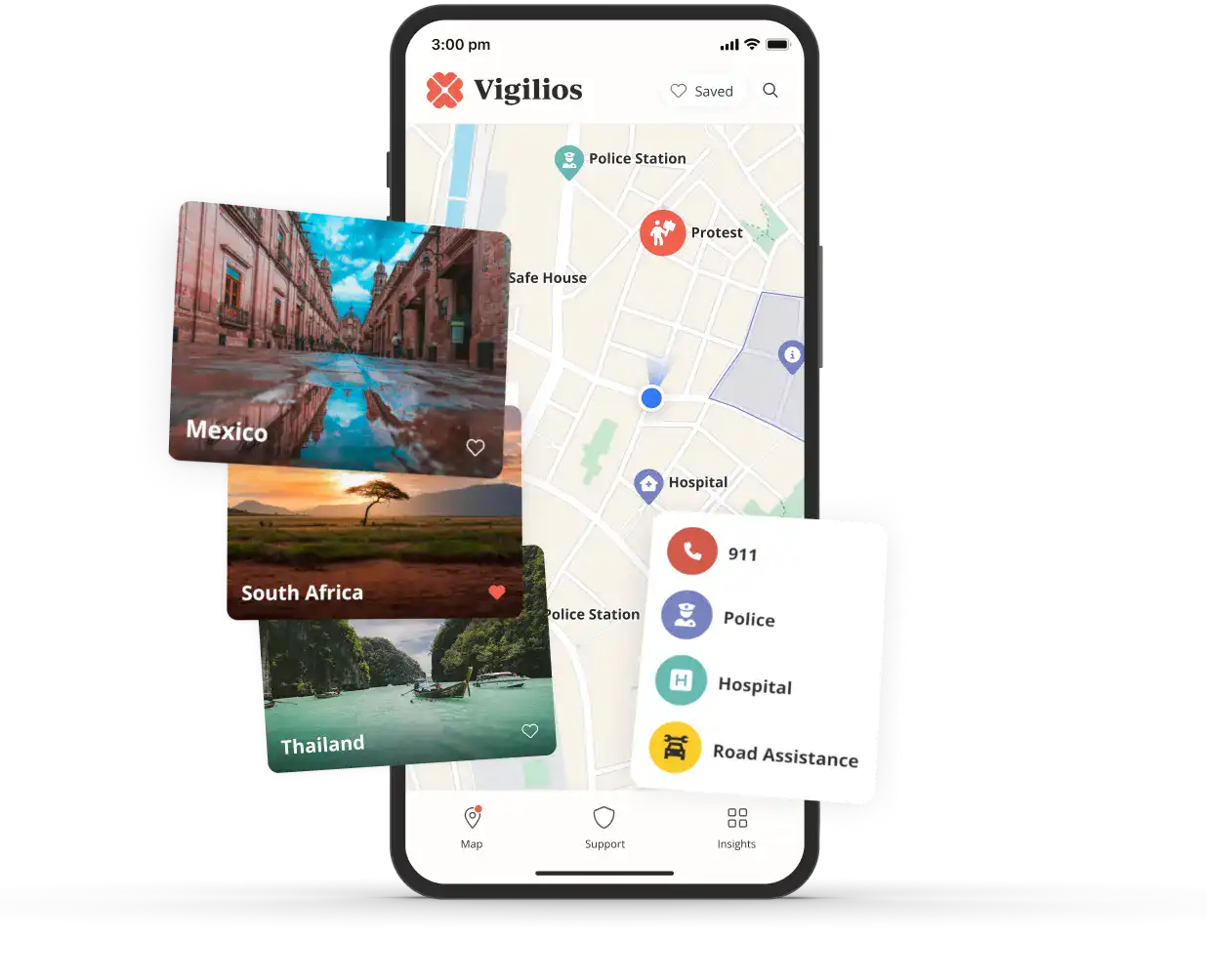
Safety & Security
São Paulo, Brazil's vibrant metropolis, offers an exciting blend of urban energy and cultural richness, but travelers should exercise caution due to elevated crime rates. While most tourist areas are generally safe during the day, it's advisable to remain vigilant and take precautions.
Petty Crime : Pickpocketing, bag snatching, and theft from vehicles are common, especially in crowded areas like public transportation, markets, and tourist hotspots. Remain aware of your surroundings and keep valuables secure.
Violent Crime : While not widespread, incidents of armed robbery, carjacking, and express kidnappings do occur, particularly at night or in isolated areas. Avoid displaying expensive items and be cautious when withdrawing cash from ATMs.
Scams : Be wary of common scams, such as fake taxi drivers, overcharging, or individuals offering unsolicited help or services. Only use licensed taxis or ride-sharing services.
Civil Unrest : Protests and demonstrations can occur, sometimes leading to clashes with authorities. Monitor local news and avoid areas where large gatherings are taking place.
Terrorism : While the risk is low, terrorist attacks cannot be ruled out in major cities like São Paulo. Remain vigilant in crowded public spaces and follow the advice of local authorities.
It's recommended to research areas before visiting , avoid isolated or known high-risk neighborhoods, especially at night, and exercise caution when using public transportation or walking alone. Familiarize yourself with your surroundings and trust your instincts if a situation feels unsafe.
Health & Medical
São Paulo is a bustling metropolis with a population of over 12 million, and travelers should take some health precautions. While the city has excellent medical facilities, there are some health risks to be aware of.
Vaccinations : Ensure routine vaccinations are up-to-date, including those for hepatitis A, hepatitis B, and typhoid. Yellow fever vaccination is recommended for certain areas of Brazil.
Insect-Borne Diseases : Zika, dengue, and chikungunya viruses are present in São Paulo. Use insect repellent, wear long sleeves and pants, and stay in air-conditioned or well-screened areas.
Air Pollution : São Paulo has high levels of air pollution, especially during rush hours. Those with respiratory conditions should take precautions and limit outdoor activities during peak pollution times.
Water and Food Safety : Drink only bottled or purified water and avoid raw or undercooked food to prevent traveler's diarrhea and other foodborne illnesses.
Medical Facilities : São Paulo has world-class medical facilities, but costs can be high. Ensure you have comprehensive travel health insurance and access to funds for medical emergencies.
Natural Disasters
São Paulo, Brazil's vibrant metropolis, is generally not prone to major natural disasters. However, travelers should be aware of the following potential risks:
Flooding : The city experiences heavy rainfall during the summer months (December to March), which can lead to localized flooding, especially in low-lying areas. It's advisable to monitor weather reports and avoid flooded areas.
Landslides : Intense rainfall can also trigger landslides in some of São Paulo's hilly neighborhoods, particularly in areas with poor infrastructure or informal settlements. Exercise caution when hiking or exploring these areas during the rainy season.
Thunderstorms : São Paulo is susceptible to severe thunderstorms, which can bring strong winds, heavy rain, and occasional hail. These storms can disrupt transportation and outdoor activities, so it's wise to seek shelter when they occur.
Earthquakes : While not a major risk, São Paulo is located in a region with moderate seismic activity. Minor tremors are possible but rarely cause significant damage.
Drought : Prolonged periods of drought can lead to water shortages, which may affect the availability of water in some areas. Travelers should stay informed about any water conservation measures in place during their visit.
Overall, São Paulo has a well-developed infrastructure and emergency response systems in place to handle most natural hazards. However, it's always advisable to stay vigilant, follow local advisories, and take necessary precautions during adverse weather conditions or natural events.
Transportation
São Paulo has an extensive public transportation system, including metro, buses, and trains. However, it's important to exercise caution when using these services, especially during rush hours or late at night.
- The metro system is generally safe and efficient, but crowding and petty crime can occur, so remain vigilant and keep valuables secure.
- Buses can be overcrowded and subject to traffic delays. Exercise caution when boarding and exiting, and avoid isolated bus stops, especially at night.
- Taxis are widely available, but it's advisable to use reputable companies or ride-sharing apps to avoid scams or unsafe vehicles.
Road safety is a concern in São Paulo due to heavy traffic, aggressive driving, and poorly maintained roads in some areas.
- Pedestrians should exercise extreme caution when crossing streets and use designated crosswalks whenever possible.
- If renting a car, familiarize yourself with local traffic laws and drive defensively.
- Avoid driving at night if possible, as poorly lit roads can increase the risk of accidents.
Overall, while São Paulo's transportation options are extensive, travelers should remain vigilant and take necessary precautions to ensure a safe and enjoyable experience.
Cultural Norms
São Paulo is a vibrant and diverse city, home to a rich cultural tapestry. As a traveler, it's essential to respect local customs and traditions to ensure a smooth and enriching experience. Here are some key points to keep in mind:
Greetings : Brazilians generally greet each other with a handshake or a kiss on the cheek, depending on the level of familiarity. It's polite to greet people when entering a room or establishment.
Dress Code : While São Paulo is a cosmopolitan city, it's advisable to dress modestly, especially when visiting religious sites or more conservative areas. Avoid revealing clothing that could be seen as disrespectful.
Public Displays of Affection : Public displays of affection, such as kissing or intimate embraces, are generally frowned upon and should be kept to a minimum.
Punctuality : Brazilians have a more relaxed attitude towards time, and it's common for events and appointments to start later than scheduled. However, it's still advisable to arrive on time as a sign of respect.
Gestures : Be mindful of certain gestures that may have different meanings in Brazilian culture. For example, the "OK" sign made with the thumb and index finger is considered offensive.
Festivals and Events : São Paulo hosts numerous festivals and events throughout the year, many of which have cultural or religious significance. Respecting local traditions and participating in these events can provide a deeper understanding of the city's rich heritage.
Language : While English is spoken in tourist areas, learning a few basic Portuguese phrases can go a long way in showing respect and facilitating communication with locals.
Remember, cultural sensitivity is key to fostering understanding and building meaningful connections during your travels in São Paulo.
Emergency Services
São Paulo has a well-established emergency services infrastructure, though response times can vary depending on the location and severity of the incident. The city has a dedicated emergency number (192) for police, fire, and ambulance services, which are generally reliable and staffed by trained professionals. However, language barriers may pose a challenge for non-Portuguese speakers.
Emergency Services : Police, fire, and ambulance services are available through the emergency number 192. Response times can be slower in more remote areas or during peak hours.
Tourist Police : The city has a specialized Tourist Police (Policia Turística) unit trained to assist visitors. They can provide support in multiple languages and are stationed in major tourist areas.
Private Security : Many hotels, shopping malls, and tourist attractions employ private security personnel who can assist in emergencies or provide guidance on contacting appropriate services.
Medical Facilities : São Paulo has several well-equipped hospitals and clinics, including some that cater specifically to international travelers. However, quality can vary , and language barriers may be an issue at some facilities.
It's advisable for travelers to research and familiarize themselves with the emergency services available in their specific area and to carry contact information for their embassy or consulate in case of emergencies.
Frequently Asked Questions
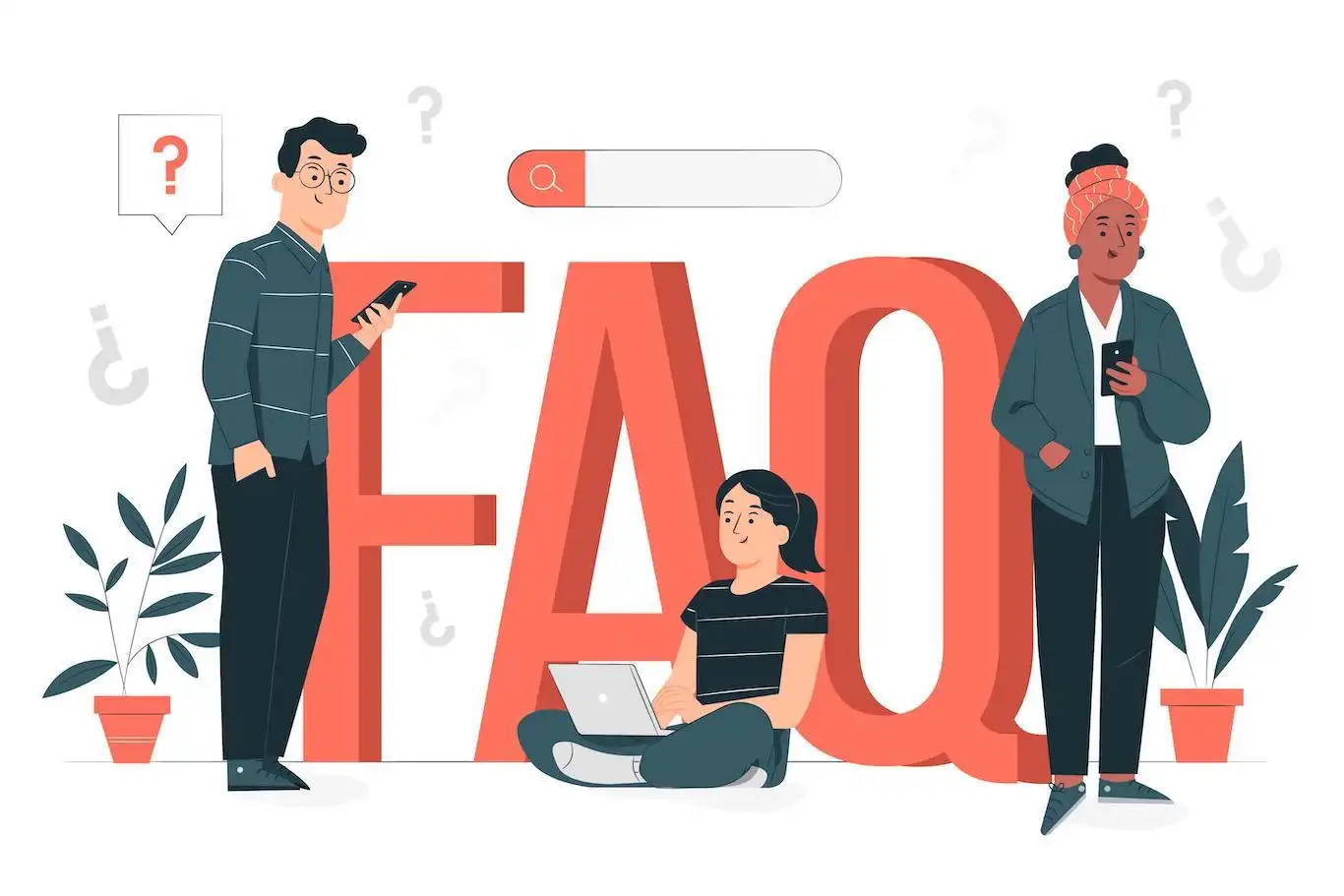
Is São Paulo safe for tourists?
São Paulo is generally safe for tourists, but caution is advised in certain areas. Stick to well-lit and populated areas, avoid carrying valuables, and use licensed taxis or ride-sharing services. Be vigilant, especially at night, and follow common-sense safety precautions.
Is São Paulo safe for solo female travelers?
While São Paulo is relatively safe for solo female travelers, it's advisable to exercise caution. Avoid walking alone at night, dress conservatively, and be aware of your surroundings. Use trusted transportation services and stay in well-lit, populated areas.
Is São Paulo safe for families?
São Paulo can be a family-friendly destination with proper precautions. Stick to tourist areas, use licensed transportation, and be cautious with children in crowded places . Many attractions, parks, and restaurants cater to families.
Is São Paulo LGBTQ+ friendly?
São Paulo is generally LGBTQ+-friendly , with a vibrant community and annual Pride events. However, public displays of affection may draw unwanted attention in some areas. Same-sex marriage is legal in Brazil.
Do you need a visa to go to São Paulo?
Visitors from most Western countries, including the United States, Canada, and the European Union, do not need a visa for stays up to 90 days . However, a valid passport is required for all international travelers.
Can you drink tap water in São Paulo?
It's advisable to avoid drinking tap water in São Paulo . Stick to bottled or filtered water, even for brushing teeth. Tap water is generally safe for showering and washing dishes.
What is the currency in São Paulo?
The official currency in São Paulo and throughout Brazil is the Brazilian Real (BRL) . Major credit cards are widely accepted, but it's advisable to carry some cash for smaller purchases.
Brazil Travel Advisory
The following government travel advisories provide additional helpful resources for your destination to stay safe and informed.
- 🇺🇸 Travel Advisory by the United States Government
- 🇨🇦 Travel Advisory by the Government of Canada
- 🇬🇧 Travel Advisory by the U.K. Government
- 🇦🇺 SmartTraveller - Travel Advisory by the Australian Government
Related Content

🇧🇷 Brazil
Brazil is generally safe for tourists , but crime remains a concern, especially in major cities like Rio de Janeiro and São Paulo. Petty theft, robberies, and violent crimes do occur, so remain vigilant and avoid isolated areas, particularly at night. Political protests and civil unrest can disrupt travel plans, so monitor local news. While natural disasters like floods and landslides are risks in some regions, following official advisories can help mitigate dangers.

🇧🇷 Belo Horizonte, Brazil
Belo Horizonte is generally safe for tourists , but caution is advised. Petty crime like pickpocketing and bag snatching occurs, so remain vigilant in crowded areas. Violent crime rates are moderate , but avoid isolated areas at night. Medical facilities are adequate , but insect-borne diseases like dengue and Zika are risks. Monitor weather advisories for potential flash floods during the rainy season.

🇧🇷 Boa Vista, Brazil
Boa Vista is generally safe for tourists , though petty crime like pickpocketing is common. Violent crime rates are relatively low , but disputes can escalate quickly. Insect-borne diseases like dengue fever and Zika are risks, so take preventative measures . The city has decent medical facilities , but services may be limited. Natural disasters are uncommon, but the region can experience severe droughts .

🇧🇷 Brasília, Brazil
Brasília is generally safe for travelers , though petty crime like pickpocketing is common in crowded areas. Violent crime rates are relatively low , but remain vigilant at night. Civil unrest occasionally occurs during protests near government buildings. Medical facilities are adequate , but insect-borne diseases like dengue fever and Zika virus pose health risks . Extreme weather is rare , but heavy rains can cause flash flooding.


🇧🇷 Florianópolis, Brazil
Florianópolis is generally safe for tourists, with petty crime being the primary concern. Violent crime rates are low , but remain vigilant in crowded areas and at night. The city experiences minimal political tension or civil unrest. Insect-borne diseases like dengue fever and Zika are risks, so use repellent. Natural disasters are rare, but heavy rainfall can cause flooding . Public transportation is reliable but exercise caution when driving due to aggressive driving habits.

🇧🇷 Macau, Brazil
Macau, a special administrative region of China, is generally safe for travelers. However, petty crimes like pickpocketing and bag snatching can occur in crowded areas. Violent crimes targeting tourists are rare. Visitors should remain vigilant , especially at night, and avoid carrying valuables openly. Macau has a low risk of natural disasters, and its public transportation system is efficient and secure. Respecting local customs and dressing modestly when visiting religious sites is advisable.

🇧🇷 Manaus, Brazil
Manaus has a higher crime rate compared to other Brazilian cities, with risks of muggings, robberies, and violent disputes . Petty crimes like pickpocketing are common in tourist areas. While terrorism threats are low , travelers should avoid protests and demonstrations due to potential civil unrest . Hiring licensed tour guides and staying in secure accommodations can mitigate risks. Remaining vigilant and following local advisories is crucial for a safe visit.

🇧🇷 Rio de Janeiro, Brazil
Rio de Janeiro has a high crime rate , with risks of muggings , armed robberies , and gang violence in certain areas. Tourists should avoid favelas , use licensed taxis , and leave valuables in hotel safes . Political protests can turn violent, so monitor local news. While petty crime is common on beaches, taking basic precautions like not carrying excessive cash or jewelry can mitigate risks. Hiring a reputable local guide is advisable for exploring the city safely.

🇧🇷 Santa Rosa, Brazil
Santa Rosa in Brazil is generally safe for tourists , though petty crime like pickpocketing is common in crowded areas. Violent crime rates are moderate , but tourists should avoid isolated areas at night. The city experiences occasional protests , so remain vigilant during civil unrest. Mosquito-borne illnesses like dengue fever and Zika virus are risks, so use insect repellent. Natural disasters like floods can disrupt transportation during rainy seasons.
Download the App
Map, insights & support - vigilios is your personal safety companion.

Security Alert May 17, 2024
Worldwide caution, update may 10, 2024, information for u.s. citizens in the middle east.
- Travel Advisories |
- Contact Us |
- MyTravelGov |
Find U.S. Embassies & Consulates
Travel.state.gov, congressional liaison, special issuance agency, u.s. passports, international travel, intercountry adoption, international parental child abduction, records and authentications, popular links, travel advisories, mytravelgov, stay connected, legal resources, legal information, info for u.s. law enforcement, replace or certify documents.
Share this page:
Brazil Travel Advisory
Travel advisory october 19, 2023, brazil - level 2: exercise increased caution.
Reissued with updates to Country Summary.
Exercise increased caution in Brazil due to crime . Some areas have increased risk. Read the entire Travel Advisory.
Do not travel to:
- Any areas within 150 km/100 miles of Brazil’s land borders with Venezuela, Colombia, Peru, Bolivia, Guyana, Suriname, French Guiana, and Paraguay due to crime . (Note: This does not apply to the Foz do Iguacu National Park or Pantanal National Park.)
- Informal housing developments (commonly referred to in Brazil as favelas, vilas, comunidades, and/or conglomerados) at any time of day due to crime (see additional information below).
- Brasilia’s administrative regions (commonly known as “satellite cities”) of Ceilandia, Santa Maria, Sao Sebastiao, and Paranoa during non-daylight hours due to crime (see additional information below).
Country Summary: Violent crime, such as murder, armed robbery, and carjacking, is common in urban areas, day and night. Gang activity and organized crime is widespread. Assaults, including with sedatives and drugs placed in drinks, are common. U.S. government personnel are discouraged from using municipal buses in all parts of Brazil due to an elevated risk of robbery and assault at any time of day, and especially at night.
If you decide to travel to Brazil:
- Be aware of your surroundings.
- Do not physically resist any robbery attempt.
- Do not accept food or drinks from strangers.
- Use caution when walking or driving at night.
- Avoid going to bars or nightclubs alone.
- Avoid walking on beaches after dark.
- Do not display signs of wealth, such as wearing expensive watches or jewelry.
- Be extra vigilant when visiting banks or ATMs.
- Use caution at, or going to, major transportation centers or on public transportation, especially at night. Passengers face an elevated risk of robbery or assault using public, municipal bus transportation throughout Brazil.
- Use increased caution when hiking in isolated areas.
- Enroll in the Smart Traveler Enrollment Program (STEP) to receive Alerts and make it easier to locate you in an emergency.
- Follow the Department of State on Facebook and Twitter .
- Review the Country Security Report for Brazil.
- Prepare a contingency plan for emergency situations. Review the Traveler’s Checklist .
- Visit the CDC page for the latest Travel Health Information related to your travel.
International Borders – Level 4: Do Not Travel
U.S. government personnel are not permitted to travel to areas within 150 km/100 miles of the international land borders with Venezuela, Colombia, Peru, Bolivia, Guyana, Suriname, French Guiana, and Paraguay without advance approval from security officials due to crime. Travel to the Foz do Iguacu National Park and Pantanal National Park is permitted.
Visit our website for Travel to High-Risk Areas .
Informal Housing Developments (commonly known as “Favelas”) – Level 4: Do Not Travel
Do not travel to informal housing developments (commonly referred to in Brazil as favelas, vilas, comunidades, and/or conglomerados), even on a guided tour. Neither the tour companies nor the police can guarantee your safety when entering these communities. Even in these communities that the police or local governments deem safe, the situation can change quickly and without notice. While some informal housing developments have clear boundaries or gates, or even names such as “favela”, “vila”, “comunidade”, or “conglomerado”, other such developments may be less obvious, and may be identified by crowded quarters, poorer conditions, and/or irregular construction. In addition, exercise caution in areas surrounding these communities, as occasionally, inter-gang fighting and confrontations with police move beyond the confines of these communities. Except under limited circumstances and with advance approval, U.S. government personnel are not permitted to enter any informal housing developments in Brazil. Read the Safety and Security Section on the country information page and consult the maps on the Embassy’s website for further information regarding favelas.
Visit our website for Travel High-Risk Areas .
Brasilia’s Administrative Regions (commonly known as “Satellite Cities”) – Level 4: Do Not Travel
Without advance approval from security officials, U.S. government personnel are not permitted to travel to Brasilia’s Administrative Regions of Ceilandia, Santa Maria, Sao Sebastiao, and Paranoa between the hours of 6:00 p.m. and 6:00 a.m. (non-daylight hours) due to crime.
Travel Advisory Levels
Assistance for u.s. citizens, search for travel advisories, external link.
You are about to leave travel.state.gov for an external website that is not maintained by the U.S. Department of State.
Links to external websites are provided as a convenience and should not be construed as an endorsement by the U.S. Department of State of the views or products contained therein. If you wish to remain on travel.state.gov, click the "cancel" message.
You are about to visit:
- Visit Oyster on Facebook!
- Visit Oyster on Pinterest!
- Visit Oyster on Instagram!
- Visit Oyster on Twitter!
- Subscribe to stay up to date!
Yes, send me expert tips and deals!
By proceeding, you agree to our Privacy Policy and Terms of Use .
- Subtract one room 1 Rooms Add one room
- Subtract one adult 2 Adults Add one adult
14 Rookie Mistakes to Avoid in Sao Paulo
See recent posts by Anne Olivia Bauso
Sao Paulo is one of the biggest cities on the planet, but there’s so much more to it than sheer size and sprawl. The city’s cosmopolitan residents and visitors enjoy some of the best shopping, dining, and nightlife in the world. Life is stylish here: Sao Paulo’s art scene is second to none, its entertainment and recreation options seem infinite, and its pace is fast. Your trip to the mega-city will certainly go smoother if you know what pitfalls to avoid. Here, we tell you what not to do in Sao Paulo.
Need more Brazil inspiration? Here's the perfect 10-day Brazil itinerary .
1. Thinking Sao Paulo is a walker’s city.
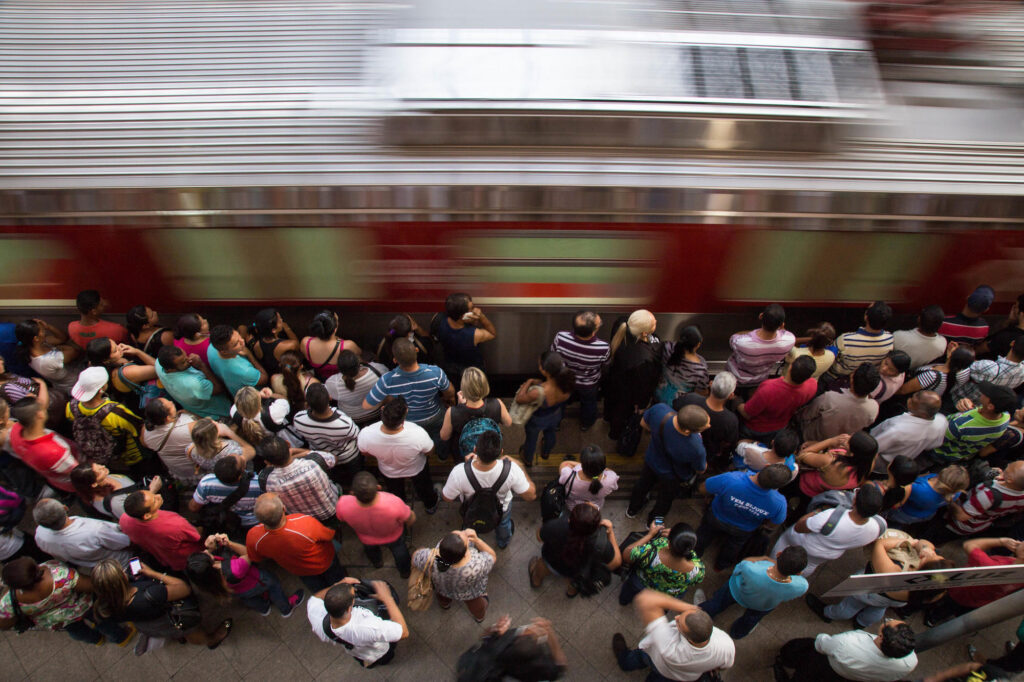
Subway in Sao Paulo/Oyster
Sao Paulo is not a city you can explore easily on foot. For one thing, the heat will exhaust even the most intrepid walkers, so a dip in the AC of a car of subway will be a blessed relief. Second, at 576 square miles, Sao Paulo sprawls to nearly double the size of New York City. Pockets of the city (the impressive stretch of Avenida Paulista and neighborhood enclaves) are certainly lovely to walk around, but plan on a vehicle or subway to get from point to point.
2. Renting a car in Sao Paulo.
Booking a rental car for Sao Paulo isn’t the way to go for most visitors — driving is defined by crazy traffic, limited parking, and fearless fellow drivers. Uber is extremely popular and ridiculously cheap in Sao Paulo — far cheaper than taxis. Sao Paulo’s system of six color-coded subway lines is easy, reliable, and safe. Buses are plentiful but tough to navigate if you don’t know Portuguese. Stick to the subway or Uber in Sao Paulo.
3. Expecting natural beauty in Sao Paulo.
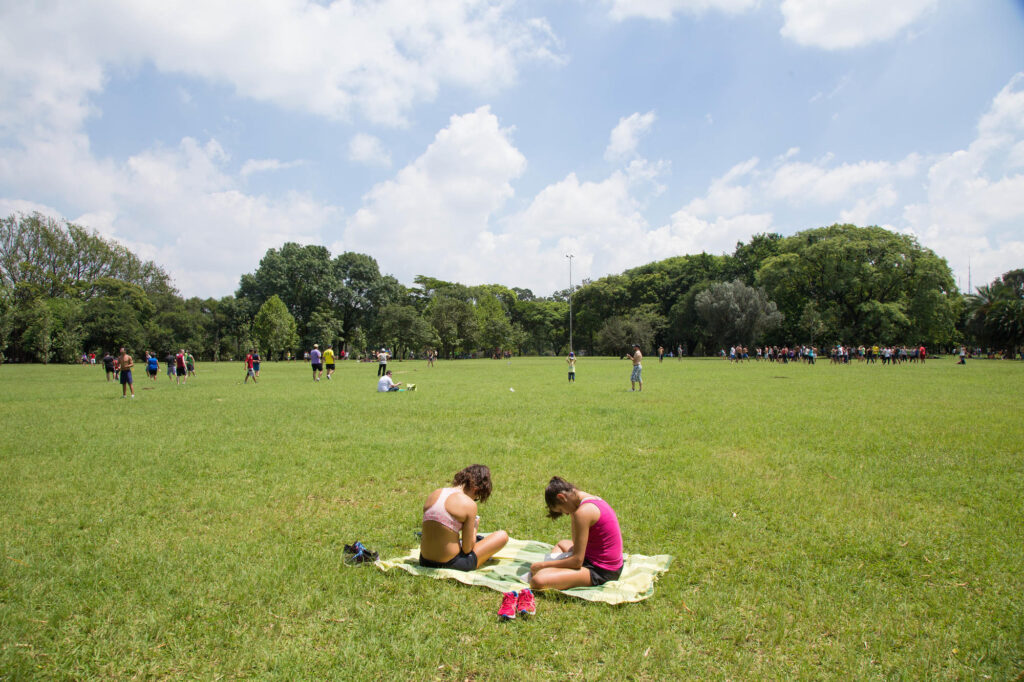
Ibirapuera Park/Oyster
Sao Paulo is very much not Rio . While Rio has some of the most distinctive and gorgeous scenery of any city on earth, Sao Paulo is inland (no beautiful beaches) and mostly flat (no striking mountains, no jungle-covered hills). There are swaths of beautiful greenery, such as Trianon Park, a shady patch of native forest, and large Parque Ibirapuera — SP’s version of New York’s Central Park — complete with ponds, bridges, and cultural sites like museums and a planetarium. Just don’t expect the sort of staggering natural features of Rio.
4. Staying outside of Sao Paulo’s central areas.
While booking accommodations outside of the central area works for some destinations (like Brooklyn for a New York trip or Oakland for a San Francisco trip), it’s in travelers’ best interests to stay central in Sao Paulo . Getting around Sao Paulo is a major time suck and will very likely prevent visitors from maximizing their precious hours in the city. Our advice? Pick one of the 50-plus hotels in the tourist-friendly Paulista and Jardins areas.
5. Not asking for a high room in Sao Paulo.
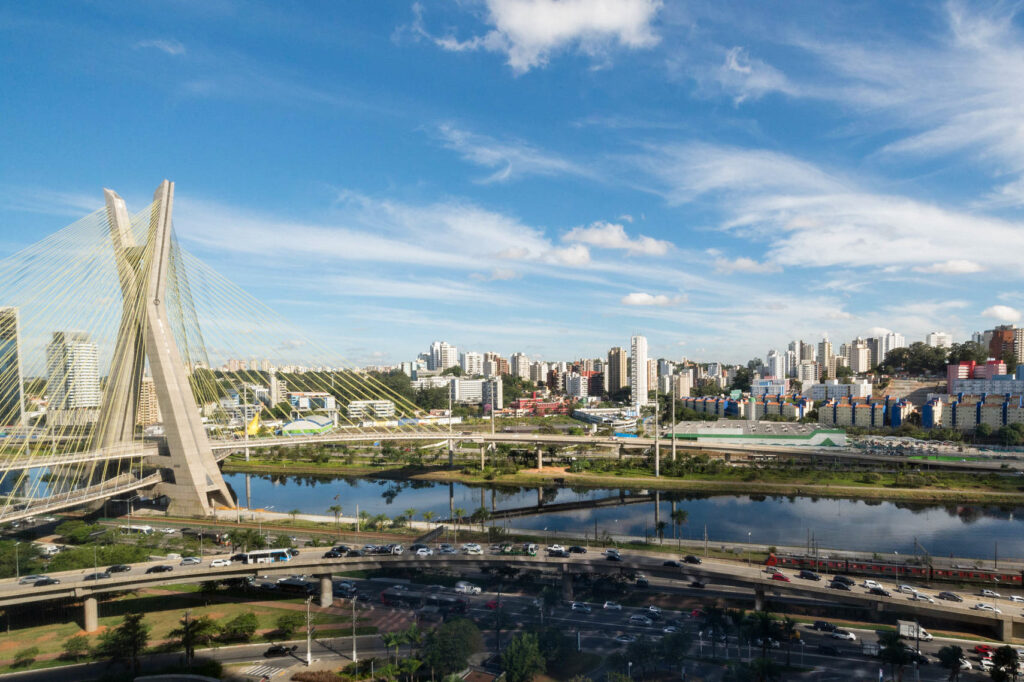
View from The Premium Twin Room at the Hilton Sao Paulo Morumbi/Oyster
If you’re staying in a high-rise hotel like the Renaissance or the Hilton Sao Paulo Morumbi , request a room on a high floor, if possible. This will get you amazing views, of course, but it’ll also ensure more of a buffer between you and Sao Paulo’s infamous street noise.
6. Not preparing yourself for Carnival in Sao Paulo.
Sao Paulo’s Carnival craziness might not quite reach Rio levels, but make no mistake — Sao Paulo during Carnival is insane. Sound trucks, mechanized floats, and parades of sparkly partiers fill the streets. It’s sensory overload, but keep your wits about you. Bring just the cash you need, skip jewelry, wear cheap sunglasses, drink lots (and lots) of water, apply sunscreen regularly, and establish meet-up points with your party in case of separation.
7. Packing schlubby or beachy clothes.
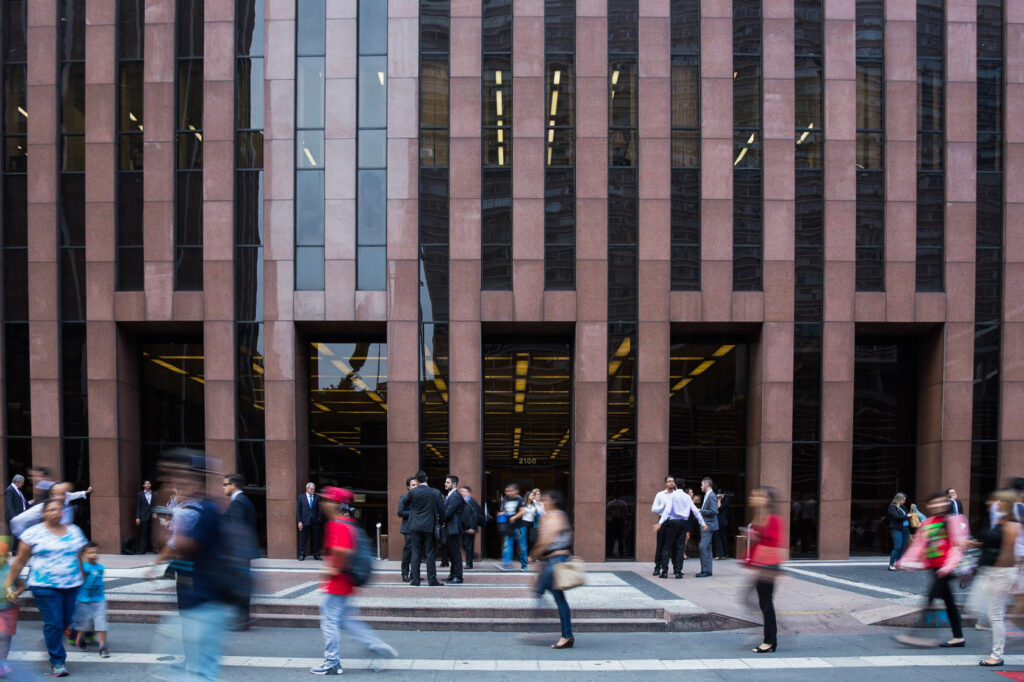
Sao Paulo /Oyster
The thought of going to Brazil might fill your head with visions of sarongs, shorts, caftans, and swimsuits. While it’s true that a suitcase full of beachwear will suit you well for Rio, Ilha Grande, and other Brazilian islands, you’ll need to step it up for Sao Paulo. As the economic capital of Brazil, Sao Paulo is worldly and wealthy with urbane residents dressed to the nines at all times. We’re not saying to wear only designer duds, but pack smart, sleek clothing and footwear. And if you’re not pairing Sao Paulo with trips to Rio or other coastal destinations (but you really should!), you won’t need beach garb, as SP is about 40 miles inland.
8. Wearing a boring outfit in Vila Madalena
You’ll want to dress well for your entire Sao Paulo trip, but save your favorite outfit for Vila Madalena , the bohemian quarter stuffed with avant-garde art galleries, quirky shops, and incredible street art. Selfies will most certainly be in order on Beco do Batman, a winding alley of bold and beautiful murals, so this is the time to break out bright solid colors or floral prints, fun accessories, and non-ugly shoes.
9. Parading signs of wealth
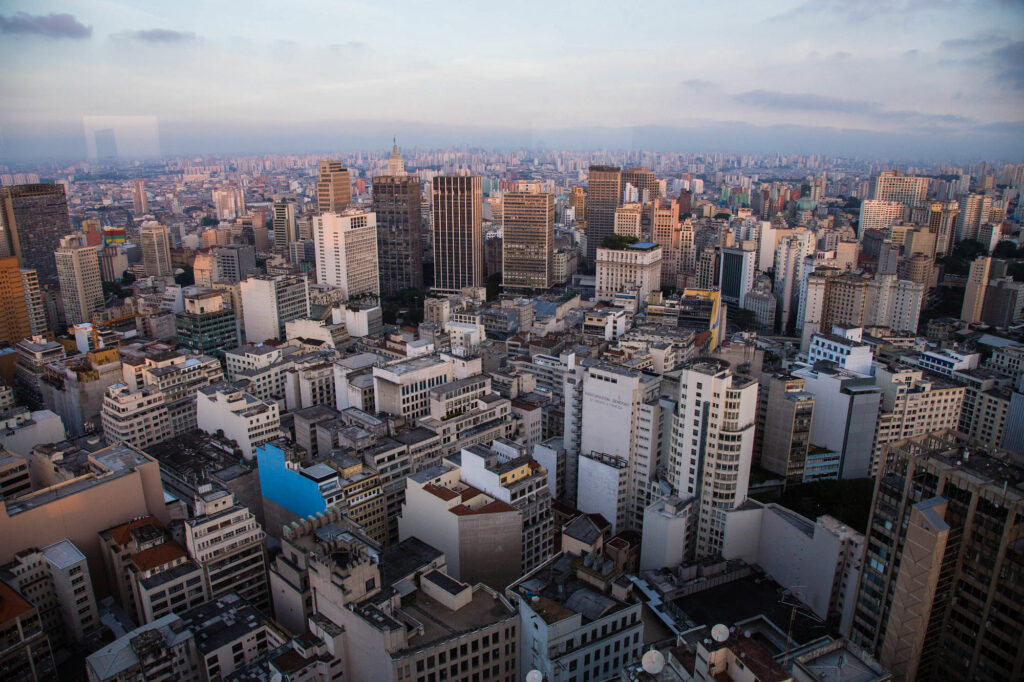
View in Sao Paulo/Oyster
Though looking sharp is important in Sao Paulo, avoid wearing showy jewelry or handbags or flashing cash or expensive tech. Keep your belongings close to your person at all times and be extra-cautious while in Centro (the downtown district) and when withdrawing reals from the ATM. And be sure to monitor the credit and debit card activity in your accounts, as card cloning or skimming is a possibility.
10. Underestimating the shopping scene in Sao Paulo
It is no exaggeration to say that shopping in Sao Paulo is second to none. For an intro, window shop your way down Rua Oscar Freire — Sao Paulo’s answer to Rodeo Drive. (Printed rubber sandals from the Havaianas flagship here make for great souvenirs.) To dial up the extravagance, head to Cidade Jardim or another one of SP’s opulent malls, and to dial it down, check out the indie boutiques around the hip Vila Madalena and Pinheiros neighborhoods. Just be aware that many stores are closed on Sundays in Sao Paulo.
11. Missing a market in Sao Paulo.
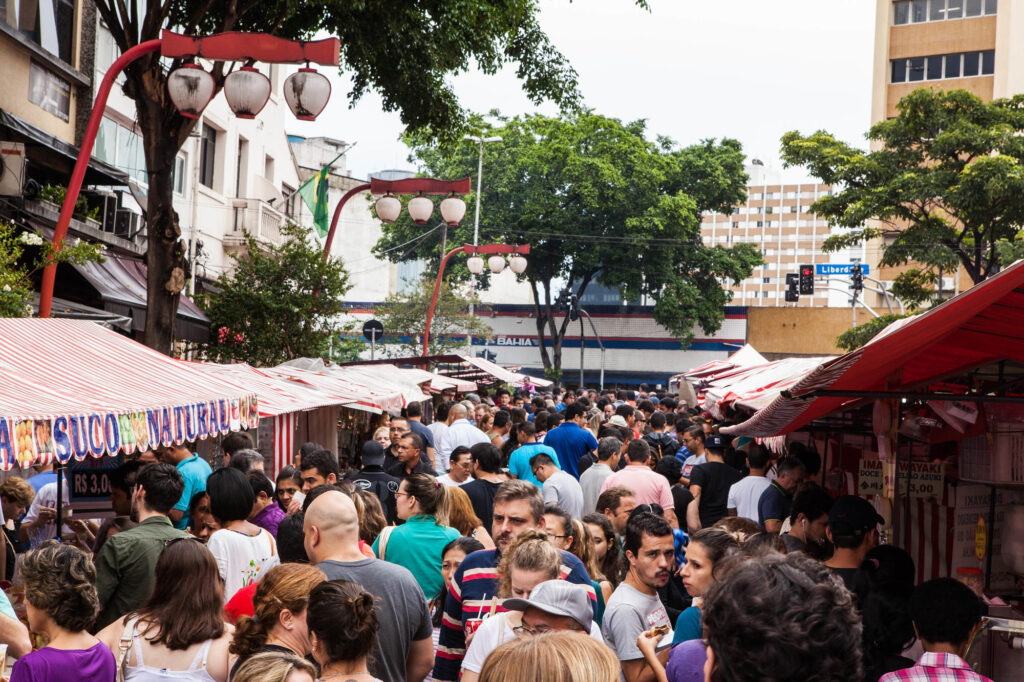
Liberdade Square/Oyster
Markets are big in Sao Paulo. If the timing works out, visit the Feira do Bixiga flea market on Sundays, the antiques fair below MASP (Museu de Arte de Sao Paulo) on Sundays, and the Japanese crafts/food fair in Liberdade on weekends. Even if your trip doesn’t coincide with a weekend, you can keep an eye out for vendors selling crafts and jewelry around the city and at hot spots like Mercado Municipal of São Paulo and Parque Ibirapuera.
12. Sticking to Brazilian food in Sao Paulo.
All-you-can-eat steakhouses and the national dish of feijoada (stewed black beans and pork) might be tasty enough for every meal, but then you’d be missing out on the far-ranging culinary delights on offer. Sao Paulo is truly a city of the world, with everything from Lebanese to French to Korean barbecue. Visit Bela Vista, Sao Paulo’s Little Italy, for charming Italian cantinas and pizzerias, and Liberdade for Chinese, Korean, and Japanese restaurants.
13. Hitting the clubs like an amateur in Sao Paulo.
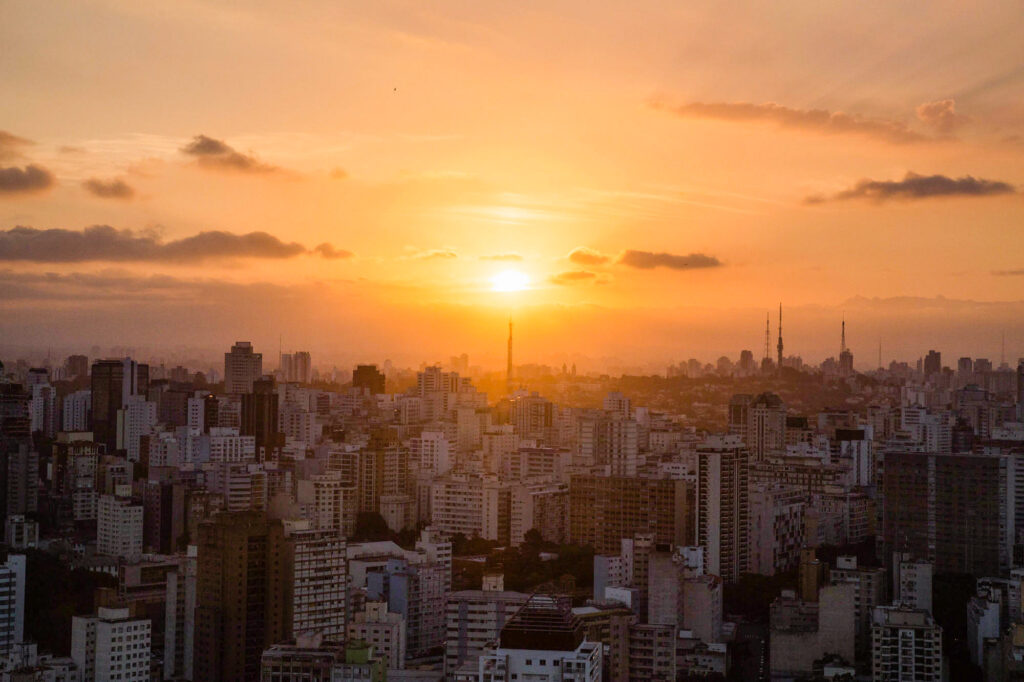
Sunset in Sao Paulo/Oyster
To experience Sao Paulo nightlife like a pro, you’ll need to follow some guidelines. First, figure out where you want to go. SP’s club scene is endless with spots specializing in everything from live rock to bossa nova to tango to house to samba to Brazilian pop. Though clubs don’t really fill up until midnight or later, it’s smart to go earlier to avoid long lines. Be prepared for the entry fee, which can soar at more upscale establishments. Settle your tab before the end of the night, when bars amass long lines of clubbers trying to pay up. And always take a car or Uber to get back to your hotel.
Our Sao Paulo Hotel Pick: Renaisssance Sao Paulo Hotel
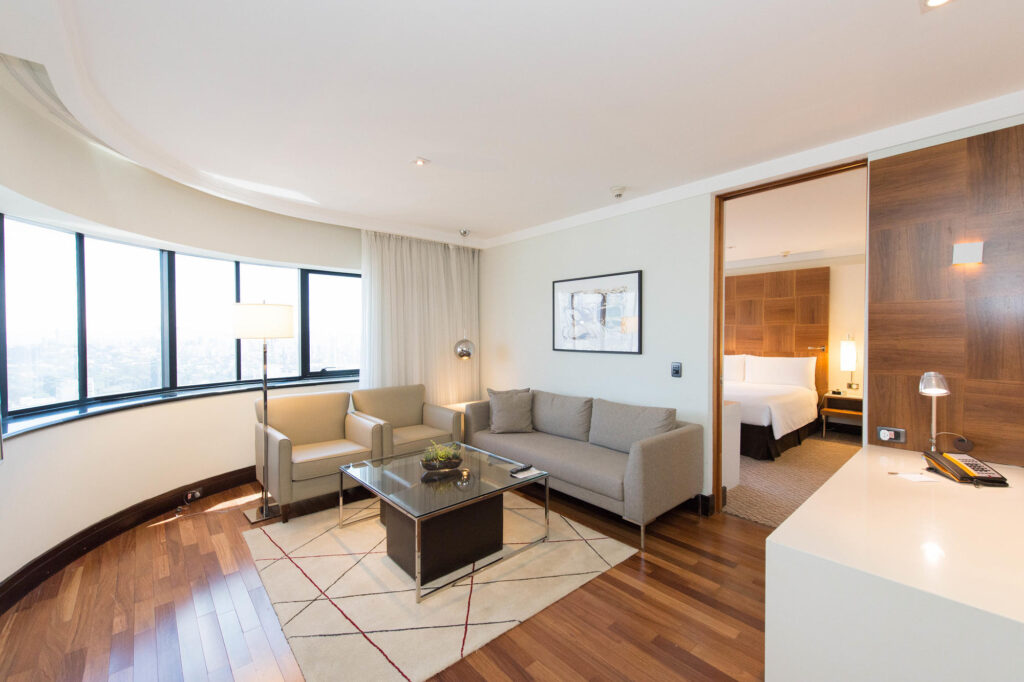
The Stanford Suite at the Renaissance Sao Paulo Hotel/Oyster
The upscale Renaissance Sao Paulo is a formidable presence in the leafy Jardins neighborhood, one block from Avenida Paulista (free walking tours are provided). Inside, the atmosphere is cosmopolitan and chic, like Sao Paulo itself. The hotel’s 444 rooms and suites are a highlight, each with spacious marble bathrooms, flat-screen LCD TVs, and city views. Hot? There’s a nice outdoor pool area with a few lounge chairs and a nightly reception with a free drink.
Pricing for Renaissance Sao Paulo Hotel
You’ll Also Like:
- The Best 10-Day Brazil Itinerary
- Is It Safe to Travel to Brazil?
- The Best Beach Hotels in Brazil
All products are independently selected by our writers and editors. If you buy something through our links, Oyster may earn an affiliate commission.
Top Stories

- Travel Tips
Top 11 Las Vegas Hotels on the Strip for Every Type of Traveler
By Christina Vercelletto

12 Best LGBTQ-Friendly All-Inclusive Resorts Around the World
By Lauren Dana

Which Bahamas Island Is Right for You?
By Kyle Valenta

The 16 Coolest Themed Hotel Rooms in the U.S.
By Gwen Pratesi

The 10 Best Caribbean Islands for Couples and the Most Romantic Hotel on Each
By Krystin Arneson

The Ultimate Sao Paulo Travel Guide: Top Tips and Must-Visit Spots [2024]
Table of Contents
Sao Paulo TRAVEL GUIDE
Sao paulo brazil: a quick look.
I must confess I never imagined myself writing a travel guide. Although this was less a São Paulo travel guide and more of a love letter to so many wonderful memories. If you want your own, then you’re coming to the right place. Here, you will find everything you need to know, from pre-planning your trip to staying safe .
You might be thinking, ‘Do I really need a São Paulo travel guide?’. And the answer to that will come at the end of this article when you realize how much more you’re prepared to take this trip. I hope to help you enjoy this place as much as I do upon each visit.
Be this visit number one, three, or fifteen, there are always new things to learn, so follow me on this São Paulo travel guide for today! Also, for an in-depth country guide, see our complete Brazil travel guide .
São Paulo Brazil: Quick Travel Tips Before You Go
🛫 Airport: The best airport in São Paulo, Brazil, is called Guarulhos International Airport. Its airport code is GRU.
🤑 Currency: Brazilian Real, shown by the R$ symbol.
🗣️ Language: Portuguese, although English is common in tourist spots and in hotels.
🕰️ Time Zone: Brasilia Standard Time (GMT-3). One hour ahead of EST and 4 hours ahead of PST.
💵 Cost: Quite affordable if you are coming from a stronger currency such as the US dollar, EURO, or Yen.
🛜 Internet: Incredibly fast and reliable mobile internet and the subway system has wifi in an emergency.
📄 Brazil Visa: As of now, If you are traveling from the United States, Canada, Australia, or Japan, then NO. This could change as of October 1, 2023. Track the status and details here . For EU Nationals, you do NOT need a visa, and you may not be affected by the Oct 1, 2023 change. You can see the details here .
🔌 Power Outlets: In Brazil, we have two associated plug types, C and N. Plug type C is the one with two round pins. Plug type N has two round pins and a larger grounding pin.
🔋 Power Grid: Wonderful! Brazil operates entirely on a 127/220V supply voltage and 60 Hz. Some newer hotels operate at 220V but don’t count on this.
📳 Brazil SIM Card : If you are considering the necessity of a SIM card for Brazil, trust me: the answer is a loud yes. They are not expensive, and to have one in any country you travel to is a must.
🚘 Car Rentals: Renting a car in Brazil can be a little overwhelming, and you can be nervous about driving abroad. However, it can be the best way to move depending on the trip you plan after reading this São Paulo travel guide.
São Paulo Brazil: Safety Travel Tips (Use Common Sense)
🍏 Food safety: Food is safe pretty much everywhere. Use your common sense, though, and avoid sketchy-looking things like seafood on the streets.
💧 Water safety: Tap water isn’t indicated for drinking, except for outside use, like washing hands and brushing teeth. Filtered water and ice are safe to consume. Restaurants usually have filters as well. Prefer to filter your water or buy bottled water. Consider using a Water-To-Go Filterable Bottle for convenient access to clean and safe drinking water during your travels.
👷♀️ Daytime safety: The most common thing in any tourist area is petty theft. Here are some tips. Ditch designer clothes, purses, and jewelry (including expensive watches. Don’t bury your head in your phone. Only have your phone out when absolutely necessary.
🦺 Nighttime safety: Use common sense like in any big city you visit. Don’t put valuables in your pocket, don’t walk alone at night, don’t pull your phone out on the street, don’t wear jewelry or watches or expensive purses, and don’t use the metro at night.
👺 Avoiding scams: Make sure your valuables are safe. Buy tickets for sightseeing tours and concerts online, not from street vendors. Taxis or Ubers should be booked directly from apps or through your hotel. Be mindful of where you withdraw your money; do it at banks only. Also, never leave your drink unattended.
São Paulo Brazil Travel Tips: A Local Perspective

🏨 Best neighborhoods for tourists: Avenida Paulista (best central location and for nightlife), Paraiso and Vila Mariana (families), Jardim Europa (couples), Via Madalena and Pinheiros (solo travelers and groups).
🎄 Top Brazilian holidays and traditions: This São Paulo travel guide recommends you try Carnival, Festa Junina (June Festival), Independence Day (Sete de Setembro), and Christmas around here.
🍜 Local food to try: Some traditional dishes you HAVE to try are Pavê, cachorro quente, brigadeiro, coxinha, feijoda, pão de queijo, and churrasco.
🍹 Local drinks to try (alcoholic): Cachaça, caipirinhas, and Catuaba.
🧉 Local drinks to try (non-alcoholic): In São Paulo, it’s all about the Guaraná and Coffee.
🚶♂️ Walkability: Wonderful! You are easily able to walk to most things in a short time or jump on the subway, too.
🎉 Nightlife: It is AMAZING. Not all São Paulo travel guides will tell you how wonderful it can get when the sun goes down.
😀 Friendly to foreigners: São Paulo is super welcoming. It’s already waiting for you.
🏥 Hospitals: Great, as São Paulo is the main metropolitan area in the country, many renowned establishments are here
🇺🇸 English speaking: Pretty much all over since it is a very touristic and business-led area.
São Paulo TRAVEL GUIDE
Where is são paulo, brazil located, são paulo map .
São Paulo, or Sampa, if you want to sound local, in the southeastern region of Brazil. The city, the capital of its homonymous state, is a beacon for everyone who dreams of making it. Meanwhile, the state boasts everything from coastal areas to beautiful highlands.
What State is São Paulo In?
São Paulo is a concrete jungle just shy of the coast in a state with the same name. São Paulo, both the state and its capital city, are well worth visiting. A brilliant mix of history and modern times, you are in for a treat by coming here.
What’s the Closest Airport to São Paulo, Brazil?
There are three airports that service São Paulo: Guarulhos International Airport (Code: GRU), Congonhas Airport (CGH), and Viracopos International Airport (VCP). Since you’ll be coming from abroad, you are better off selecting Guarulhos as your final destination.
What is the Best Way to Get to Your São Paulo Hotel?
Once you arrive at Guarulhos International Airport (GRU) in São Paulo’s metropolitan area, there are a few ways to get to where you’re staying.
The simplest and easiest way to do it is by organizing a private shuttle. That saves you the trouble of having to organize it upon landing. But if you don’t really mind, then there are a few things you can do.
You can try a taxi, but BE CERTAIN the meter is turned on to avoid scams. This is a thing to pay attention to in every country, and it is not different in Brazil.
Renting a car in São Paulo is an excellent option. Rental car agencies are at the airport, making for easy pickup and drop-off. It is the way to go if you plan to drive all around or if it is more of a family trip. But parking in São Paulo ain’t easy, and it’s not cheap either. If you want to save some room in your budget or plan to drink a little, then prefer Uber or shuttles.
Pro Tip: If you are planning to take an Uber, make sure that you have a Brazil SIM card so that your phone operates properly. You never want to depend on free public WIFI for using your ride-share apps.
How to Get Around São Paulo?
Ride Sharing (top choice): Ride-share apps like Uber are very used in São Paulo, mainly because they’re cheap and convenient. If you want the least amount of hassle, this is the way to go.
Rent a Car (top choice): A rental car offers the ultimate freedom in your São Paulo adventure. Through this, you will be able to explore nearby history and reach every corner of the town. If that’s in your plans, remember to bring your valid documents and prepare for right-side driving.
Take a Taxi: Taking a taxi is an excellent choice but should not be your main way to get around. São Paulo doesn’t have that many taxis around, and the prices can be a little steep. I generally go for them only when I absolutely have to
Public transportation: Not every São Paulo travel guide will tell you how amazing the subway is here. I wouldn’t say the same for surface trains and buses, but the subway is my favorite way to get around every time I’m there.
When to Go to São Paulo?

Every São Paulo travel guide will tell you something different about when to come here. But this is simply up to you and your goal for the trip, so let me tell you a little about each season here.
São Paulo Brazil Summer (December to March): If you are into sunny days, music festivals, and parties, this is the time to go. Sure, it will be peak tourist season with travelers from Brazil and abroad coming in. From comic conventions to great music and everything in between, it’s the best time to enjoy.
Summer Carnival: Carnival deserves its own spot! It’s the most famous party in Brazil for good reason. People celebrate the joy of being alive in every street for days on end! It usually happens in late February, but accommodations can get booked up far ahead, so plan in advance.
São Paulo Brazil Fall (April and May): If you’re like me and enjoy a more laid-back vibe, then this is the season for you. Autumn/Fall is a wonderful time to enjoy slower days and lower prices, too, since it’s not peak season.
São Paulo Brazil Winter (June to August): Winter here is when the rain falls, but don’t let that stop you. Colder weather is still wonderful to enjoy most attractions since they are inside. Other than the second half of July, there’s also the major advantage of few, if any, crowds.
São Paulo, Brazil Spring (September to November): Spring is my second favorite time to go. Given it’s not as hot as the summer and it usually has great cultural programs, it’s surely a wonderful time to enjoy these streets.
Keep in mind that there is no wrong time to visit São Paulo!
Where to Stay in São Paulo, Brazil (By Neighborhood)

São Paulo is a massive town, so choosing where to stay depends a lot on what kind of trip you’re planning and who you’re going with.
Your main options are Avenida Paulista (best central location and for nightlife), Paraiso and Vila Mariana (families), Jardim Europa (couples), Via Madalena and Pinheiros (solo travelers and groups).
I’ve dedicated this next section of our São Paulo travel guide to understanding what each area offers a little better.
Avenida Paulista (Best Central Location And Nightlife)
When it comes to easy access to transit while being within walking distance of several tourist spots, Avenida Paulista is where you want to be. Not only that, it’s also within a short distance of nightlife’s darling Rua Augusta, which I’ll talk about a little further down this São Paulo Travel guide.
Paraiso and Vila Mariana (Families)
Paraíso and Vila Mariana are both great places to stay as a family since they’re central enough but also a little further down from the chaos Avenida Paulista is on most days. Here, you can easily venture into the subway or get a car to every hotspot in town. In case you rent a car , here a lot of hotels have parking too.
Jardim Europa (Couples)
As a couple, your best bet is staying in the Jardins area, but I’d recommend Jardim Europa out of them the most. It’s a more upscale neighborhood while still being super affordable, full of renowned restaurants and eateries for you to try.
Via Madalena and Pinheiros (solo travelers and groups)
Now, if you’re going as a group or doing solo on a budget, either Via Madalena or Pinheiros are great bets. These neighborhoods are easily accessible through transit, which then leads anywhere you want to go. Accommodations here are also considerably cheaper and calmer.
Best Things to Do in São Paulo, Brazil
- Discover The Museums : There are museums for all tastes here! From typical art to others that expose Brazil’s history amidst a beautiful garden. In case there is a day or two extra in your schedule, try one up!
- Hit Avenida Paulista: Avenida Paulista is one of the main postcards here, and there’s so much to do. On Sundays, the avenue is closed for cars, and everyone can just enjoy the road!
- Visit Liberdade : Liberdade is a must in every São Paulo travel guide you consult. It’s an entire neighborhood filled with Asian traditions and products with that wonderful Brazilian touch.
- Enjoy Rua Augusta : To me, this is the heart of São Paulo’s nightlife. An entire street is home to several unique bars and restaurants for you to have a blast.
- Immerse Yourself in Green : Ibirapuera Park is a breath of fresh air in such a vast city. It compares to Central Park with lots of places to be explored.
- Try Brazilian Food : One of my favorite things about Sampa is how every culture has a spot, and because of that, so many traditional foods can be tasted.
- Walk Through The Municipal Market: this market reminds me of those fairs in fantasy movies because everything you could want is here. From artisanal foods to handcrafted goods, come and enjoy!
- Go Shopping: One thing Sampa has are shopping malls. From fancier upscale stores to traditional cuisines, there is some fun to be had here.
Best São Paulo Tours

Tours in São Paulo are one of my favorite ways to get some tourism done in a unique way. You can see sites, surrounding areas, and so much more! Unless your plans include renting a car , taking a tour can be an easy and cost-effective way to get your sightseeing done. You definitely don’t want to be relying on ride apps or cabs because that adds up quickly.
Tours are a streamlined way to really dive into a place without the hassle of planning. Below, I’ve dedicated a section of this São Paulo travel guide to the best kinds of tours in the São Paulo area. They go from walking tours to personal photographers to pub crawls; let’s take a look!
💡Pro Tip: If I plan to spend more than four days in a new place, I like to first take a broad tour of neighborhoods to get a feel of everything and then decide where I would like to spend more of my time. It is so sad to find a great spot with half a day left in town.
💡Pro Tip: When it comes to booking tours, never get them from people on the street. You are better off doing it online or with your hotel concierge. But hotels act as middlemen and might hike up prices just to take a cut.
Here are the top tours for São Paulo: :
- Complete São Paulo City Tour : This kind of tour will take you through an in-depth journey. Along with a professional guide and sometimes even transit costs covered, it is recommended to tick some spots off of your list.
- São Paulo Walking Tour : If you’re a more active person and want to see Sampa from the ground up, taking a guided walking tour is the way to go! You can book them even through Airbnb, and some locals offer them for free.
- Bar Crawling Tour : São Paulo is famous for its vibrant nightlife. Book this tour if you want to have an unforgettable time and lifetime memories.
- Eco Tours : Every São Paulo travel guide will tell you how Ibirapuera Park is a must. Not all of them will tell you to book a tour to check all the best spots in it for a rather reasonable price.
- Photo Tours: Another awesome thing you can do is to hire a tour with a private photographer to register your moments while out in town.
- Metropolitan Area Tours: If you want to explore a little further, schedule a tour for another nearby town. The São Paulo area is full of quaint little towns to explore.
- Private Custom Tours : If you want to personalize your experience a little further, go for a private custom tour. This way, you’re able to make your own plans and follow your own beat, with the advantage of not having to worry about a group.
Is São Paulo Safe for Tourists?
In general, every São Paulo travel guide will agree that it is a safe city for tourists. This is not to say there is absolutely no crime; it happens just like in any big city or destination. You should take some precautions as usual.
The main concern is what we call petty crimes, such as theft, pretty much year-round. Be it in Rio, São Paulo, Milan, or Paris, the risk of being caught unprepared is the same. The more planning you do, the less of a target you are.
💡Here Are My Pro Safety Tips For Every City You Travel To:
- Valuables should go in two spots in your person when out and about. Small valuables, credit cards, and even your phone are safer in those thin fanny packs to hide under clothing. Other things you ‘don’t mind’ losing should be in other spots. Like this, if pickpocketing or confrontation does happen, you’re at less risk of losing things.
- When in popular spots, especially with crowds, avoid getting your valuables out as much as possible. Thieves pay attention to that kind of behavior!
- Be mindful of chaos. Often, it is just a distraction so that petty thefts can happen.
- As your São Paulo travel guide, I try to be as thorough with research as possible, but things can change super fast. So always check with your accommodation if there are any areas to avoid currently.
- Forget bling at home. Avoid visible brands, fancy jewelry, or watches. All of that makes you stand out as a target.
Normal precautions are important all the time. São Paulo does have a lower crime rate when compared to other cities. Most neighborhoods are well-patrolled, and people love to welcome visitors.
Its neighborhoods are well-patrolled, and residents are welcoming toward tourists.
That being said, what matters most is to be aware of your environment, even more during the night or in crowded spots. Remember that you are responsible for your safety, so plan ahead and have a great time.
What is the Best Travel Insurance for Brazil?
This is a question that I get a lot, as travel insurance can get confusing. This is a critical part of your trip though so that you do not have to worry when visiting São Paulo or any other part of the world.
Figuring out travel insurance can be overwhelming. However, having the right travel insurance coverage is essential for a stress-free trip to São Paulo, Brazil. The key is to make sure it is simple and flexible.
To streamline this, we have broken down the best travel insurance companies out there in the industry that are all great but also serve different needs.
Let’s explore what each of them brings to the table:
✅ World Nomads : Best for comprehensive coverage, flexibility, AND adventure sports. Covers trip cancellation, emergency medical costs, and emergency medical transportation and protects your travel gear.
✅ SafetyWing : This is for general travelers, frequent travelers, and long-term digital nomads in Brazil. Provides lots of flexibility as far as start date, coverage extension, and automatic renewals. It also has limited home-country coverage.
✅ Travel Insurance Master : Brazil travel insurance search tool, this is for people who really want to compare policies.
São Paulo Travel Guide: Frequently Asked Questions

Can You Drink the Water in São Paulo, Brazil?
Straight from the tap is a massive NO.
It doesn’t matter which São Paulo travel guide you consult. Everyone will tell you unfiltered water is a no for drinking. It is typically safe for general use, but don’t even risk drinking it.
You’re good for brushing teeth, showers, and whatnot! But when it comes to drinking, I’d recommend a reusable bottle to refill or just buying bottled water when needed.
That being said, a lot of São Paulo restaurants offer ‘água da casa,’ which is just filtered water to customers and used for ice, so you’re good. Be sure to ask the restaurant, and if they don’t have it, you can go back to bottled water for the time.
Also, always look at the weather because the Brazilian sun can get very strong, so you want to stay hydrated. Getting sick should be the last on your trip bucket list.
So Steps to Stay Safe With the Water Are:
- In an AirBnb, boil the water if you do not have bottled water or a filter.
- In a hotel with no filter, buy bottled water, but this can get expensive.
- Get a reusable water bottle that you can refill. And since refilling is free, you don’t have to worry about something so simple to solve while in São Paulo, Brazil. Consider bringing along a Water-To-Go Filterable Bottle for convenient access to clean and safe drinking water during your travels.
What’s the São Paulo Weather Like?

São Paulo, Brazil, has a mostly subtropical climate, and it’s heavily influenced by monsoon seasons.
You can expect hot summers with temperatures from 25 to 30 degrees Celsius (77-86 degrees Fahrenheit). Sometimes, there are intense heat waves, so always have light clothing at hand. As for winter, it cools down to between 13 and 22 degrees Celsius (55-72 degrees Fahrenheit).
Most of the rainfall happens during warmer months, so you can expect to have dry weather from June until September/October. With the beginning of the fall season in May and going until the end of spring in November, you should have nice weather for your trip.
I’d say which season you go in isn’t so important because what matters is your goal. On a daily basis, São Paulo’s weather can be unpredictable, so it’s good to have a light jacket or umbrella with you at all times.
Is São Paulo Expensive?
If it’s already an inexpensive destination for locals, for tourists from the US, Europe, or any other stronger currency, it gets even cheaper because of exchange rates. Expenses like accommodations, food, transport, and others end up a lot cheaper than usual.
Eating out happens at a much lower cost, especially at local spots, just because your currency is ‘worth’ more.
Do keep in mind that your costs can add up a lot higher if you want finer things while here. Higher-end hotels, restaurants, and such will be more expensive but still a little cheaper in comparison to your own prices.
I’d like to mention prices will generally go up during peak seasons, especially in the most popular areas. So, if you want to save your budget for something else, plan your trip to other moments, and you’ll be fine.
Is São Paulo Worth Visiting?
A hundred percent yes! São Paulo is not a famous destination in Brazil for no reason. It is a city that contains multitudes and will always have something new to show you.
It has something for all travelers, from nature to musical theatre.
Locals lovingly call it Sampa, and it is so much more than a concrete jungle. You can enjoy nature in the parks, party in unique clubs, enjoy open-air art installations, or catch a play in theaters. There are also so many tours you can take in order to have the trip of your dreams.
I was there three times in 2022, and each time surprised me with new restaurants and foods to try. From traditional Asian cuisine to whatever else you can think of, São Paulo has it all.
Locals are always ready to share their town with you and help you be safe in this enormous place. But if you are not a fan of crowds or prefer a calmer vibe, plan for the shoulder seasons and enjoy!
How Many Days Do I Need in São Paulo, Brazil?
The answer to this question isn’t as simple as one, two, or three.
Most São Paulo travel guides will tell you anything from three to seven days, but I think it depends a lot on what your plans are.
If you plan a more culture-led visit, then you will need at least four full days in town. After all, there are several great museums, and you will want to take your time. But if you’re more into checking out the sights, then you may need a little over a full week.
I think that the amount of days you will need depends on your goal. Plan your time, then add a couple more days just to be safe.
General São Paulo Brazil Travel Info & FAQ
🌞 São Paulo Weather São Paulo was lovingly nicknamed ‘Terra da Garoa,’ which translates to ‘land of the drizzle.’ Given it is a big city so close to a major river, the weather can be quite humid.
Depending on the time of year you come, you can experience drier weather, though. During the summer, there are hotter days with little to no rain experience. While winter can be a marathon of drizzles from time to time.
It really is a year-round destination, so it’s only a matter of paying attention to which season you’re going in, but temperatures are mild in general.
💰 Brazil Currency The official currency in Brazil is the Brazilian Real, shown by either BRL or R$. Nowadays, cards are accepted almost everywhere, but it’s wise to have some cash on hand, especially in São Paulo, where street fairs just show up, and you may want to get some food or a souvenir. I’d hate for you to miss out on something amazing because of not having cash.
🗣️ Brazil Language Since Brazil’s official language is Portuguese, both in São Paulo and all through the country, this is what you’re most likely to hear in the streets.
Yes, English is around in several tourist spots and hotels, but this São Paulo travel guide recommends learning a few things in the native language. Just a few sentences in Portuguese can go a long way toward integrating you with this amazing place.
If you want to learn a bit of Portuguese prior to going, DuoLingo and Pimsleur are great tools to use.
🛫 São Paulo Brazil Busy Season & Slow Season São Paulo Busy Season: Arguably, São Paulo’s busiest season is the Summer, from December to March, and also the Brazilian Winter break, usually the last weeks in July. As these are considered to be super busy times by every São Paulo travel guide, expect to find crowds and hiked-up prices.
São Paulo Slow Season: If you want to avoid bigger crowds, plan for August to November. Given most of the slow season during the southern hemisphere winter, also plan for colder weather and better deals.
São Paulo Shoulder Season: São Paulo only has three months I’d consider a shoulder season. From April to June, you can enjoy rather mild weather that doesn’t have the extremes of summer and winter go through. São Paulo’s main attractions will be ready to welcome you with fewer crowds in your way!
Do I Need a Visa for Brazil?
The Short Answer: If you are traveling from the US, Canada, Australia, and Japan, the answer is no, UNTIL October 1, 2023, then the answer is yes. Currently, no visa is necessary from European Union (EU) countries. This looks like it will be the case even after October 1, 2023.
The Longer Answer: Traveling to Brazil is a great experience, but it is important to make sure you have all your ducks in a row so to speak. That means having the proper documentation needed to enter the country.
Here’s what you need to know about securing a visa for Brazil, specifically for citizens of the US, Canada, Australia, Japan, and European Union (EU) countries.
Section 1: US, Canada, Australia, and Japan Citizens of the US, Canada, Australia, and Japan can currently enter visa-free travel to Brazil for tourism or business purposes.
This applies to stays of up to 90 days within a 12-month period. All you need is a valid passport with an expiry date at least six months beyond your intended departure from Brazil.
Brazil is looking to implement the visa requirement again for these four countries as of October 1, 2023, so plan in advance for this.
Section 2: European Union (EU) Nationals
For most European Union citizens, including those from the UK, Germany, France, and Italy, also benefit from visa-free entry to Brazil.
This policy permits EU nationals to stay in Brazil for tourism or business purposes for up to 90 days within a 12-month period. Like others, they will need a passport that is valid for at least six months past the date of entry into Brazil.
Visa and immigration requirements can and do change. It is always advised to check the latest information from the official government websites of Brazil or your home country’s foreign travel advisory services before making travel plans.
For the most recent and comprehensive information about visa requirements for all nationalities, consult the Brazilian Ministry of Foreign Affairs website or a Brazilian embassy or consulate near you during your pre-planning phase of your trip.
The October 1st, 2023 update does not look like it will affect EU Nationals, but research accordingly here .
What Do I Need on My Brazil Packing List?
Perhaps the worst thing ever is accidentally overpacking and having to haul those unnecessary things halfway across the globe with you. It is also equally terrible to desperately need something and not have it. That can put a damper on anyone’s mood.
Packing for a trip to Brazil, or any international trip, in fact, should be done in advance! I’d say to start by getting one of those digital luggage scales to avoid being overweight.
Here’s a curated list focusing on your primary needs: 🔌 Power Adapters: Brazil has types C and N outlets, which can be a hassle if you don’t plan ahead. You can buy the correct adapters for your devices ahead of time to avoid scrambling around and wasting time to buy one there. Consider bringing a universal travel adapter to ensure compatibility with various outlets during your travels.
📳 Brazil and São Paulo SIM Card: You know that being connected is essential, even more so when traveling abroad. Don’t forget to get a Brazilian or São Paulo-specific SIM card to communicate and access the internet. This is a must-have if you plan to rely on Google Maps, Uber, or similar things.
💧 Filterable Water Bottle: Tap water in São Paulo is generally safe for use but definitely not for drinking. Be like me, and carry a reusable water bottle everywhere you go! Consider bringing a Water-To-Go Filterable Bottle for convenient access to clean and safe drinking water during your travels.
💊 Anti-Hangover Meds: São Paulo’s nightlife is a sight to see! But you don’t want to waste an entire day out of your time with a hangover. So, include some anti-hangover meds in your first aid kit.
👒 Sun Protection: The Brazilian sun is no joke, so don’t underestimate it! I recommend you pack a high-SPF sunscreen and a hat to protect yourself or budget to get them here. Just a short time in the sun can make your next few days unpleasant; trust a person who’s had sunburns literally in the head.
🦟 Bug Repellent: By now, you know Brazil’s weather is tropical, and depending on where you go, you’ll have many mosquitoes as your company. No matter where you are, this item is necessary. Consider using an eco-friendly bug repellent to protect yourself from mosquitoes while minimizing environmental impact.
🩴 Comfortable Footwear: Don’t forget you will cross many terrains here. Pack comfy shoes for walking, sandals, flip-flops, and whatever else you think is going to be necessary.
📄 Travel Documents: If you remember one thing this São Paulo travel guide tells you, remember to take all of your important documents with you. Passport, visa (if required), travel insurance papers, and anything else. I’d go ahead and also make copies of everything just in case loss or theft happens. Without them, you’d be in a nightmare.
As for the rest of your packing, just keep in mind to pack appropriate clothing for the season you’re traveling to São Paulo. You can change this list to fit your heart’s desires so long as you plan to have a great time!
Is it Safe to Rent a Car and Drive in São Paulo, Brazil?
Of course! It is super safe to rent and drive a car in São Paulo. But also keep in mind this town has a more stressful driving atmosphere and also a lot of traffic. Comfortable experience for visitors.
Brazilian traffic laws are easy to navigate, but São Paulo’s metropolitan area is home to many people, so be attentive. Trust your rental car GPS, which can be in KM, so check the configurations and the key signs, and you’ll be fine.
Remember, in Brazil, we drive on the right-hand side. If you go for renting a car , make sure to have a good insurance policy too for peace of mind reasons. Most rental places have them available, too.
When you park, especially on the street, ensure the car is locked and leave no personal items in sight.
All in all, driving around São Paulo is a safe and cool experience. It offers freedom, flexibility, and bragging rights to an awesome experience. Although it’d not be my first choice, driving in São Paulo is definitely part of my bucket list.
Do I Need to Speak Portuguese to Visit Brazil?
If you go to some places that are a little more of the road, maybe a little. But when it comes to areas like São Paulo, then not at all! Even the subway here has announcements in English, and most people in the hospitality and commerce industries speak it to some degree.
However, learning a little Portuguese can make your travel experience even better by giving you the ability to interact with the culture around you properly. In situations where English isn’t available, tools like Duoling can help you! Not only Duo but some other platforms also have great, user-friendly apps to help you learn the basics for your trip.
But worry not! Even without fluent Portuguese, you will be able to navigate Brazil perfectly. I’m a person who loves to learn some basics before going to another country. So, if you want to be like your São Paulo travel guide, take a shot at some Portuguese before you come over. Here are some great language preparation options for your trip to Brazil:
Learn Basic Portuguese: Using some platforms to learn language basics is great, but I prefer ones like DuoLingo or Pimsleur. They have interactive courses to help you gain confidence and speak a little Portuguese before your trip.
Use Google Translate App: This one can be a lifesaver when it comes to navigating language barriers. Remember, it works online, so you will also need a Brazilian SIM card with plenty of data available.
Get a Portuguese Phrasebook : It may sound silly, but consider packing a Portuguese phrasebook , for example, the Lonely Planet Portuguese Phrasebook . It can be handy to have a non-digital assistant to help with communicating and understanding the local language in a pinch.
You won’t become fluent, but even basic knowledge can go a long way. It will definitely enrich your trip to São Paulo. Locals love it when visitors make an effort, even if it feels small.
Is Brazil Safe for Solo Female Travel?
Well, Brazil, in general, can be a very safe destination! When it comes specifically to São Paulo, I recommend taking some extra precautions because of it being such a big city.
There are some implicit safety measures I’d say are a must, such as staying in well-reviewed accommodations in areas close to movement, only booking your tickets online since there’s no control if you’re actually going alone, avoiding being out on the street by yourself at night and be watchful of your surroundings.
Also, don’t go out with anything too flashy or visibly branded; leave that in your hotel.
No São Paulo travel guide will point out specific behaviors or dress codes, but we all put a light on using only trustworthy transport. The subway is generally super safe, and during the day, it’s always my go-to. But if I end up out later than 8 p.m., then I get an Uber! This is the app that works best here; don’t forget to have mobile internet to use it!
Keep yourself connected to people, tell them about your plans and when you plan on going back to your accommodation for the night. I usually go as far as sharing my location until I’m safely inside.
As a person who travels alone often and to São Paulo twice as much, trust me as the São Paulo travel guide you’ve chosen: this is the experience of a lifetime! Whether you’re going for a weekend or doing an in-depth exploration, São Paulo is waiting for you!

Hey, everyone! My name is Lu and I’m 24 years old. Although I was born in the state of Rio, life took me around from birth. I grew up in the South of Brazil and now live in the South East, in a town called Juiz de Fora. I’ve lived in the US for a couple of years before coming back determined to meet more of my home country. Besides traveling, I love to work as a teacher and go to as many concerts as possible in the company of my besties and girlfriend!
Catch me at my socials below!
insta: https://www.instagram.com/lumachowski/
- United Arab Emirates
- Switzerland
- The Netherlands
- Puerto Rico
- United States
- New Zealand
- ➨ Choose from World Map
- Budget Travel
- Family Travel
- Getting Around
- Visas & Passports
- Work with Us
Browsing Category
- Czech Republic
- Saint Martin
- Uncategorized

- Latin America & The Caribbean
Sao Paulo Travel Guide: Everything to Know [2023]
· your guide to a sao paulo trip in 2021, including how to get around, what to do, and more ·.
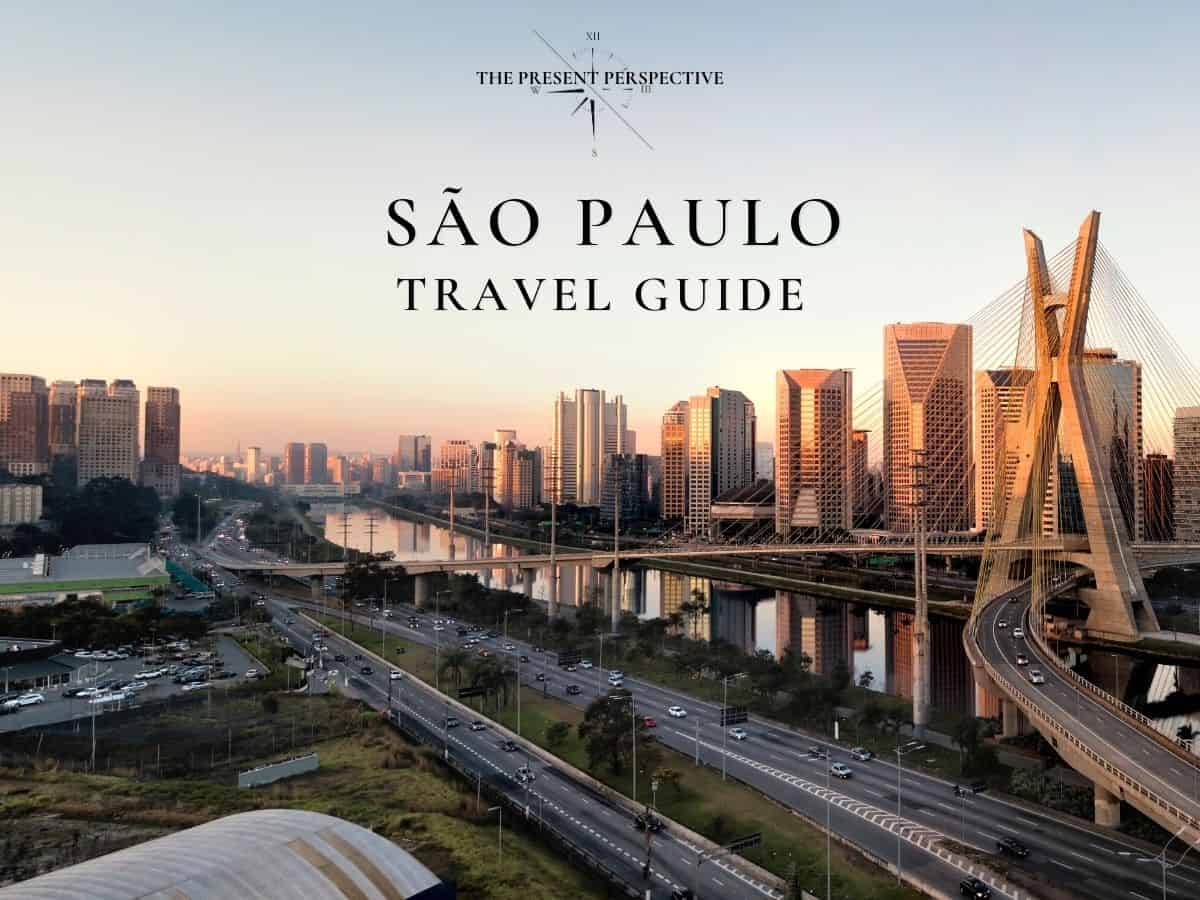
As the largest city in South America and the entire Southern Hemisphere, you’ve probably heard of Sao Paulo. About twice the size of New York City, Sao Paulo’s metropolitan area sprawls further than the eye can see. We didn’t know much about this city before arriving, but it shattered every expectation that we had.
The culinary scene is bustling and extremely international, the city’s infrastructure is incredible, and the people are some of the friendliest that we’ve ever encountered. Did I mention that Sao Paulo has the biggest Japanese community in the world outside of Japan?
If you like Japanese food, love quality art museums, enjoy watching soccer or are interested in visiting one of the largest cities in the world, Sao Paulo is a great place you don’t want to miss!
If you like Japanese food, love quality art museums, enjoy watching soccer, or are interested in visiting one of the largest cities in the world, Sao Paulo is a great place you don’t want to miss!
Our São Paulo Vlog is our most popular YouTube video by far; you’ll be blown away by some of these foods!
The Best Things to Do in Sao Paulo
As the most populous city in Brazil, you’d be right to expect Sao Paulo to have a little bit of everything. The city is massive, historic, high-class, and very international. As a result, Sao Paulo is home to some of the best restaurants, art galleries, streets, and experiences in all of Brazil.
Some people try to say that Sao Paulo is just a giant concrete jungle, but in truth, it is a vibrant metropolis filled with cultural centers, world-class restaurants, stunning public parks, and more. Here are the best things to do in Sao Paulo.
1. Eat Incredible Asian Food in Liberdade
Liberdade is the Asian neighborhood of Sao Paulo. You could kind of think of it as Chinatown, except more Japanese than Chinese and also blended with other Asian cultures, like Korean and Taiwanese. The neighborhood is always worth visiting if you’re a fan of Asian cuisine, but it’s especially great on the weekends.
Many of the local residents and restaurants open up stands on a blocked-off street and sell all kinds of Asian food, including Chinese, Japanese, and sometimes Korean. They serve dumplings, stir-fry, desserts, tempura, bubble tea, and more!
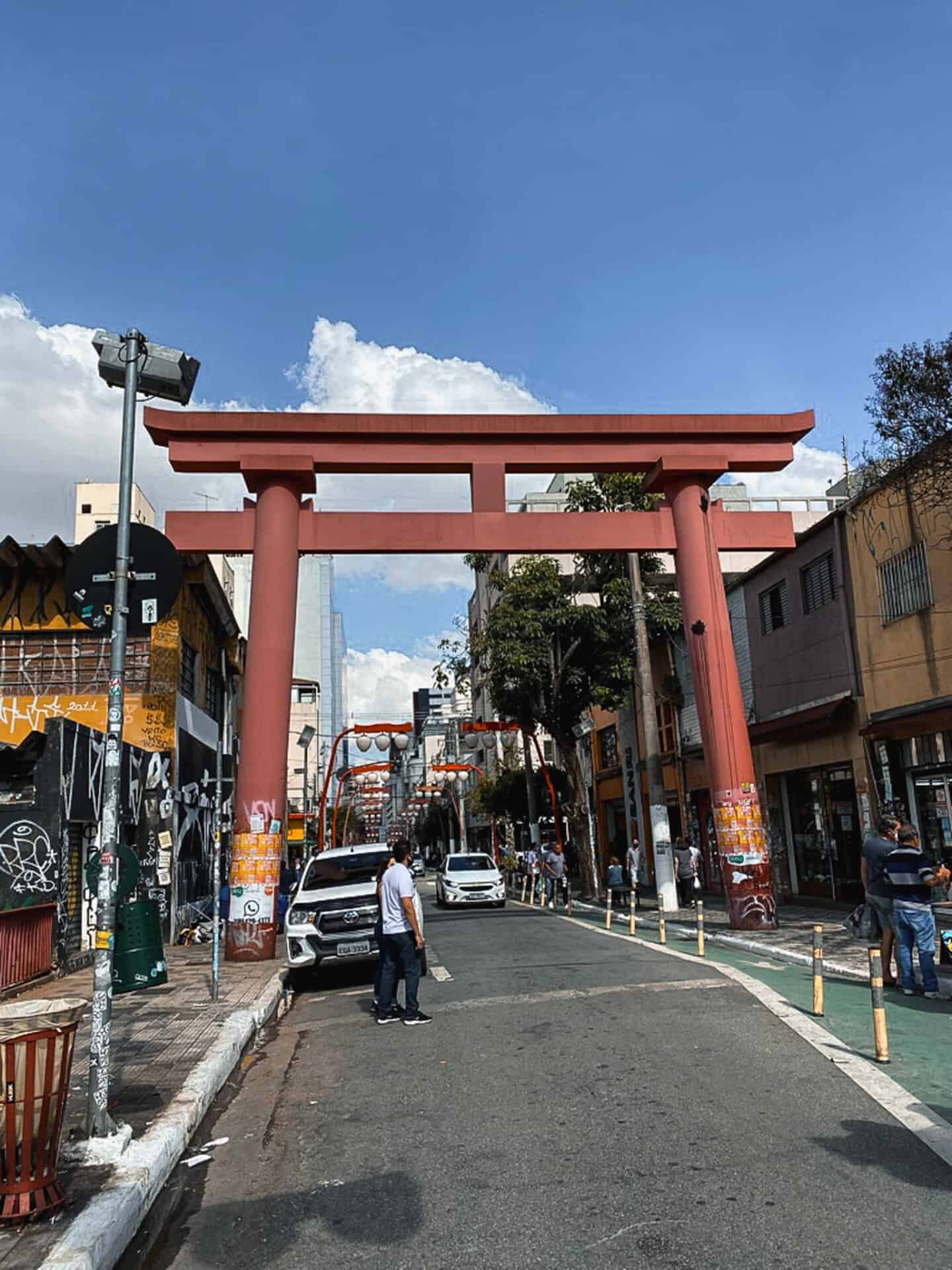
Visiting Liberdade was easily one of the best experiences we had in all of Sao Paulo and we highly recommend making it a priority if you enjoy any kind of Asian food. While you’re there, check out Bubble Kill for some great bubble tea!
Visiting Liberdade was easily one of the best experiences we had in all of São Paulo.
2. Go for a Picnic in Ibirapuera Park
Ibirapuera Park, or Parque Ibirapuera in Portuguese, is massive – like Sao Paulo’s version of Central Park in New York City. There are lakes, trails, museums, picnic tables, running tracks, restaurants, and more! The park is free to enter and is open from 5am to midnight every day of the week.
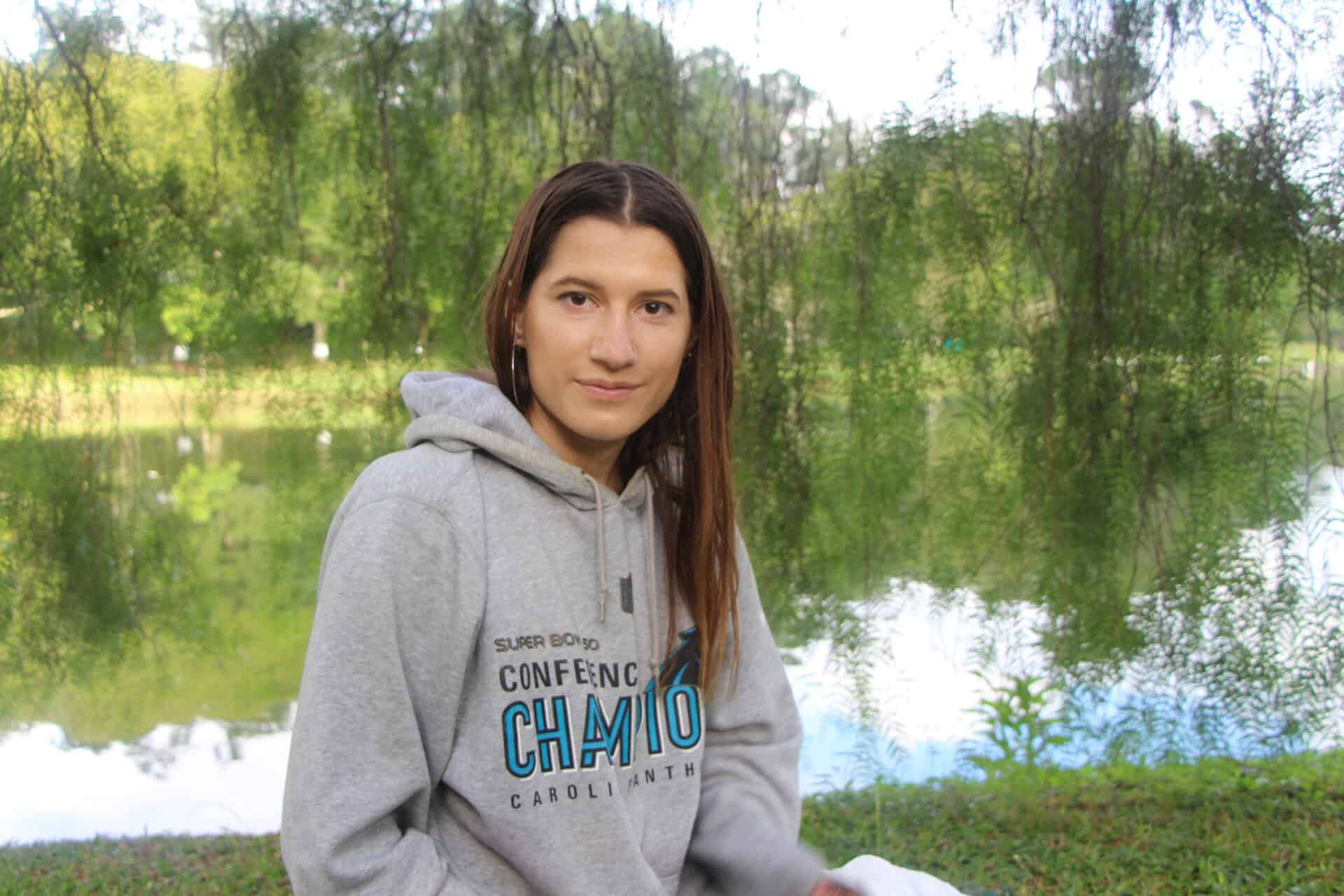
Some of the best museums in Sao Paulo are in or around the park. The food options range from snack foods and acai to full meals! There are also one- and two-seated bikes that you can rent to go for a bike ride around the park. We chose to take a bottle of wine and some sandwiches and have a picnic by the gorgeous lake while watching the swans swim around.
The park is located in a very safe area, and we could’ve spent days here between the museums, food, and natural relaxation that the park offers. Using professional photography equipment is technically illegal here, but they don’t really enforce this rule. If an officer comes up to you and tells you that you need to put your camera away, you can head over to the park authority’s office to get written consent to use your camera.
3. Admire the Graffiti at Beco do Batman
Beco do Batman, or Batman’s Alley in English, is a really cool corner of Sao Paulo worth checking out. It is essentially a street art park with several streets of elaborate graffiti that are filled with cool restaurants and cafes. The artwork is very impressive, and we went back a second time just to take it all in.
The sheer amount and quality of graffiti is incredibly unique, and we have never been anywhere like it in the world!

View this post on Instagram A post shared by Angel, Greg, & Nicola | Travel Family (@the.present.perspective)
If you come in the morning, you’ll experience a relaxed, hipster kind of vibe, while the peak hours in the evening and night tend to get a little bit rowdier! If you’re in the Beco do Batman area and looking for a bite to eat, check out AVO . They have really great farm-to-table options and serve fantastic food.
While hipster vibes may not be for everyone, this area in São Paulo is a place that we absolutely recommend visiting. The sheer amount and quality of graffiti is incredibly unique, and we have never been anywhere like it in the world!
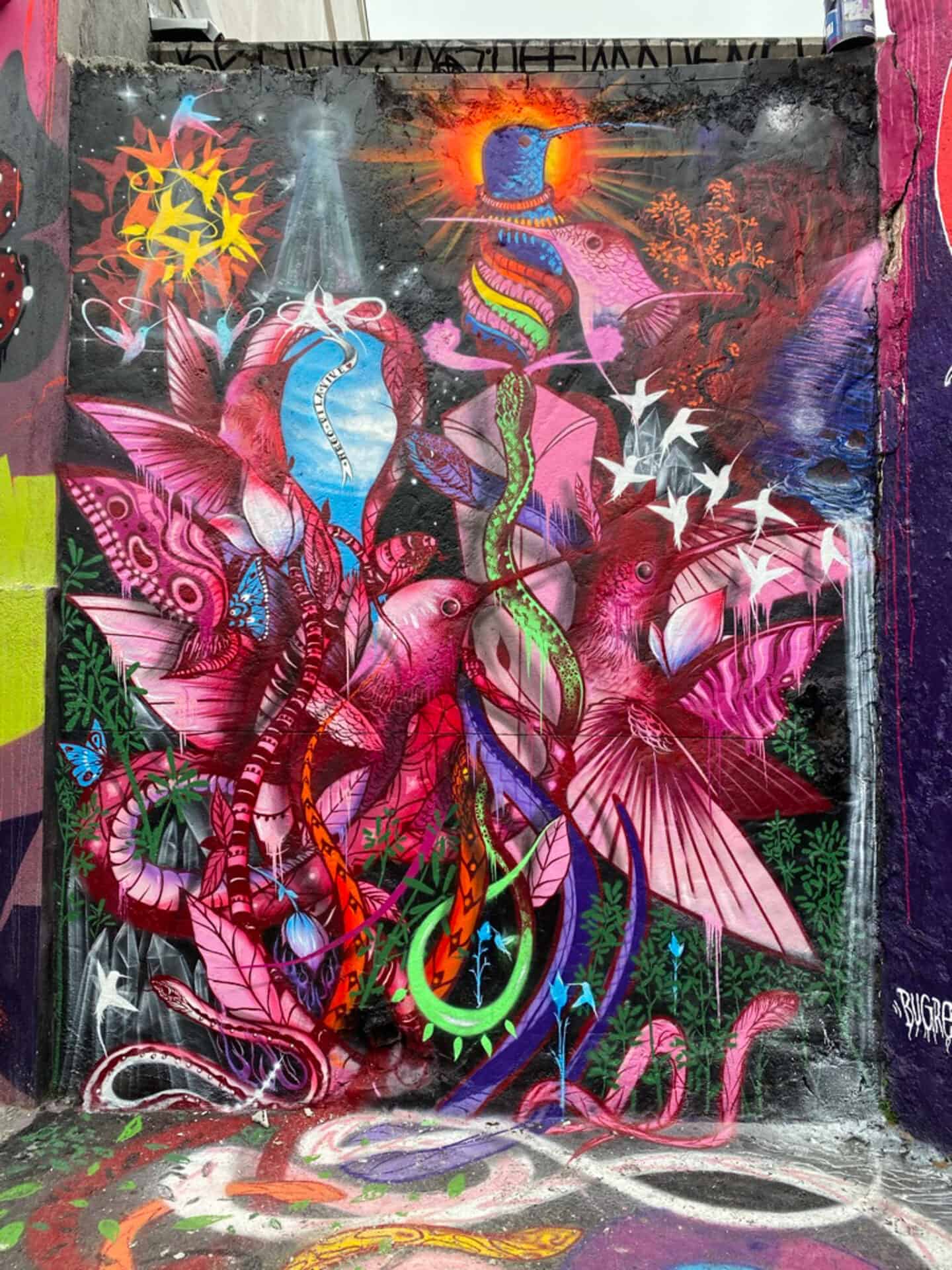
4. Get Lost in World-Class Museums and Art Galleries
If you’re a museum goer, Sao Paulo should absolutely be on your bucket list. If you enjoy art museums, you need to check out the Art Museum of Sao Paulo (MASP) , the Pinacoteca , and the Museum of Modern Art (MAM) . All of them house some fantastic works of art, but MASP is the most globally famous.
The Best Art Museums
Art Museum of São Paulo (MASP)
Museum of Modern Art (MAM)
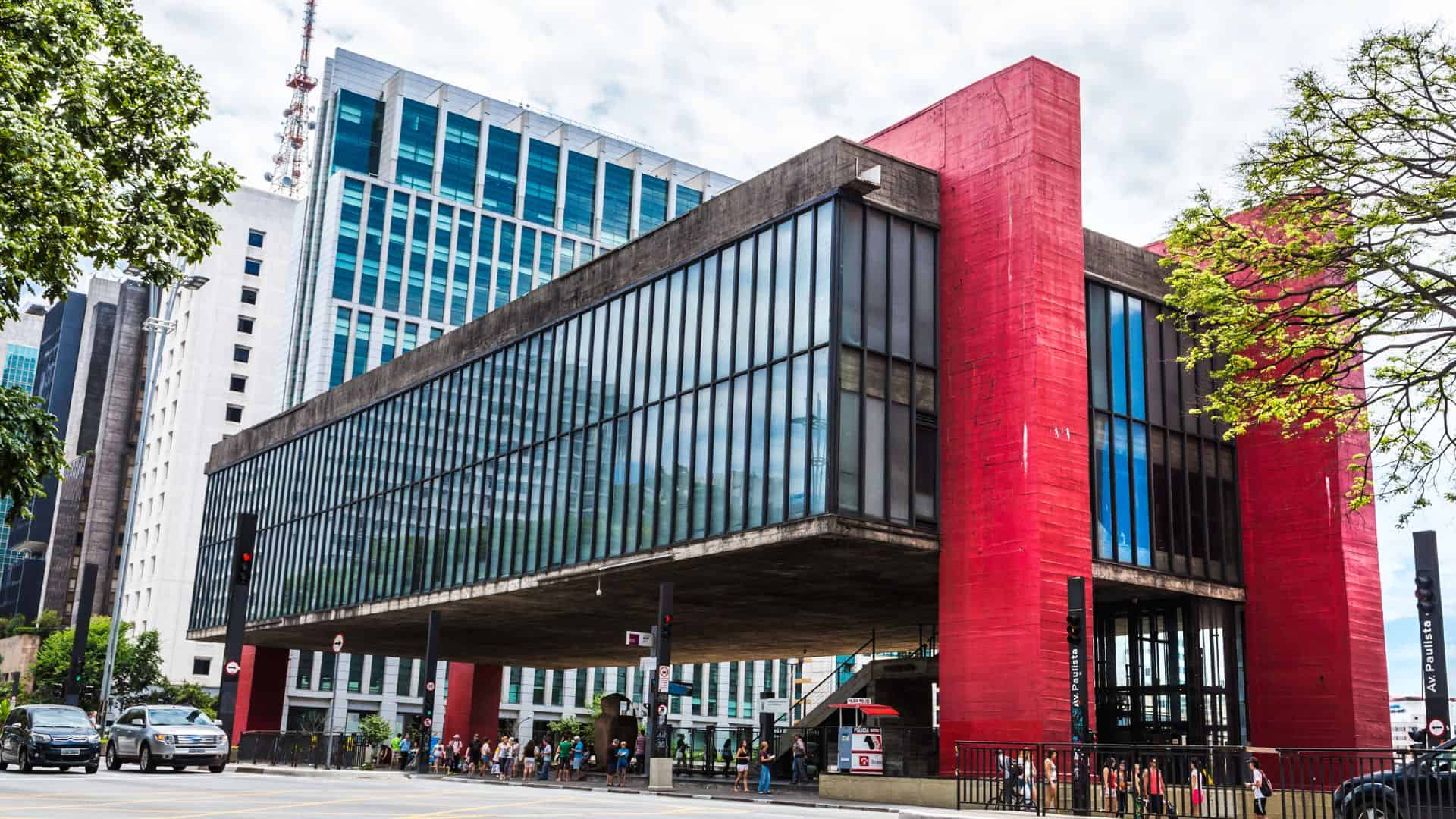
Depending on when you visit, the MASP may house works by Van Gogh, Picasso, and other highly renowned artists. If you’re more into Brazilian culture or history, I’d recommend the following three museums:
Museu do Futebol
This is an awesome soccer museum that also tells a lot of the story of Brazilian history.
Museu do Ipiranga
This museum is all about Brazilian history.
Museu Afro Brasil
This museum goes into detail about the history and present of Africans and African culture in Brazil.
5. Walk Down the Avenida Paulista
The Avenida Paulista, or Paulista Avenue in English, is considered to be the main strip of Sao Paulo. It is lined with skyscrapers, great restaurants, shopping, and parks.
While the Praça da Sé may be the geographical center of Sao Paulo, Paulista Avenue is easily the cultural city center of Sao Paulo. It alone is a big part of what makes Sao Paulo one of the most famous Brazilian cities. On top of that, its numerous shops and stores make it one of the best places to see how Sao Paulo gets its reputation as a major cosmopolitan city.
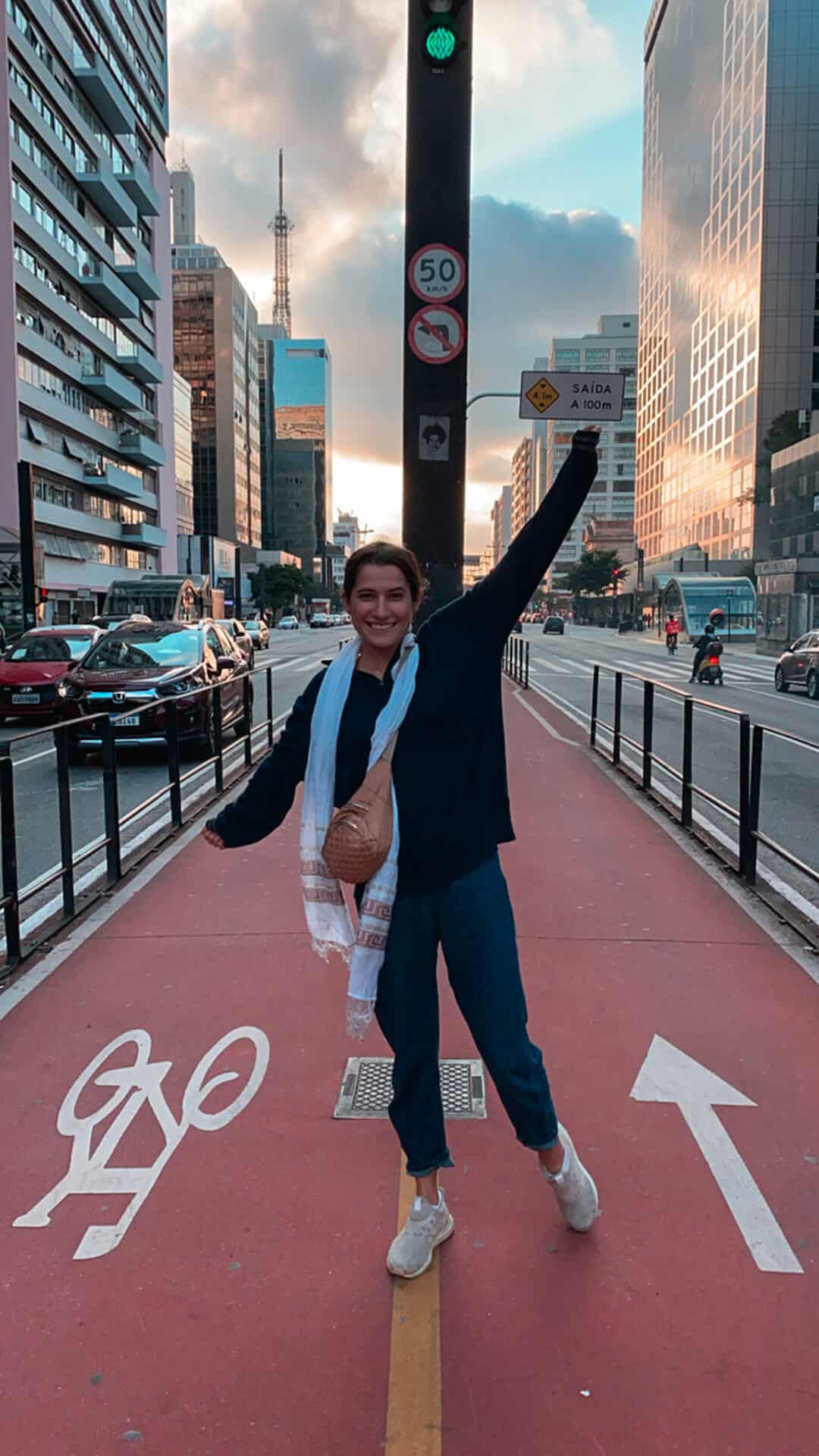
We don’t really have a favorite thing to do here other than wander. There are plenty of great things to come across, and we just recommend walking up and down the almost 2-mile-long strip to find things that interest you. With so many malls, movie theaters, buildings, parks, and vendors, you’re bound to find something that piques your interest!
On the weekends, this area is especially fun and there is even more street food. The Avenida Paulista is also a springboard that will lead you to countless other cool neighborhoods in Sao Paulo.
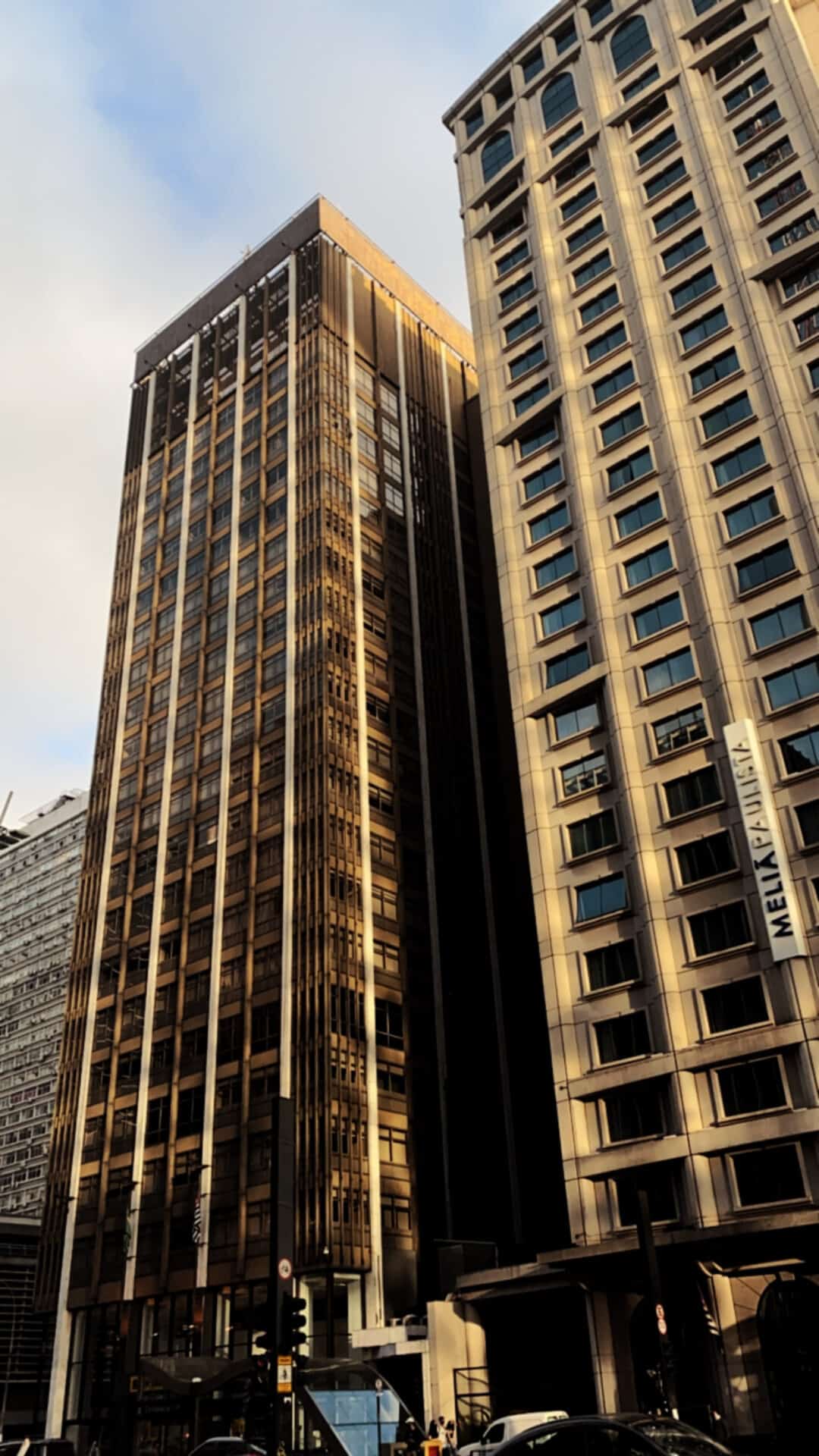
6. Spend an Evening in Vila Madalena or Along the Rua Augusta
Speaking of cool neighborhoods and areas, there are two other neighborhoods that we highly recommend checking out. Our hotel room was just a 10-minute walk from the Vila Madalena neighborhood, and we stupidly waited until our last day to check it out.
This area is really close to the Beco do Batman, and it is filled with awesome restaurants, stores, cafes, bars, and breweries. It’s a pretty hilly neighborhood and might take the wind out of you, but you can totally reward yourself with an ice-cold brew for your efforts.
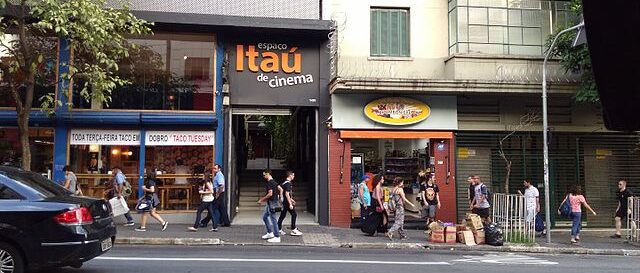
The Rua Augusta is a street that runs perpendicular to the Avenida Paulista and is also lined with awesome food and drink options. You find the best things just by walking up and down the street and seeing what sticks out! This street is loaded with great happy hour specials and the best time to visit is around 3:00 in the afternoon.
We very highly recommend checking out Boardwalk Urbanoide on the Rua Augusta. It’s a gourmet food truck park with Asian, Arab, Brazilian, Mexican, and American foods as well as several drink and dessert options. This is one of the coolest places in Sao Paulo!

7. Fill up on Traditional Brazilian foods
This one goes without saying, as Brazilian food is notoriously delicious. While this is true, we definitely had not heard of some of the most famous Brazilian foods before we arrived.
For example, coxinha (co-sheen-ya) really needs to make your bucket list. It’s basically deep-fried shredded chicken that’s battered in a gnocchi-like covering. It’s hard to describe, but it’s a must-try food.
Also make sure to get to a Padaria (bakery) to try pao de queijo and brigadeiro. Pao de queijo is delicious bread made with cheese in the dough and it’s a Brazilian staple. Brigadeiro is a chocolatey dessert that is worth every single calorie.
Do yourself a favor and try them both.
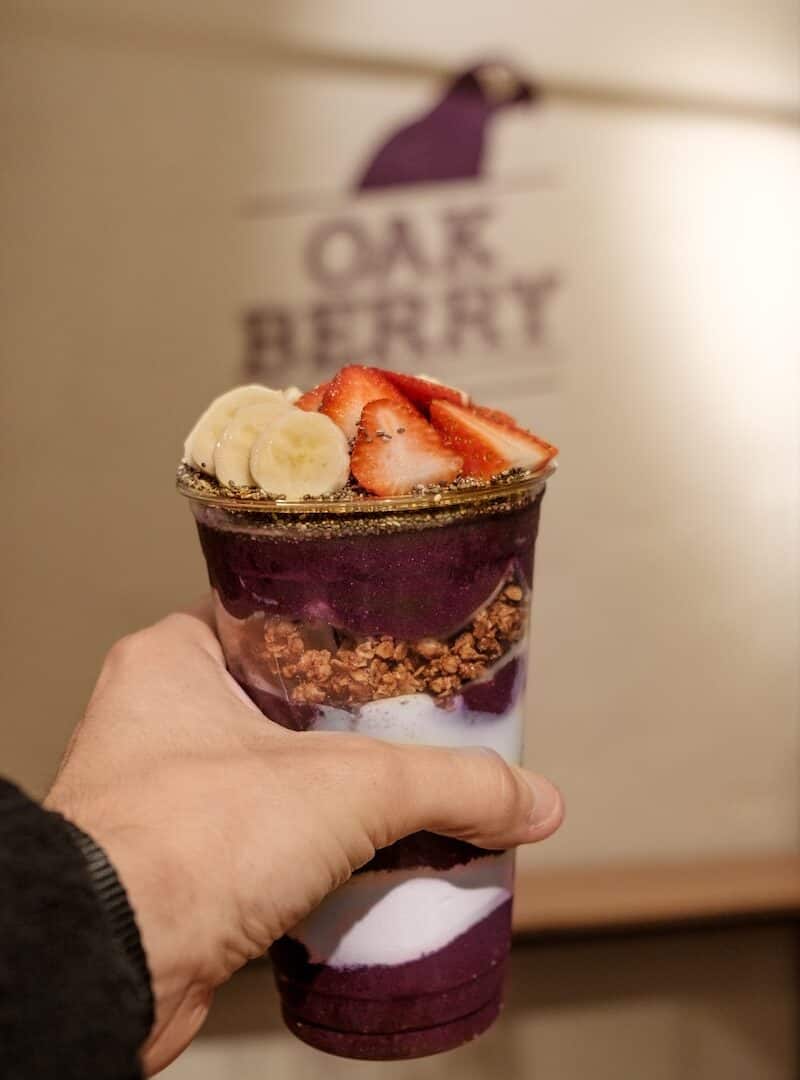
In addition to these, an experience you absolutely cannot miss out on while in Brazil is visiting a churrascaria. A churrascaria is a traditional Brazilian steakhouse, and they are known for serving all-you-can-eat fine cuts of meat. While Fogo de Chao is the chain that has gotten famous around the world, the local spots in Sao Paulo are usually a better bet.
8. Go to a Soccer Match
Brazil = Soccer. Soccer is one of the most culturally important aspects of Brazil, and there are few better places in the world to watch a match than in Brazil. Brazil has several leagues and Sao Paulo has several different teams, making it the perfect place to catch a match.

We didn’t have the chance to go because the stadiums weren’t allowing fans at the moment because of the pandemic, but I’ve heard that a soccer match in Sao Paulo is an absolute must-do if you enjoy sports of any kind. If you get there early, people have told me that Brazilians know how to throw quite the tailgate!
Brazil was the favorite to win it all in the 2022 World Cup. Despite an earlier than anticipated exit, it was clear how much Brazilian soccer fans love their team, as the stadiums in Qatar were filled with green and yellow jerseys!
9. Grab a Mortadella Sandwich at the São Paulo Municipal Market
The Municipal Market is a large indoor mercantile space in the heart of Sao Paulo. Filled with restaurants and food vendors of all types, this space is a fantastic place to grab a bite to eat. The Mortadella sandwiches here are especially famous, and they are too big to even fit in your mouth!
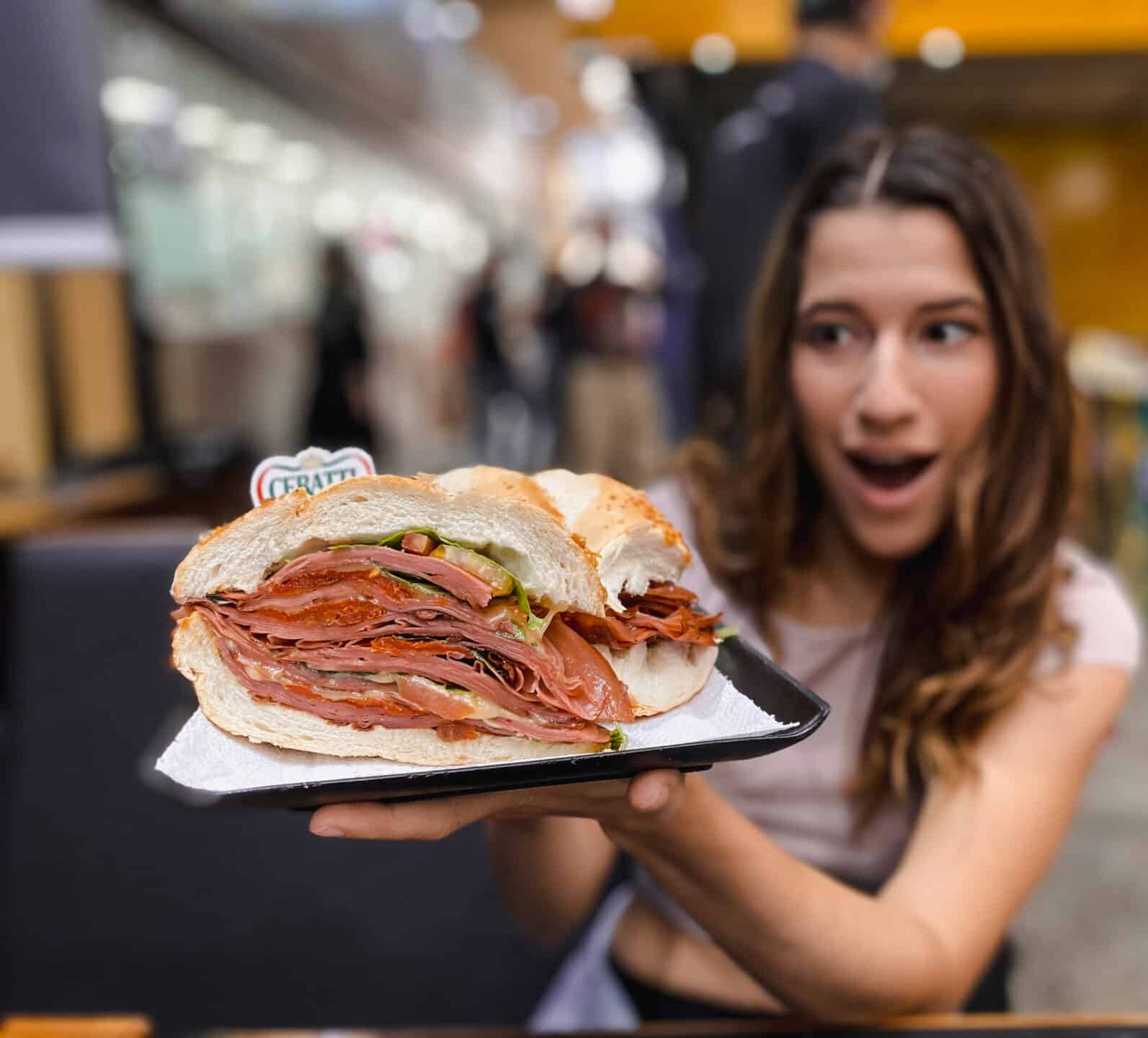
Visiting the Sao Paulo Municipal Market was one of our favorite things we did on our entire trip to Brazil, and eating a Mortadella sandwich along with drinking a local beer is an absolute must.
10. Go for a Guided Tour of São Paulo’s Highlights
As such a big city, planning an itinerary for your trip to Sao Paulo can be overwhelming. With so many things to do, it is naturally a difficult job to plan out all that you will do during your time in the city!
While we normally love to explore places on our own, Sao Paulo is a place where hiring a tour guide may make a lot of sense. There is history and significance scattered all throughout the city, and tour guides are a fantastic resource as you explore this great city. From knowing the spots with the best live music to recommending the best restaurants to indulge in some Brazilian cuisine, working with a tour guide for a single day or more is almost always worth the investment.
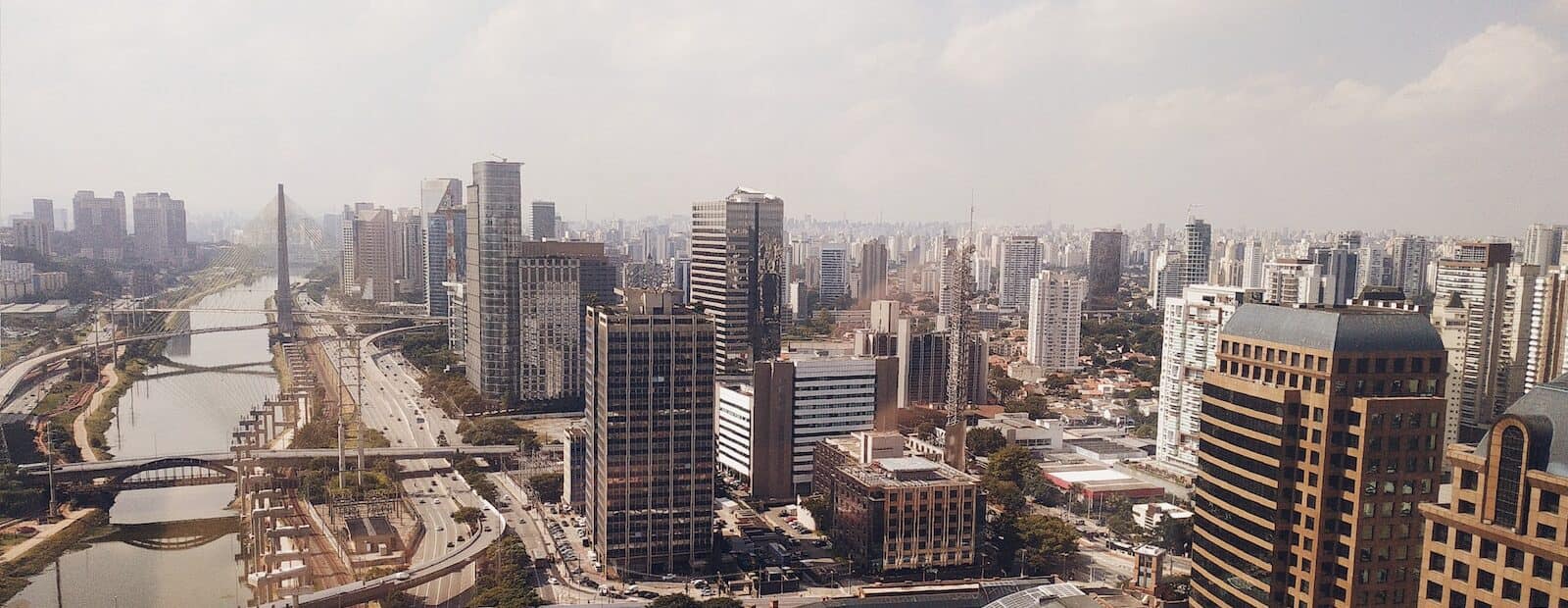
How to Get to São Paulo
If you’re coming from anywhere other than Brazil, you’ll want to fly directly into Sao Paulo. It’s the biggest city in Brazil, and there really isn’t a better city to fly into. Sao Paulo is a day’s drive from the nearest bordering country and a 4-5 hour drive from Rio de Janeiro , which is the only other city that might offer competitive flight prices.
Flights from the United States to Sao Paulo fluctuate greatly depending on where you’re flying from and when you’re flying, but you can expect to pay anywhere from $500 to well above $1,000 for a round-trip ticket. While that might sound steep, it makes a lot of sense, as this flight is very long.
Atlanta to Sao Paulo takes about 10 hours, which is comparable to the flight from New York to Moscow . New York to Sao Paulo is takes 12 hours, which is the same as New York to Abu Dhabi . Scoring a round trip ticket from New York to Moscow for $500 would be a steal.
If you haven’t read my post on tips for finding cheap flights , I’d recommend checking it out before you book your next flight, regardless of the destination. Trust me, it’s worth it – you can save over half the cost of your flight by taking a few easy steps.

READ OUR CHEAT SHEET
Sao Paulo has two airports, but only one of them is internationally focused, and that is Guarulhos International Airport (GRU) . Guarulhos International Airport fairly consistently offers competitive flight options from anywhere in Latin America and North America. If you’re flying from North America, Sao Paulo is probably the cheapest Brazilian city you can fly to.
You may find similar flight prices into Rio de Janeiro, but it’s a long distance from Sao Paulo and doesn’t make much sense unless you also plan on heading to Rio during your trip. If you are considering visiting Rio de Janeiro during your trip to Brazil, we highly recommend doing so.
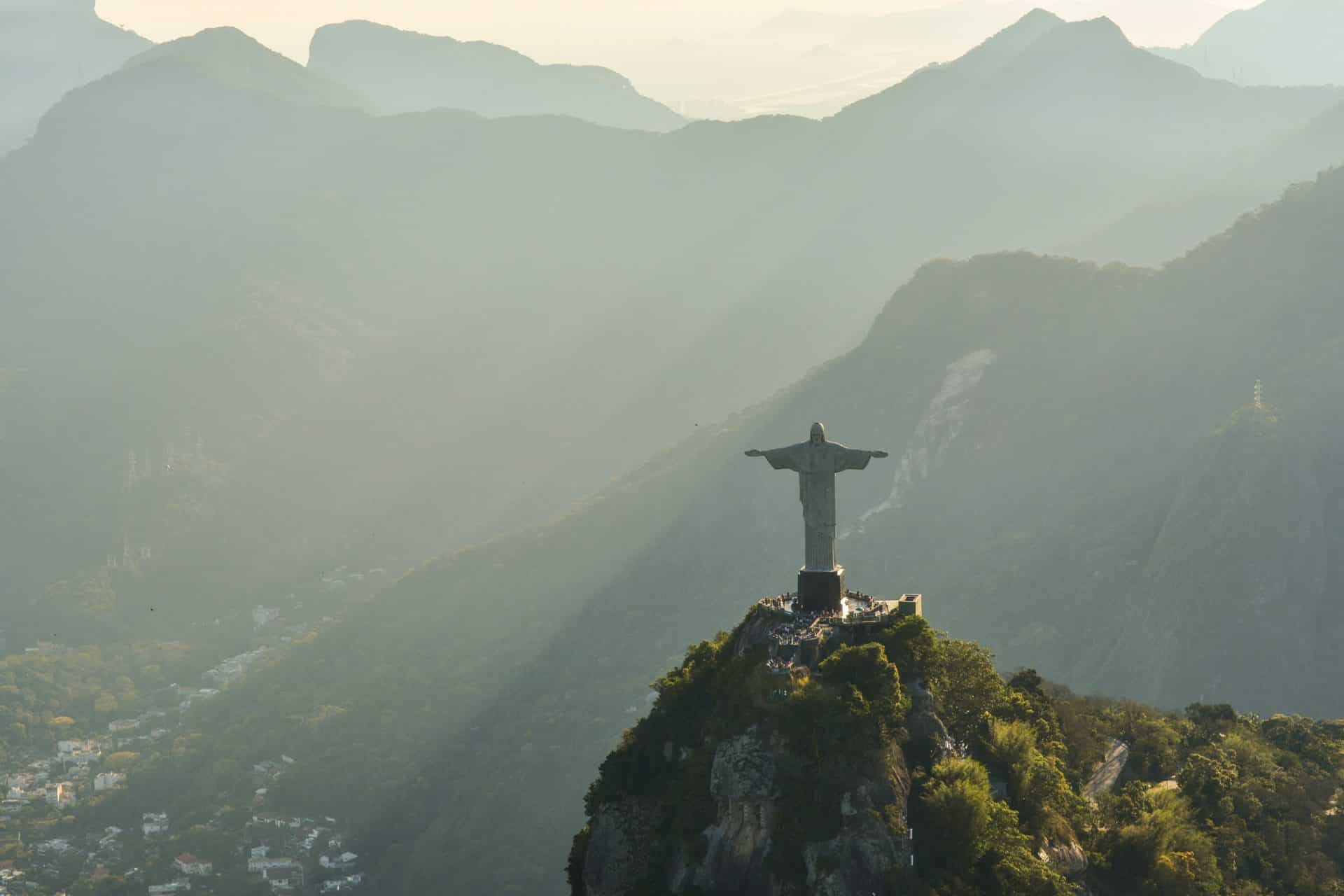
– R E A D –
How to Get Around São Paulo
METRO | UBER
Sao Paulo is easily the most navigable city we’ve visited in Latin America. This is especially noteworthy given the fact that it’s one of the biggest cities in the whole world. Getting around Sao Paulo couldn’t be easier, and there are several different ways to do it.
The best way to get around Sao Paulo is by public transportation. The metro system is immaculate and incredibly accessible. There are 6 lines in the Sao Paulo metro system, and they’ll get you within minutes by foot of wherever you want to go within the megalopolis.
The Metro stops are announced in both Portuguese and English.

The stops are all named in Portuguese, but the metro narrator announces every stop in both Portuguese and English, and using the system is quite easy. It is also pristinely clean and remarkably safe. We used the metro about 90% of the time we wanted to go anywhere in the city, and it never once let us down.
The Sao Paulo metro also runs from very early to very late – about 5:00am to midnight. As a foreigner, your only ticketing option is to buy individual tickets to use as you go, as the refillable card is only available to locals. Each trip costs less than a dollar, and transfers to other lines are free.
The São Paulo metro runs from 5:00 AM to midnight.
The system simply rocks and is one of the two best systems we have ever used. Panama City’s system is comparable in terms of cleanliness, but the only system we’ve encountered in the whole world that is on the same level of reach, quality, and cleanliness as Sao Paulo is in Shanghai, China .
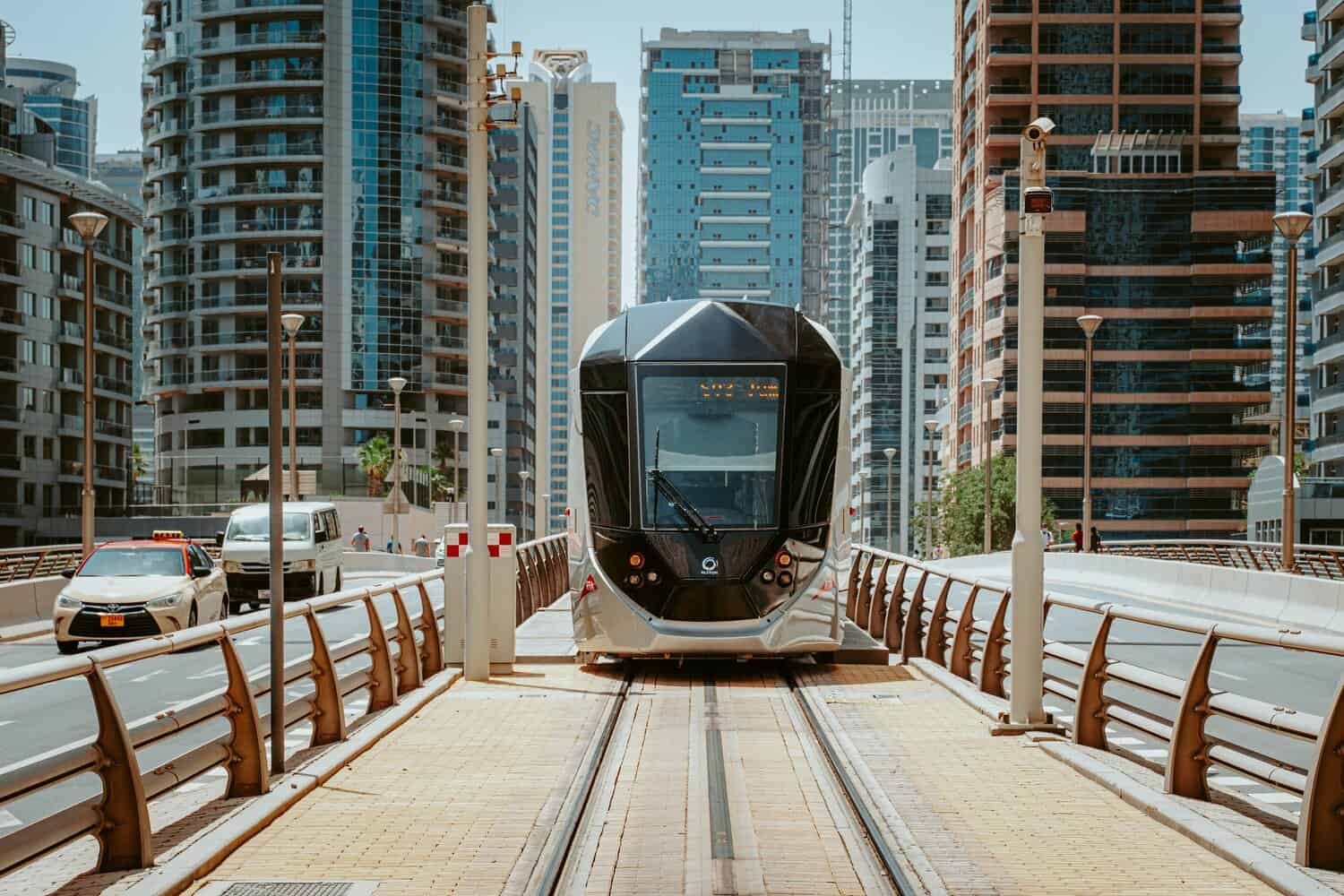
Your next option is Uber, and you also can’t go wrong here. Uber in Sao Paulo is shockingly cheap, and perfectly safe. We went on several 45-minute, 15-mile rides during our trip that cost around $5 each.
There are always Uber drivers around, and Uber is an awesome option if the metro route isn’t convenient or if your trip is relatively close. A 10-minute trip might only cost you about $2, which is only a few cents more than a metro trip but takes significantly less time and effort. You can’t beat that!
To get from Sao Paulo’s main airport, Guarulhos (GRU) to the city, you can use both the metro and Uber. We’d recommend Uber if you have baggage, as wheeling suitcases through the metro system might not be very fun, and an Uber from the airport to the center of Sao Paulo only costs about $15-20 depending on the time of the day.
The metro is also possible, and if you opt for this route your best bet is to either take the Airport-Express train to Luz metro station or take a bus to either Barra Funda, Republica, or Tatuape metro stations, from which you can connect to the rest of the city. We took an Uber to get from the airport to the city, and then the metro to get back from the city to the airport.
Where to Stay in São Paulo
Sao Paulo, along with the rest of Brazil, has a reputation for danger and violent crime. While that is certainly true in some parts of the city, we didn’t feel in danger once during our visit. To us, it felt perfectly safe, and we only took basic precautions to protect ourselves.
With that being said, it doesn’t hurt to stay in a good neighborhood! We explored the entire city, and we definitely recommend either staying in any of the Jardins neighborhoods, somewhere along or near Avenida Paulista, or Pinhieros.
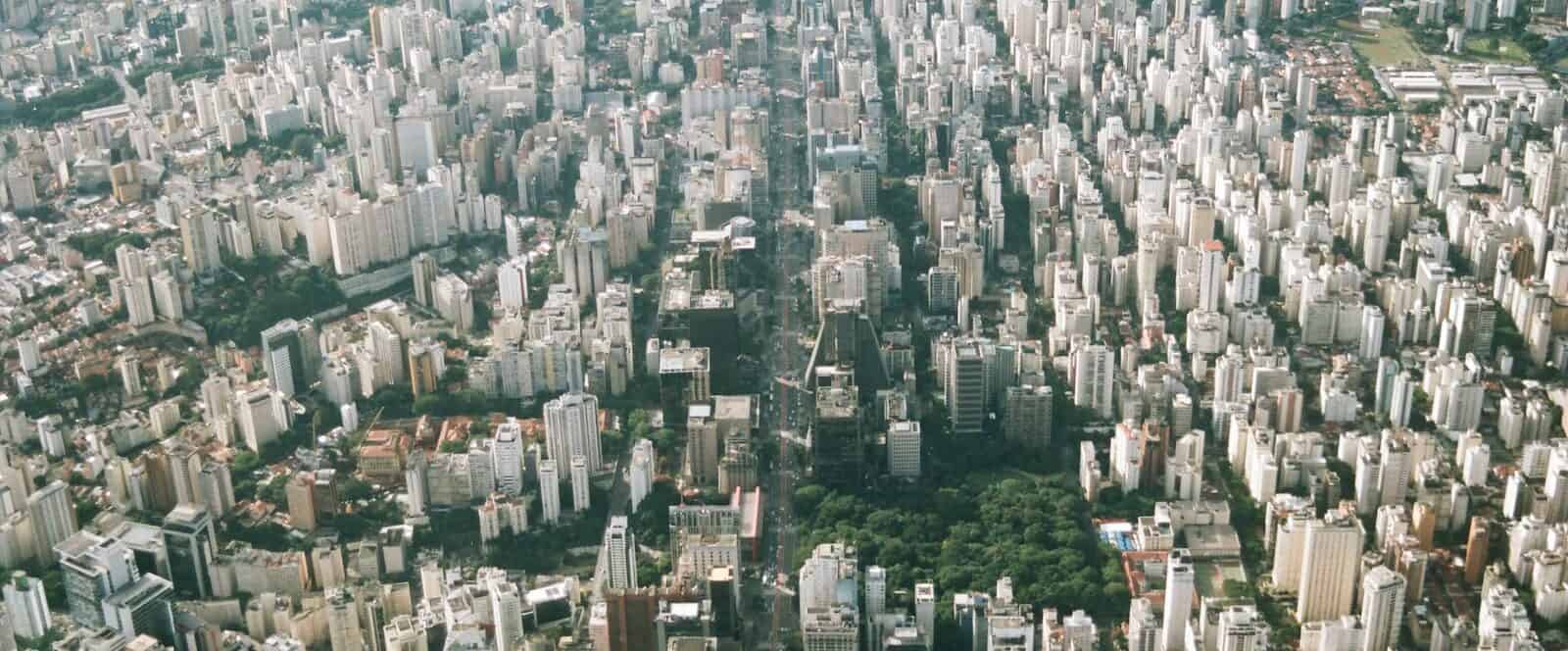
The Best Time to Visit São Paulo
The best time to visit Sao Paulo is during Brazil’s summer months, which run from December to March. This high season is when the city experiences pleasantly high temperatures, nice weather, and fully open amenities.
The ideal time to visit Brazil is from December to March.
While the summer is optimal, the winter months provide comfortable temperatures as well. We visited Sao Paulo in May, and the weather was immaculate. Remember that the Southern Hemisphere’s seasons are opposite of the Northern Hemisphere. Summer in Brazil takes place during winter in the Northern Hemisphere.
Because of its latitude, Sao Paulo is fairly pleasant to visit all year round. The summer months from December to March will provide the warmest temperatures, while the winter months from June to August will be the least crowded.
Because of its latitude, Sao Paulo is fairly pleasant to visit all year round.
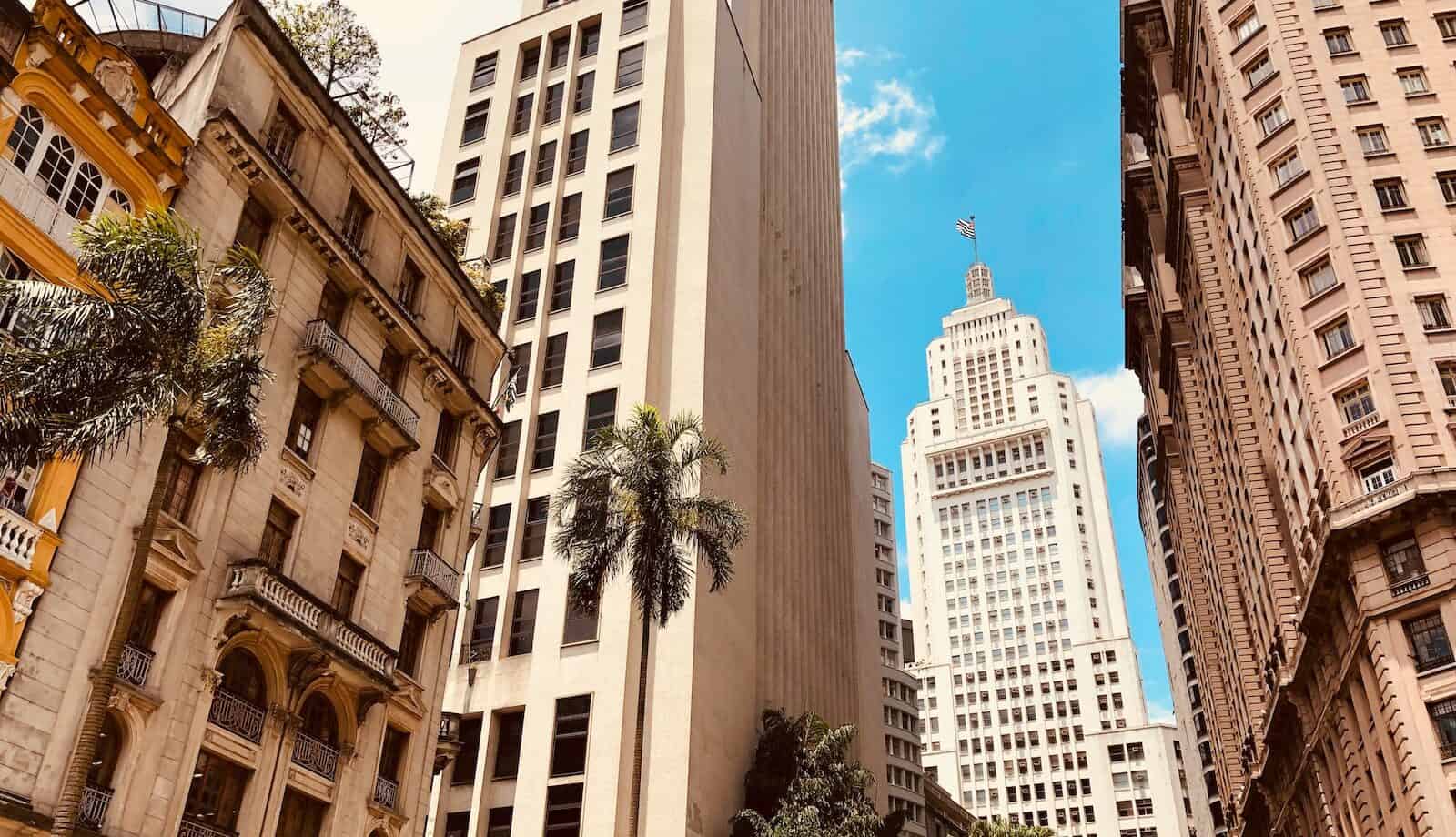
Is São Paulo Worth Visiting?
Brazil is one of the biggest countries in the world, and Sao Paulo is its biggest city by far. Its size doesn’t necessarily mean that it is a good place to visit, though! With all of the other incredible destinations in Brazil and South America, is Sao Paulo worth visiting?
We would certainly say so.
We visited several cities during our time in Brazil, and Sao Paulo was our favorite by far.
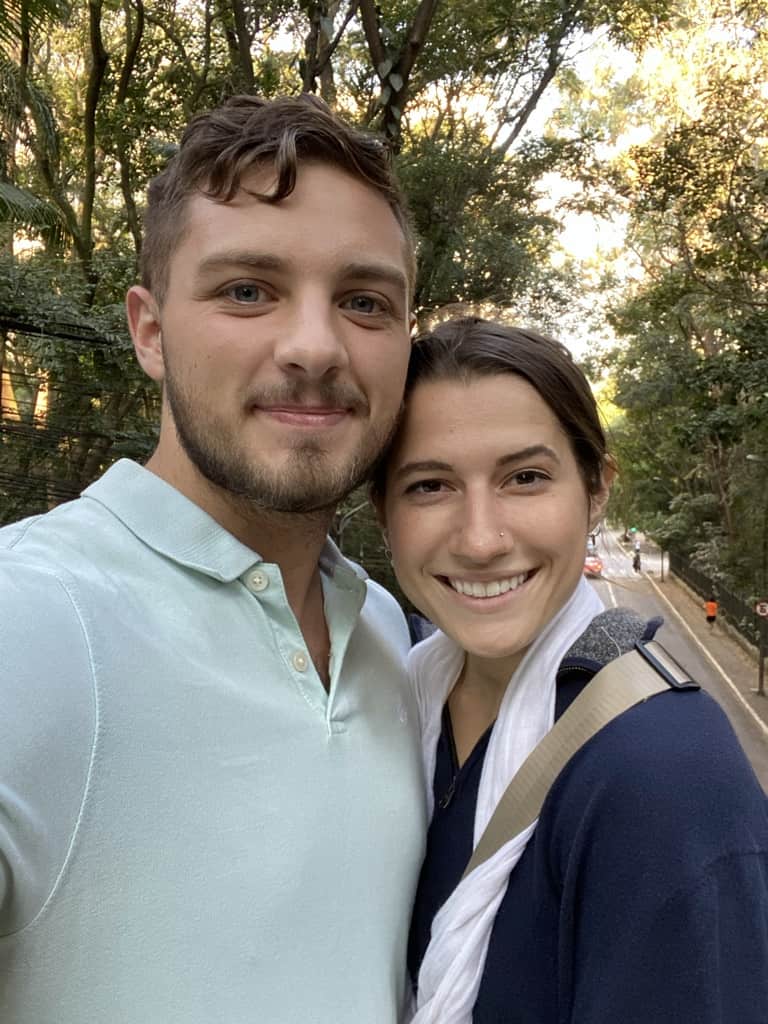
From the diverse Brazilian, Japanese, Chinese, and Italian cuisine to the broad range of fun activities spread throughout the city, Sao Paulo is absolutely loaded with incredible things to do and see. We would return to Sao Paulo in a heartbeat if we had the opportunity!
Sao Paulo is one of the most well-rounded cities that we have ever visited. We even imagine what it would be like living there some day.
Our Final São Paulo Tips
As I said earlier, Sao Paulo is largely a safe city for tourists. We never once had any kind of problem, nor did we feel endangered in any way. While this might not be the case in certain bad neighborhoods on the fringe of the city, you really have no need to visit them anyway.
Beware of Pickpocketers
If you stick to the main things to do in this Sao Paulo travel guide, you shouldn’t experience any threats. Still, you should take the normal precautions that you would take in any big city. There is a pickpocket risk in just about any metropolis on the planet, and Sao Paulo is no different.
Be Cognizant That Sao Paulo Has Major Poverty
Be prepared to see some interesting manifestations of poverty in certain popular areas, too. For example, the Cathedral Square and its surrounding area are notoriously home to hundreds of tents where homeless people are living. While 99% of them are not looking to cause you any harm whatsoever, we were warned that desperate people may do desperate things and that in areas like this you should watch your pockets and keep your phone and other valuables hidden.
Follow the Crowd
We discovered that one of the best ways to get a feel for Sao Paulo was walking around and just following the crowds. By doing this we wound up at open-air markets, awesome street food locations, beautiful parks, and more.
Speaking of parks and doing what the locals do, drinking in the streets is completely legal, but being drunk isn’t. Take your beer with you on your walk or take a bottle of wine to a picnic, but be responsible!
Hi, I'm Greg. I'm an avid traveler who has traveled to over 50 countries all around the world with my wife and kids. I've lived in Italy, Mexico, China, and the United States, and I dream of moving abroad again in the future. With this blog, I provide my audience with detailed destination guides to my favorite places and pro-tips to make travel as stress-free as possible.
Bill Sheikh
Excellent writing, good summary and I am planning to visit. Thank you.
Thanks, Bill! Have an amazing trip and feel free to reach out with any questions!
Leave a comment
Save my name, email, and website in this browser for the next time I comment.
Meet The Author - Greg

Recent Post

How Much Does a Trip to Egypt Cost: Budget Breakdown
March 10, 2024

Best Time to Visit the India Gate in Delhi [2024]
March 1, 2024

Flying with a Sinus Infection: Tips to Avoid Pain
February 20, 2024

11 Best Things to Do in Breckenridge Besides Skiing
February 12, 2024

10 Best Beaches in Mexico for Families (We Lived Here)
February 3, 2024


Is Brazil Safe to Visit?
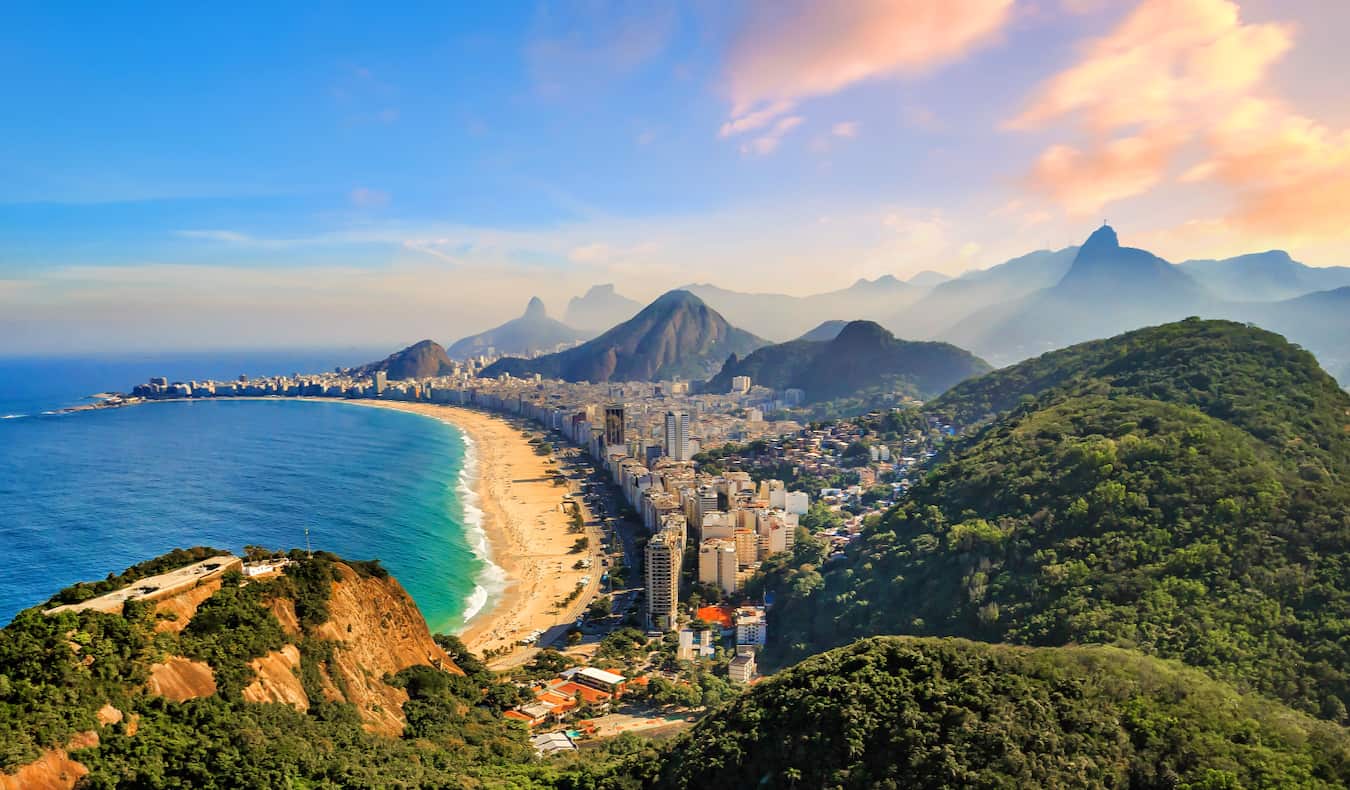
Offering pristine nature and access to the Amazon rainforest, historic cities and colonial architecture, and lots of affordable food and activities, Brazil has some something for every traveler.
But is it safe?
Brazil has a reputation for being a rough-and-tumble destination, one where travelers need to be extra cautious and on their guard at all times.
Due to one of the highest rates of income inequality in the world , the country also has some of the highest crime and homicide rates . Luckily, these rates have been declining in recent years, with Brazil’s homicide rate at its lowest in over a decade .
Still, petty theft and street crime are common in Brazil, so travelers here need to be vigilant. But that doesn’t mean you should avoid the country. You just need to be a smart traveler. Millions of people visit every year and don’t have a problem. As long as you follow the suggested safety tips below, you’ll minimize the likelihood anything bad will happen to you.
Here is everything you need to know to stay safe in Brazil and make the most out of your next trip.
Table of Contents
13 Safety Tips for Brazil
Is street food in brazil safe, can you drink the water in brazil, is brazil safe for solo travelers, is brazil safe for solo female travelers, why is rio de janeiro dangerous, is it safe to travel to rio de janeiro, what’s the safest area to stay in rio de janeiro, is carnival in brazil dangerous, is it safe to drive in brazil, are taxis in brazil safe, what part of brazil is safest.
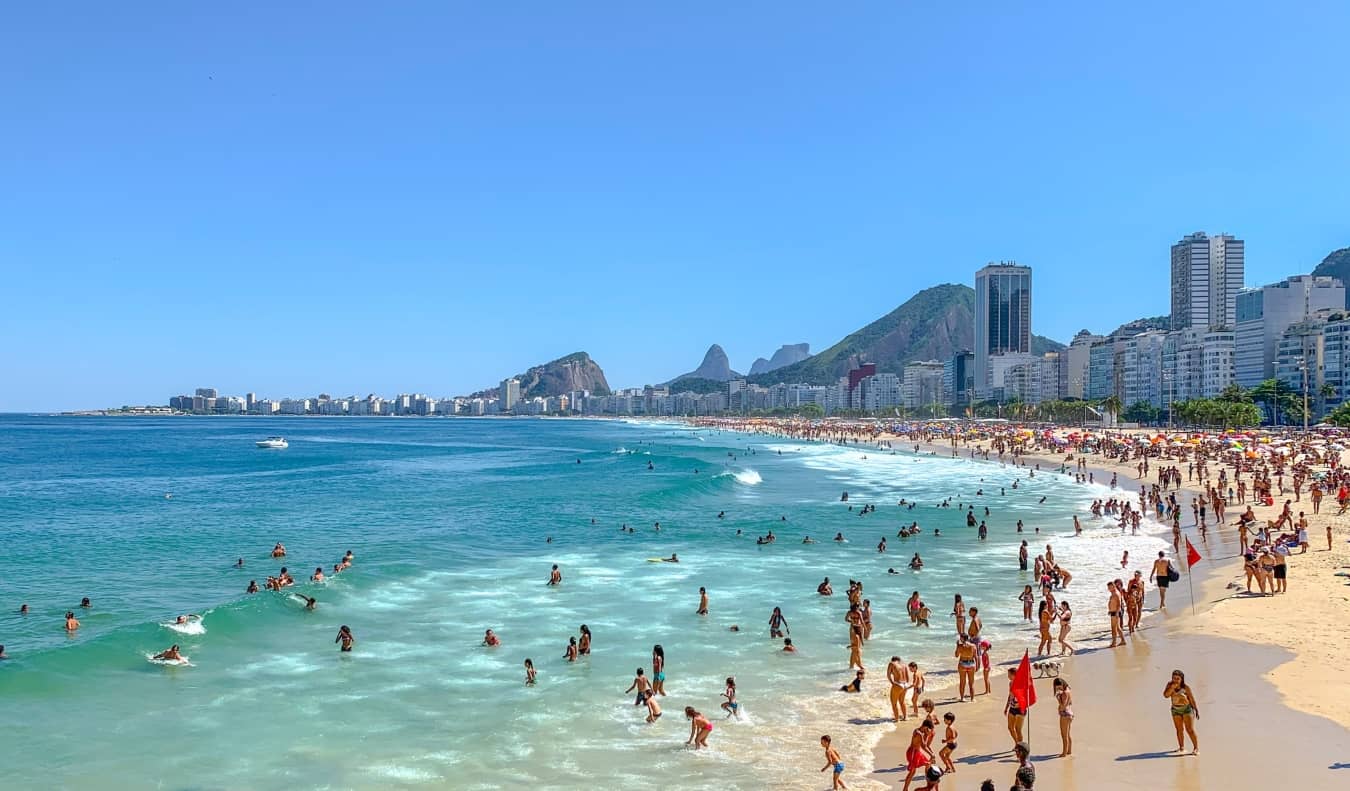
1. Walk with purpose – When out exploring, always walk with purpose. Look like you’re heading somewhere in specific, even if you’re not. Pickpockets and muggers look for travelers who are unsure of themselves. Don’t look like a target and definitely don’t walk with your cell phone in your hand. Keep it safely stowed away in a front (never back) pocket or a zippered pocket in your bag.
2. Carry a spare wallet with only a small amount of cash – Bring a spare wallet and only carry the minimum cash needed for the day in it. Keep the rest locked up back in your accommodation. That way, if you get robbed or pickpocketed they won’t get your real wallet (where you’ll keep the rest of your cash and cards).
3. Separate your cards – If you have more than one credit or debit card, keep them separate. Bring one with you for the day (if you think you’ll need it) and leave the other one locked up in your room. That way, should something happen, you always have at least one card remaining.
4. Don’t bring valuables to the beach – When you go to the beach, don’t take anything unnecessary. Towel, bathing suit, and a small amount of cash. That’s it! Anything else you bring is likely to disappear!
5. Dress to fit in – When out and about, dress to fit in. Leave any valuables or jewelry at home. Don’t walk around flashing your camera or phone (this is the biggest thing that Brazilians will warn you about again and again). If you need to use them, be discreet. Stand with your back to a wall so that no one can approach you from behind.
6. Download the Prey app to your phone and laptop – If either device gets stolen, you’ll be able to track it and remotely turn on your camera to photograph the thief (you can also wipe the data and message the thief too). The Prey app costs just $1.30/month.
7. Avoid outdoor ATMs – If you need to withdraw cash, only use ATMs inside buildings. Always be aware of your surroundings before you take out your wallet.
8. Double-check your accommodation – No matter where you are staying, be sure to check the doors and windows before leaving for the day and before settling in at night. Don’t leave anything valuable lying around your room; lock everything up in your hostel locker or hotel room safe.
9. Don’t accept free food/drinks – Never accept drinks or food from strangers. Drugging victims before they are robbed is common, so decline free food or drinks from strangers. And if you’re out drinking, always keep your eyes on your drink. Drinks can be spiked at any moment, so only hand it to someone you trust if you need to.
10. Watch out for distractions – Thieves will often try to distract you before they rob you. They often work in teams, with one person distracting you by asking questions (like for directions) and the other pickpocketing you. Be mindful of this and other common travel scam . Always stay vigilant when other people approach you and stay on your guard in crowds.
11. Don’t walk around at night alone – If you have to, avoid city beaches, parks, and empty streets. Generally, even local Brazilians don’t walk around much at night. Take an Uber or taxi (they’re super affordable) back to your accommodation if you’ve been out late.
12. Take precautions when driving – If traveling by car, always keep your doors locked. By on guard at stop signs or red lights, especially at night. Many Brazilians won’t even stop for them to avoid the risk of carjacking.
13. Buy travel insurance – I never leave home without it and you shouldn’t either. With travel insurance, you’re protected against unexpected costs that might arise should something bad happen on the road. It’s always better to be safe than sorry!
I recommend SafetyWing for travelers under 70, while Insure My Trip is the best choice for travelers over 70.
You can check out this widget to get a quote for SafetyWing:
For more information on travel insurance, check out these posts:
- What Does Travel Insurance ACTUALLY Cover?
- The Best Travel Insurance Companies
- How to Buy the Best Travel Insurance
Yep! You’ll find all sorts of amazing street food stands in cities like Rio de Janeiro as well as near the beaches and you’d be missing out if you didn’t try them! Just make sure to stick to places where there are a lot of locals gathered. That’s how you know the food is not only safe but delicious too.
I’d suggest avoiding street food with shrimp or seafood as it spoils quickly. For the most part, you’ll encounter places that sell various kinds of meat. As long as it is fully cooked and hasn’t been in the sun all day, dive in and give it a try!
The water in Brazil is generally not safe to drink. Most Brazilians caution against it and instead use filters or drinking bottled water, especially in more remote areas or regions with questionable water quality. The tap water has something of an odd taste, due to the purification process, so while it’s fine for brushing your teeth, you don’t really want to drink it when you’re thirsty.
If you’re staying in a hostel or a hotel, you may have access to a filter, though not always. It’s a good idea to bring your own as well, so you’re prepared for any situation. Lifestraw is my go-to choice for a water bottle with a built in filter. If you do buy bottled water, make sure it is properly sealed before opening and drinking it.
Brazil is safe for solo travelers, though I would only suggest solo travelers visit here if they have some experience traveling solo already. It’s not the best place for newbie travelers to test the waters.
If you are concerned as a solo traveler, try to meet-up with other travelers at hostels. Traveling together, you can keep each other company and deter any potential petty theft or robberies.
Brazil faces real issues of poverty and crime so solo female travelers will need to be on guard. This is not a destination for new travelers and I would only suggest solo female travelers visit here if they are experienced solo travelers. Even then, you’ll want to make sure you take every precaution that you can.
Check with your hostel or hotel staff to find out if you should avoid any specific areas. Also, learn as much as the local language as you can so you don’t stand out.
Rio de Janeiro gets a bad reputation due to massive favelas (shantytowns), where high rates of crime occur. Historically, these areas have been run entirely by gangs and drug dealers, though in recent years, certain favelas have started to be managed by Pacifying Police Units. Still, these areas are generally not safe for outsiders, and you shouldn’t be exploring there on your own.
Outside of the favelas though, Rio is a big city like any other, and you can enjoy traveling there as long as you exercise normal precautions.
Rio can absolutely be a safe destination for travelers, as long as you stick to the safer areas (avoid favelas) and keep your wits about you. Just like in any major city, it’s important to take precautions. Stay in well-populated and well-lit areas, avoid displaying valuable items, and be cautious at night. Stay informed about local safety concerns and follow the advice of locals and authorities.
The safest areas to stay in Rio de Janeiro are Ipanema and Copacabana. These areas are right along the city’s iconic stretch of beach and popular among tourists. You’ll find a range of accommodation options (most travelers stay here and most of the best hostels in Rio are here), restaurants, and attractions in the area. It’s perfectly safe to walk around during the day (exercising normal precautions), though like anywhere in Rio, you might want to take a taxi or Uber at night.
Going to Carnival in Brazil is a once-in-a-lifetime, bucket list experience for many travelers. But because of the big crowds and rowdy atmosphere, it’s essential to exercise caution. Pickpocketing and petty theft are rampant during this time. Thieves know that people are partying, drinking, and generally not paying much attention to their surroundings. Always stay extra vigilant and only go out with what you absolutely need. Be wary of drinking too much and if you can, always stick with a buddy. Adhere to the above tips extra closely during Carnival.
I’ll be honest, I don’t recommend renting a car here. It’s unnecessary, the traffic is terrible, the roads are poorly maintained, drivers are aggressive, and parking is expensive. While major highways are generally safe, driving in urban areas, especially during rush hour or at night, requires extra caution. Break-ins and carjackings are common.
Taxis, Ubers, long-distance buses, and domestic flights are generally so cheap in Brazil that, personally, I’d avoid renting a car unless you really need to.
Taxis in Brazil are safe and plentiful. They use meters as well, though it’s always a good idea to ask your hotel or hostel staff for an approximate fare before you head out. There are always a few bad apples that will try to rip you off, so just be sure to pay attention to the meter and make sure it isn’t rising abnormally fast.
Also, it’s always best to call your taxi in advance; you can use the 99 app (formerly 99Taxis) to hail a cab. Never flag a taxi on the street (this is especially true at night). Ubers are also plentiful and affordable across the country.
Florianópolis , Brasilia (the country’s capital), Curitiba, and Belo Horizonte are among the safest cities in Brazil, with some of the lowest crime rates in the country.
Vacation destinations like Fernanda do Noronha are also quite safe.
However, even big cities like Sao Paulo and Rio de Janeiro , which have higher crime rates, are well-traveled, and as long as you follow the tips above and stay vigilant, you can stay safe while enjoying these incredible cities.
Brazil is an amazing, vibrant country. But it’s not without its risks. Travelers here will need to be on guard and keep their wits about them. Petty theft is common and can be rampant during big events like Carnival, where the many distractions and crowds make pickpocketing easy. But if you follow the tips above you should be able to have an incredible visit while still staying safe.
Trust your gut, use common sense, and make sure you have comprehensive travel insurance . Do that, and you’ll be able to stay safe in Brazil and have a memorable visit to this energetic country.
Book Your Trip to Brazil: Logistical Tips and Tricks
Book Your Flight Use Skyscanner to find a cheap flight. They are my favorite search engine because they search websites and airlines around the globe so you always know no stone is left unturned!
Book Your Accommodation You can book your hostel with Hostelworld as they have the biggest inventory and best deals. If you want to stay somewhere other than a hostel, use Booking.com as they consistently return the cheapest rates for guesthouses and cheap hotels. My favorite places to stay are:
- Discovery Hostel (Rio)
- Geckos Hostel (Florianopolis)
Don’t Forget Travel Insurance Travel insurance will protect you against illness, injury, theft, and cancellations. It’s comprehensive protection in case anything goes wrong. I never go on a trip without it as I’ve had to use it many times in the past. My favorite companies that offer the best service and value are:
- Safety Wing (best for everyone)
- Insure My Trip (for those over 70)
- Medjet (for additional evacuation coverage)
Looking for the Best Companies to Save Money With? Check out my resource page for the best companies to use when you travel. I list all the ones I use to save money when I’m on the road. They will save you money when you travel too.
Want More Information on Brazil? Be sure to visit our robust destination guide to Brazil for even more planning tips!
Hi, I’m Nomadic Matt, the New York Times best-selling author of How to Travel the World on $50 a Day and Ten Years a Nomad, as well as the founder of this website! And I’m here to help you save money on your next trip.
Got a comment on this article? Join the conversation on Facebook , Instagram , or Twitter and share your thoughts!
Disclosure: Please note that some of the links above may be affiliate links, and at no additional cost to you, I earn a commission if you make a purchase. I recommend only products and companies I use and the income goes to keeping the site community supported and ad free.
Related Posts
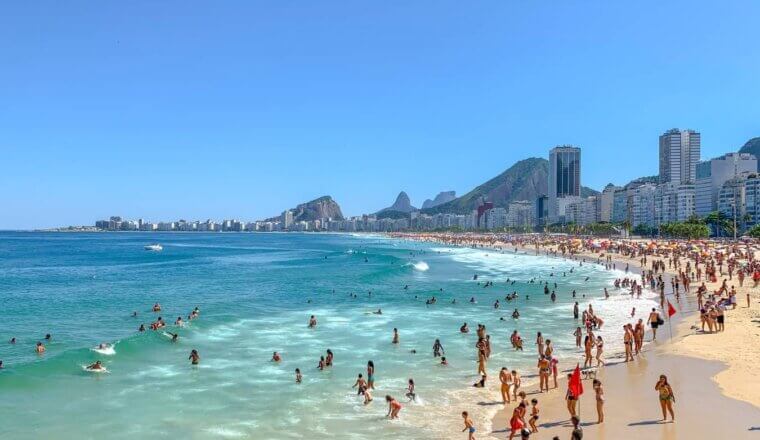
GET YOUR FREE TRAVEL STARTER KIT
Enter your email and get planning cheatsheets including a step by step checklist, packing list, tips cheat sheet, and more so you can plan like a pro!


21 Jul 21 Dos and Don’ts to Travel Safe in Brazil

When I mention that I traveled to Brazil (majority of the time alone) one of the first questions I always get is, “Is Brazil safe to travel to?” Or more specifically, did I feel safe as a solo female traveler in Brazil. Both are fair questions, and my answer is…it’s complicated.
In short, yes, Brazil is safe enough to travel to – but read my more in-depth response here . My personal experience is that I had no negative incidents involving safety or theft while in Brazil and I loved the country so much I stayed for 3 months and would go back in a heartbeat. However , I simultaneously know many tourists who were victims of theft in Rio de Janeiro especially.
You could call me lucky that nothing happened to me, which is fair because sometimes things just happen. But I was also extremely cautious and extremely aware. Specifically, I followed the tips mentioned in this blog post and I think that made a huge difference.
So if you’re traveling to Brazil, here are 21 dos and don’ts to stay safe:
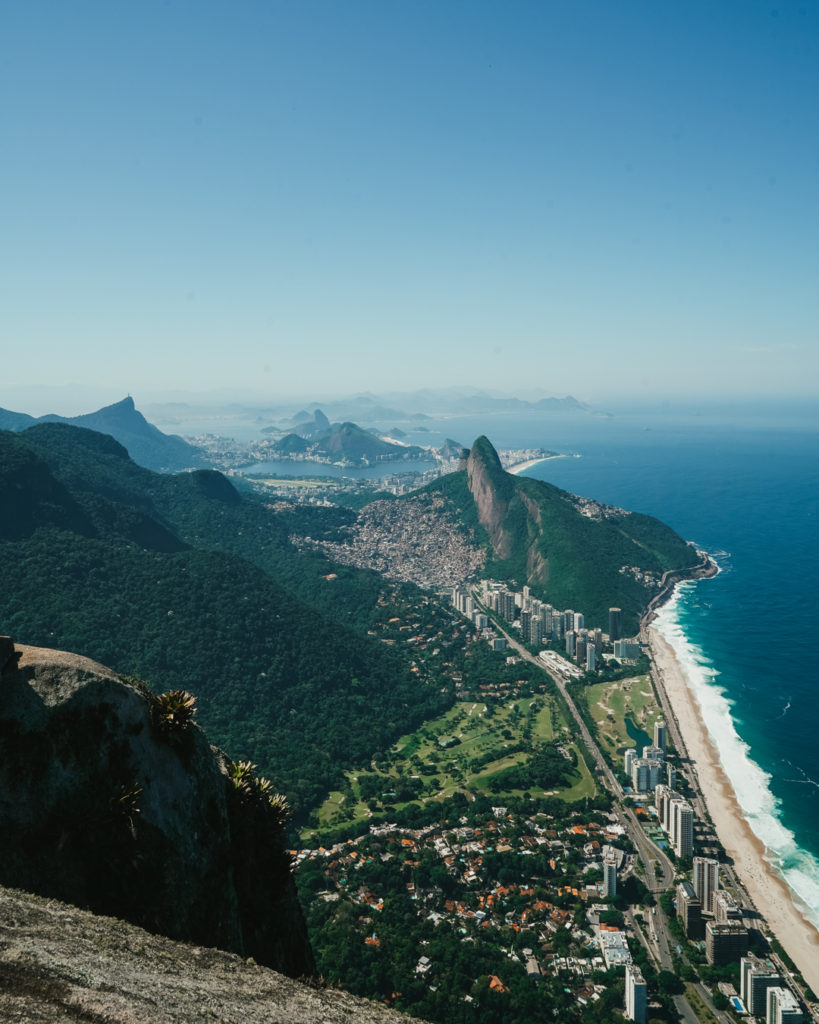
*This post includes affiliate links and I may receive a small commission at no additional cost to you. By using my links you’re merely supporting what I love to do: write this blog! I only recommend products/companies that I use myself.
1. pull your phone out on the street
Walking around with your phone out is really the worst possible thing you could do – especially in Rio. No matter how hard you grip that phone, there’s a decent chance someone will swipe it even in broad daylight. If you must look at your phone (for example directions or ordering an Uber), I recommend stepping into a shop. If that’s not possible, step away from walking traffic and look around before pulling it out quickly. If you’d like to take a photo, consider if it’s a smart move and be conscious of people walking by.
This is by far the most important tip on this list. I think we’re so accustomed to pulling out our phones constantly to scroll through social media or just walking with our phone in hand. But in Brazil I strongly discourage you from doing this.
2. Don't walk alone at night
Walking alone at night makes you an easy target, especially in places like Copacabana in Rio, so try to avoid it at all costs.
During the day, it’s obviously okay to walk alone, but it’s good practice to be mindful of your surroundings and the area you’re in. I wouldn’t recommend walking near a favela alone and suggest staying in more populated areas.
3. don't Put valuables in your pockets
If you’re in the habit of putting valuables in your pockets – break it! This is an easy way to be pick-pocketed. Instead I highly recommend having a cross- body sling. A standard sling like this one works, but for safety I most recommend the PacSafe sling which is an excellent investment if you travel often or live in a city.
4. don't wear showy items like gold jewelry
Flashy items make you a target in Brazil. Personally I love gold jewelry, but even though all of mine is fake, wearing it would make me a target. Studs and small hoop earrings should be fine, but necklaces and bracelets I would refrain from wearing – as recommended to me by local Brazilians.
5. don't leave your valuables unattended to
Never leave your valuables unattended to in Brazil. This includes at coffee shops where you may have your laptop or iPad out while going to the bathroom. It’s not to say that the people around you are bad or won’t watch your things when you ask, because they will. But usually when we ask someone, “Hey can you watch my stuff?” we don’t actually believe someone is going to come and swipe our stuff while you’re gone and the person watching your things will actually need to run after them… However, in some places of Brazil this can totally happen. Especially if you’re sitting near a window near the street. I knew of a girl who lost her iPad this way..so just don’t do it.
6. don't use the metro at night
The metro in Sao Paulo and Rio de Janeiro are great. I took the metro in Rio many times and it was cheap, safe, and clean. However, I wouldn’t recommend it in two scenarios: at night and with a laptop or camera. Otherwise I actually recommend it during the day especially if you’re on a tight budget.
Now that you know what not to do to stay safe in Brazil while traveling, let’s jump into what you should do.

Also read: The Ultimate List of things to do in Rio de Janeiro
7. pack a theft-safe cross body bag.
A lot of pick-pocketing happens when someone’s wallet or phone is in their pocket or open bag. Do yourself a favor, and get yourself a sling, cross body bag so that your valuables are always zipped away and close to your chest.
My favorite cross-body slings are from Pac-Safe . They’re RFID blocking, have theft-proof zippers, and cut-proof straps. They check all my boxes for a safe cross-body travel sling including having inside zipper compartments and a clip in the front vs. in the back.
But if you’re looking for a cheaper option, I suggest this highly-rated one on Amazon .

8. Be cautious of your valuables while sunbathing on the beach in Rio
The beaches in Rio are stunning, but while sunbathing be wary of your belongings. I recommend keeping everything in your bag (i.e don’t leave your phone or kindle out on the towel) and have your bag secured somewhere. Personally, when I would close my eyes I put the strap around my arm so my bag could not be grabbed in passing.
If you go to the beach alone (which I did often) also don’t leave your valuables unattended when you swim. I use a waterproof fanny pack or you can ask someone to watch your things if you feel comfortable doing so.

9. leave one bank card in your suitcase
When you go out, it’s best not to bring all your bank cards in case, god forbid, your wallet is stolen. I always leave my debit and credit cards locked at my place and take only one travel credit card. The Chase Sapphire Preferred is my go-to.
Read more about why I recommend the Chase Sapphire Preferred card here.
Note: this tip is good practice always when you travel, not just in Brazil.
10. Use Uber if possible
Uber is a really convenient way to get around, and for safety reasons I love it because you have more control as the passenger: you have a set price, the information of the driver, and you can share your trip for added security. Uber is available in the major cities of Brazil, so if it makes you feel safer, use it.
11. Leave your passport in a safe place, and bring copies to the country
Whenever you go somewhere (unless it’s required or needed) it’s best to not walk around with your passport in your day bag, just in case you lose it. But in the worst case scenario that you do, it’s also good to travel with printed copies in your suitcase if you needed to go to your embassy for a lost passport.
12. Bring minimal stuff when you go out to party
Now that I’ve mentioned to leave your passport and any unnecessary cards locked at your place, make sure you DEFINITELY do this when you go out to party in Brazil. This is when many people are pickpocketed because they’re drunk or high and less mindful. I know some people who even use burner or their old phones when partying in “high-risk” destinations like Rio or Salvador during Carnaval. Not a terrible idea if you have an extra or old phone.
13. Try not to stand out as a tourist too much
Being a tourist is not a bad thing and to be honest, even if you try not to stand out, you probably still will. And that’s okay! It’s more about not standing out too much and making yourself a massive target for pick pocketing. So don’t wear flashy items, be protective of your phone and camera, and maybe switch your “I Love Rio” shirt for a Flamengo jersey (Flamengo is a local and very popular team in Rio de Janeiro).
14. Practice extra caution in heavily touristic areas
Touristic areas of every destination always have a downside…they seem to attract the most sketchy characters. This is the same for Brazil. For example, in Rio you should practice extra caution in Copacabana, Lapa and other touristic places.
15. Be mindful of your things at an outdoor restaurant
When seated at an outdoor restaurant (which will happen often because Brazil loves al fresco dining), again be mindful of your things. Don’t plop your phone on the table and swing your purse over the back of your chair which faces the street. This behavior may be a habit to you, but like all the other tips in this list – think about your valuables and make sure they’re secured and can’t be swiped.
16. Avoid deserted areas
In general, it’s best to stay away from deserted areas. When you’re alone there’s no one to help so it’s always best to stay where others are too.
17. Double check the area of your accommodation before booking
Before booking your stay, it’s always good practice to do a little research on the area and read reviews from other travelers with location safety in mind.
18. Party safely
Partying in Brazil is not only a must, but a difficult thing to avoid. And as someone who was there for two Carnavals, I full heartedly support this! Just make sure you party safely by:
- Going out with people you trust
- Leaving any unnecessary valuables locked at your stay
- Keeping everything in a zipped sling
- Being mindful of how much you drink
- Having a plan how to get home
- Don’t do random drugs off the street
- Don’t ever leave your drink unattended and then drink it
- Don’t accept a drink you didn’t see poured
You’re an adult, you know the drill.
19. Use lockers and padlocks for your belongings
If you’re staying in a hostel this is always a must for your valuables. I recommend using this padlock which works for both lockers and your luggage and is TSA approved.
If you’re staying in an Airbnb or hotel, for some peace of mind you should also lock your things in the safe if available.
None of this is specific to Brazil, it’s just standard practice. Theft from your accommodation isn’t common for tourists in Brazil, although there are wild stories around Carnaval time when the country is full of tourists, so best to be cautious.

20. Be careful when you withdraw money
Like many destinations, in Brazil you should always be careful when withdrawing cash. I recommend only doing so during daylight hours, going with a friend if you can, and trying to find an ATM located indoors. As a standard practice (since seeing those ATM scamming videos) I also always tug on the card reader first and only go to an ATM when I see someone else go before me. That way if it’s going to eat a card, it won’t be mine!
After withdrawing money, make sure you have plans to return to your place immediately so you’re not walking around with loads of cash on you.
21. Make sure you're covered with Travel insurance
Travel insurance is a must for every trip, but especially for a destination like Brazil where you may be engaging in adventurous activities, have a lot of reservations, and you’re at risk for theft as mentioned in this post.
So do yourself a favor and make sure you’re covered! No one wants to think about unfortunate scenarios like robbery, delays, cancellations, injury or sickness happening while traveling, but they do and almost every traveler can attest to a time when travel insurance really saved them.
Check out World Nomads travel insurance here which is made for backpackers.
*Disclosure: World Nomads provides travel insurance for travelers in over 100 countries. As an affiliate, I receive a fee when you get a quote from World Nomads using this link. I do not represent World Nomads. This is information only and not a recommendation to buy travel insurance.
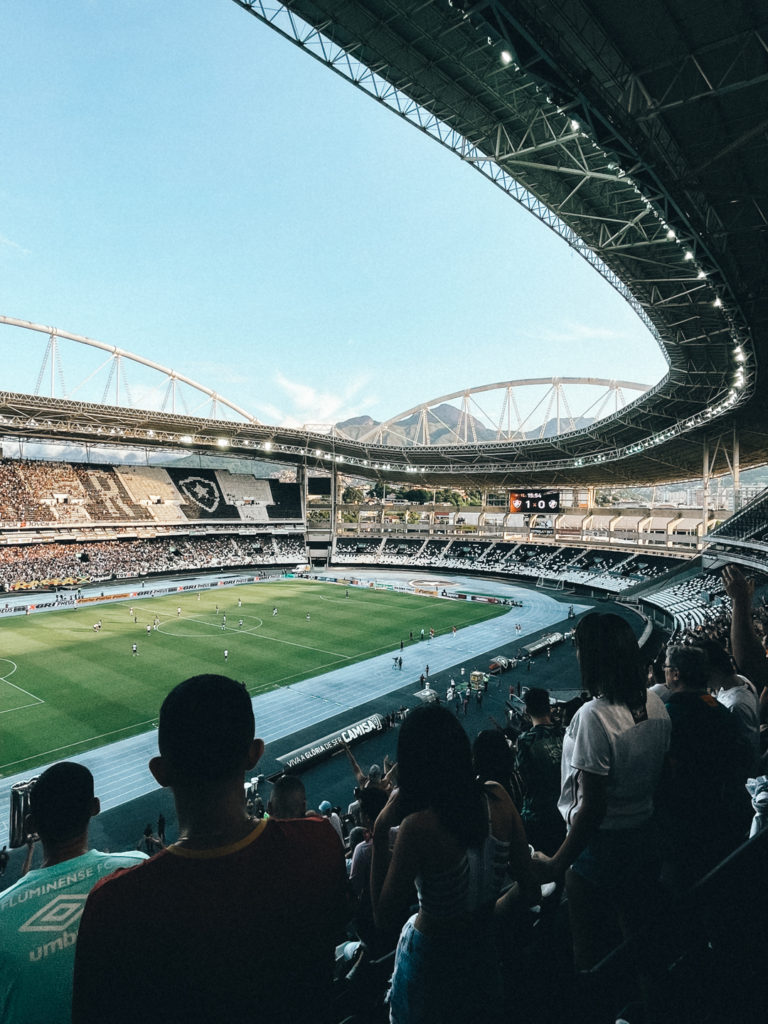
I’ve mentioned a lot in this blog post, but all of it will prove useful to staying safe in Brazil. Overall, I hope I didn’t scare any readers; I think Brazil is a wildly amazing place and one of my all-time favorite travel destinations. Just stay aware, stay safe and you’ll have a smooth and wonderful trip.
Also read: The Ultimate List of Things to Do in Rio
More resources for your trip to brazil:.
Planning your own trip? Here’s everything I used to book and coordinate my itinerary through Brazil.
If you’re a budget traveler or looking for an easy way to meet others, Hostelworld is the best place to search.
Booking.com has so many options in Brazil from affordable to more luxurious stays.
Flights to Brazil and within Brazil can be pricey if not booked ahead of time. To get the best prices I recommend using Skyscanner . The cheapest airport to fly into will most likely be São Paulo, but if visiting Rio de Janeiro it’s worth it to fly directly there.
No matter the destination, I always check Rome2Rio to see options on how to travel. However I found using Brazilian bus companies to book could be a pain because you need a CPF often. The most useful sites to me were BusBud & FlixBus .
Travel insurance is a must for every trip, and I highly recommend it for Brazil. My go to is always WorldNomads which is made for backpackers. You can search for coverage here .
Tours & Experiences
There’s a lot of free thing to do in Rio but joining a tour does have its advantages, and if you’re a solo traveler looking to meet people then tours are a great option. In Rio you can find awesome experiences on GetYourGuide , Viator , & Airbnb Experiences (hit or miss but mostly good).
Liked this post? Pin it!
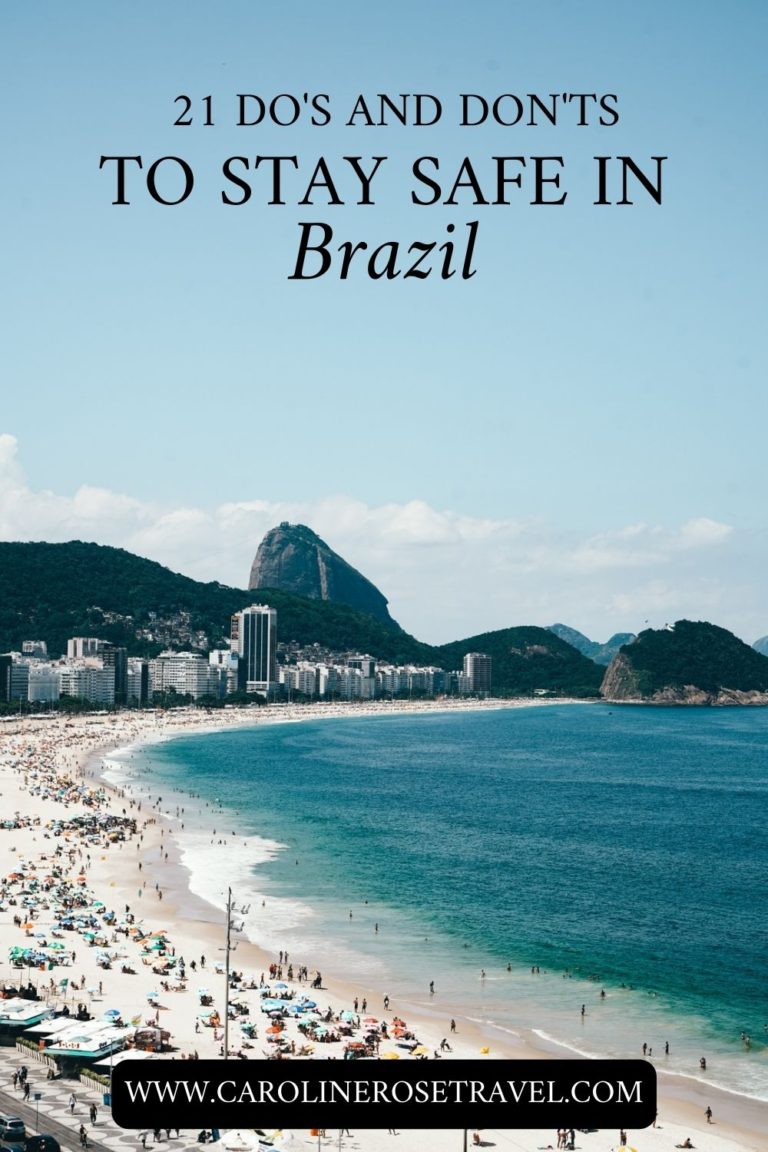
Related posts

Carnival Rio de Janeiro 2024: Your Guide to the World’s Largest Party
Carnaval in Rio de Janeiro is one of the world’s biggest parties! Brazilians in costumes dance in th...

21 Dos and Don’ts to Travel Safe in Brazil
When I mention that I traveled to Brazil (majority of the time alone) one of the first questions I a...

The Ultimate List of Things to Do in Rio de Janeiro
Rio de Janeiro is one of the most amazing cities to visit in the world. It’s one of the few......
Bea Adventurous
I’ve heard a rio can be bad with theft so these tips are really helpful so thank you! I definitely think it shouldn’t deter anyone from visiting but to take these precautions for sure! Thanks Caroline!
Caroline Rose
You’re welcome!! So glad you found these helpful. Have the best time in Brazil!
Mary Candler
Thanks for your information about Brazil. I am hoping to go to Rio to volunteer as a English teacher for 3 weeks then head to Minas Gerais to see a friend. Any specific comments for a 70 Yr old who doesn’t take too many risks and has done a fair amount of solo travelling. I’ll be staying in medium hotels when not in the volunteer programme.
Hi Mary! I don’t have any specific safety recommendations other than what I’ve listed here. As for things to do, there are some really great tours I think you’d enjoy like to Christ the Redeemer and Sugar loaf mountain. Also check out the botanical garden, it’s beautiful! I have a full list of things to do in this blog post!
David Young
So how do you take photos? I love taking photos with my phone when I’m traveling. It sounds like that would be risky at most outdoor locations in Brazil. Also how was intercity travel? Did you take buses or fly? I know not to take the bus at nighttime, but I wonder if there are other precautions advised. Thank you.
Save my name, email, and website in this browser for the next time I comment.
Subscribe me to Caroline Rose Travel
This site uses Akismet to reduce spam. Learn how your comment data is processed .

Matador Original Series
At first glimpse, São Paulo appears to be little more than a bustling financial center. Dig deeper and you will find this city of 20 million people is so much more than that. Between the skyscrapers and the suits lies a city full of life and exploding with culture. From hole-in-the-wall bars to swanky rooftop restaurants, fascinating art galleries to a soccer museum, São Paulo has something for everyone. This concrete jungle sparks memories of New York, and yet this buzzing metropolis is so often overlooked by those passing through Brazil. This ultimate city guide is here to show you why this irrepressible mega-city should be on your travel bucket list, and to help you make the most of São Paulo during your time here.
When to visit São Paulo depends on what you want to get out of your time there. The summer months (December-February) can get pretty hot, with highs sometimes reaching 95 degrees Fahrenheit, but generally hovering between 82-86 degrees Fahrenheit. São Paulo’s summer months are also the city’s rainiest, although you’ll soon learn that rain showers often last no longer than 15 minutes before the sun comes back out – so the trick is to always carry an umbrella. Winter in São Paulo (June-September) usually brings more comfortable temperatures that range from 63-77 degrees Fahrenheit, and tends to be significantly drier than the summer months. This makes the winter months the high season in São Paulo. If you want to avoid the crowds as well as the high temperatures, we recommend visiting from March to May, as these months also see little rain and temperatures are still comfortable at around 68 degrees Fahrenheit.
Brazil’s currency is the Brazilian real (BRL), and the exchange rate is R$5.25 per 1 USD. Generally, in bars and restaurants in São Paulo, a 10 percent service charge is added to the bill, meaning your tip’s already included. It’s generally optional to pay it, although it’s frowned upon to not do so unless you’ve had poor service. One exception to the 10 percent rule is lanchonetes , cheap diner-style restaurants where there’s generally no service charge – leaving it up to you whether or not to tip. In hotels, I would advise tipping the bellhop around 10 reais for helping with your luggage, and tipping housekeeping around five reais per day. It’s not common to tip taxi drivers, although it is helpful to round up fares to the nearest real to save having to count out change. Tour guides tend to suggest an optional tip at the end of a tour, and, depending on the length of the tour, 15-30 reais would generally be appreciated.
Portuguese is the official language of Brazil, but as São Paulo is such a large and modern city, it’s not uncommon to find English speakers in bars, restaurants, and shops in the more touristy areas, and most tour guides will have some English-speaking ability. However, an attempt at using some basic Portuguese will never go amiss, so make sure to have a translation app handy. Also, here are some basic phrases to help set you off on the right track:
- “Olá” – “Hello”
- “Oi” – “Hi” (informal)
- “Por favor” – “Please”
- “Obrigado/a” – “Thank you” (gender specific – “o” ending is masculine, “a” ending is feminine)
- “Moço/a” – Used to attract the attention of a waiter/waitress (gender specific, endings same as above)
- “A conta, por favor.” – “The bill, please.”
- “Voçe fala inglês?” – “Do you speak English?”
- “Onde fica o metrô?” – “Where is the subway?”
- “Quanto é?” – “How much is it?”
- “Como se chega a...?” – “How do you get to...?”
- “E aí!” – Informal way to greet a friend
- “Valeu” – “Thanks”
- “Saúde!” – “Cheers!”
- “Desculpa?” – “Sorry?/Excuse me?” (used when asking someone to repeat themselves in a polite way)
- “ Com licença” – “Excuse me”
- “Preciso de ajuda.” – “I need help.”
São Paulo is enormous, so it can seem a little confusing to work out how to get around it at first. Luckily, it has a well-established transport system, the most efficient of which is the Metro and CPTM (overground train) network. The Metro is open Sunday-Friday from 4:40 AM until midnight, and Saturdays from 4:40 AM until 1:00 AM. A single ticket costs four reais and can be bought at any station across the city. A single ticket also allows you to change between subway lines and CPTM lines at no extra charge (with very few exceptions) in order to reach your destination. It’s advisable to watch your belongings on both systems, and to try and avoid using them during peak rush hour times (7:00 AM-8:30 AM and 5:30 PM-7:30 PM).
There’s also an extensive bus network, with the cost of a bus ticket being around four reais. Buses, however, have to deal with the city’s maddening traffic, so are often irregular and unreliable. During rainy times, long lines for the buses, as well as for the Metro and CPTM, lead to overcrowding and delays. If you’re staying in São Paulo for a longer period, it could be worth buying a Bilhete Único, a rechargeable travel card available from the main stations, as this saves time buying tickets and also allows you to get several buses, trains, and subways within a period of a few hours for no extra cost.
To travel in a quieter and more comfortable manner, opt for Uber or 99. Both are apps from which you can call a cab to your location. 99 is often cheaper than Uber, so it’s worth doing a price comparison between the two before booking. However, as with São Paulo’s buses, Ubers and 99s face the problem of traffic, so your journey can end up taking far longer than you expected. It’s important to leave more than enough time to get to your destination if choosing this transportation option.
If you want to fit some exercise into your day-to-day life, bikes are available for rental, with pick-up and drop-off points spread throughout the city. São Paulo is becoming more bike-friendly, and several bike lanes have opened in recent years. However, it’s critical to watch out for the heavy traffic flow to stay safe while cycling. On Sundays, Avenida Paulista, one of the main roads in the city, is closed off to cars to enable cyclists and pedestrians to roam freely along the road. Stalls and musical acts also line the street each Sunday.
Brazil is often painted as an incredibly dangerous country, but it can be perfectly safe, as long as you act sensibly and responsibly. In São Paulo, pickpocketing is not uncommon, especially on the Metro, so you should always keep an eye on your belongings, particularly in crowded places. Don’t wear flashy jewelry and, if you’ve got a backpack, wear it in front of you while on public transportation.
The touristy areas of São Paulo are, on the whole, safe for you to wander around by yourself or in a group in daylight, but it’s always sensible to remain alert. At night, try and stay in groups and catch Ubers or 99s if you're traveling longer distances, and stay away from unknown areas, particularly areas that aren’t popular with tourists. It’s in the Brazilian nature to be friendly and helpful, so don’t be afraid to approach people for help or strike up a conversation with someone you meet in a bar or on a tour.
Neighborhoods
Where to stay, art and culture, events and festivals, where to eat, bars and nightlife, nature and parks, itineraries, essential são paulo: day one, essential são paulo: day two, essential são paulo: day three, editors' picks, 8 sweet, fruity, and savory brazilian desserts you need in your life.
Thank us later.
How to Experience the Best of Japanese Culture in São Paulo
It’s more places than you’d expect.
Brazil's New President Is a Threat to the Environment. Here’s What You Can Do About It.
Don’t boycott Brazil. Go there.
The Top 9 Street Food Dishes of São Paulo and Where to Find Them
Food + drink, 5 delicious ways to use cassava, brazil’s most versatile food, 10 mouthwatering cheesy, fried, and savory snacks from brazil, budget travel, 14+ free things to do on your next trip to brazil, the best cities in south america to travel by bike, cities in brazil.
We use cookies for analytics tracking and advertising from our partners.
For more information read our privacy policy .
We've detected unusual activity from your computer network
To continue, please click the box below to let us know you're not a robot.
Why did this happen?
Please make sure your browser supports JavaScript and cookies and that you are not blocking them from loading. For more information you can review our Terms of Service and Cookie Policy .
For inquiries related to this message please contact our support team and provide the reference ID below.

IMAGES
VIDEO
COMMENTS
Brazil - safety as a country. São Paulo, the largest city in Brazil has a city population of 11 million and even more than 20 million in the metropolitan region. Many immigrants used to be attracted to this incredible city, so it is one of the most diverse cities in the world. Sao Paulo is the capital of rich people, nightlife and culture.
6 Essential Adventure Travel Safety Tips for Brazil. ... Also most people in Sao Paulo do NOT own a car. Reply. Kevin said 5 years ago "Places far from the city center, like Pari, Perdizes and Lapa and most of the poorer neighborhoods, like Campo Limpo, Vila Clementino and Capão Redondo should be avoided because they can be dangerous." ...
15 Top Safety Tips for Traveling in São Paulo. Know the different neighborhoods - this is one of the most important tips. Avoid places like Capão Redondo, Lapa, Pari, and Campo Limpo. But do your own research before you arrive! Avoid the poor districts - the poorer the district, the more unsafe it is.
Safety Facts about Sao Paulo, Brazil. Sao Paulo is a big city and not all areas are safe. When it comes to traveling by metro, for example, the green line is usually the safest and both the blue and red lines should be taken with more caution. Numbeo shows that the crime index is 70.37, which is quite high but keep in mind such statistics ...
Is Sao Paulo Airport Safe. Sao Paulo Guarulhos Airport has been certified with the 3-Star COVID-19 Airport Safety Rating as a result of increased safety measures and hygiene improvements implemented to reduce Coronavirus exposure. Sao Paulo is a Brazilian city in the southeast region of the country. In terms of population, it is Brazil's most ...
Sao Paulo has one of the most famous (and delicious) gastronomy scenes in the world, known for both its fine dining and street food. Regional dishes from all over Brazil, from the moqueca (seafood stew) of the north to the meaty farofa-topped barreado of the south, can be found here. Bite into a warm, crunchy coxinha full of shredded chicken ...
Transport Safety. Navigating a megacity like São Paulo can be overwhelming, especially for first-time visitors. Understanding the public transport system, which includes buses, trains and the metro, is essential for safe and efficient travel. The main metro lines are relatively safe, and so are the train lines that serve the main tourist sites.
São Paulo Travel Guide. Last Updated: February 6, 2024. A lot of travelers skip São Paulo when visiting Brazil, choosing to go to Rio de Janeiro and other parts of the country instead. This sprawling metropolis shouldn't be skipped. Originally inhabited by the indigenous Tupi people, Portuguese Jesuit priests colonized the area in 1554.
Traffic. Sao Paulo is a lively city. Traffic is always busy, so bring your patience. If you're brave enough to rent a car, drive with caution. The locals are aggressive and they won't wait for ...
São Paulo's international airport has seen roughly 15 million arrivals and departures in the last nine months, a jump of 85.7% year-over-year but still 38.5% below pre-Covid levels. For those ...
Heavy rainfall. The rainy season runs from November until March in the south and south-east (including Rio de Janeiro - see Regional risks) and from April until July in the north-east of Brazil ...
Personal Safety Tips. While São Paulo is generally a safe city for tourists, it's always important to take personal safety precautions. Here are some tips to help ensure your safety during your visit: Stay Alert and Be Aware: Pay attention to your surroundings, especially in crowded areas or tourist attractions.
How to Travel (Safely + Solo) to Wonderful São Paulo. by Milagros Rojas. July 26, 2021. 6 minute read. São Paulo is the largest city in South America and it is the perfect example of a cosmopolitan city that manages to be beautiful and modern without losing its authenticity. You can see nature everywhere and that warm spirit is also shared by ...
Visiting a city as large as São Paulo has its pros and cons. The pro are there are tons of things to do and see, but the downside is many attractions are far away from the center. In most cases, you might need to take the bus and/or subway. Getting Around/ Public Transportation: As far as public transportation is concerned, the metro is the ...
Traveling to São Paulo as a solo female requires extra caution and awareness. The city has a moderate crime rate, and while violent crime against tourists is relatively rare, petty crime such as pickpocketing and mugging can occur. To minimize the risk of becoming a victim, avoid isolated areas, especially at night.
São Paulo is generally safe for tourists, but petty crime like pickpocketing and bag snatching is common, especially in crowded areas.Violent crime also occurs, so avoid isolated areas and use trusted transportation at night.Civil unrest with protests can disrupt travel plans. Remain vigilant and follow local advisories.Medical facilities are generally good, but insect-borne diseases like ...
Exercise increased caution in Brazil due to crime. Some areas have increased risk. Read the entire Travel Advisory. Do not travel to: Any areas within 150 km/100 miles of Brazil's land borders with Venezuela, Colombia, Peru, Bolivia, Guyana, Suriname, French Guiana, and Paraguay due to crime. (Note: This does not apply to the Foz do Iguacu ...
Uber is extremely popular and ridiculously cheap in Sao Paulo — far cheaper than taxis. Sao Paulo's system of six color-coded subway lines is easy, reliable, and safe. Buses are plentiful but tough to navigate if you don't know Portuguese. Stick to the subway or Uber in Sao Paulo. 3. Expecting natural beauty in Sao Paulo.
São Paulo Brazil: Quick Travel Tips Before You Go. 🛫 Airport: The best airport in São Paulo, Brazil, is called Guarulhos International Airport. Its airport code is GRU. 🤑 Currency: Brazilian Real, shown by the R$ symbol. 🗣️ Language: Portuguese, although English is common in tourist spots and in hotels.. 🕰️ Time Zone: Brasilia Standard Time (GMT-3).
The Best Time to Visit São Paulo. The best time to visit Sao Paulo is during Brazil's summer months, which run from December to March. This high season is when the city experiences pleasantly high temperatures, nice weather, and fully open amenities. The ideal time to visit Brazil is from December to March.
Vacation destinations like Fernanda do Noronha are also quite safe. However, even big cities like Sao Paulo and Rio de Janeiro, which have higher crime rates, are well-traveled, and as long as you follow the tips above and stay vigilant, you can stay safe while enjoying these incredible cities. *** Brazil is an amazing, vibrant country. But it ...
The metro in Sao Paulo and Rio de Janeiro are great. I took the metro in Rio many times and it was cheap, safe, and clean. However, I wouldn't recommend it in two scenarios: at night and with a laptop or camera. Otherwise I actually recommend it during the day especially if you're on a tight budget.
The touristy areas of São Paulo are, on the whole, safe for you to wander around by yourself or in a group in daylight, but it's always sensible to remain alert. At night, try and stay in groups and catch Ubers or 99s if you're traveling longer distances, and stay away from unknown areas, particularly areas that aren't popular with tourists.
Apply for Safety Spec/ fluency in reading/writing Japanese. job with Thermo Fisher Scientific in Remote, São Paulo, Brazil. Clinical Research jobs at Thermo Fisher Scientific
1:30. The controlling shareholder of Gol Linhas Aereas Inteligentes SA has started talks with Azul SA for a possible deal between the airlines. Holding company Abra Group Ltd seeks to "explore ...